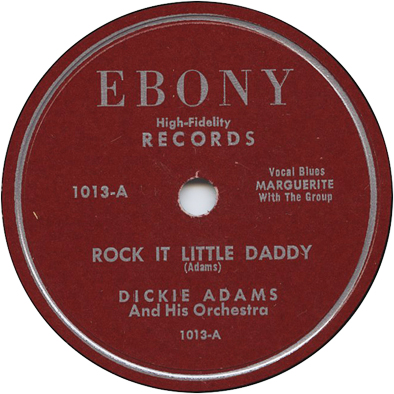

Revision note:Now that Dan Ferone has shown us photos of Queen 4101, we've realized it's by the Chubby Jackson Sextet. The same applies to Queen 4103, whose matrix numbers are adjacent to those on 4101. Discographies have cited these two singles as by Slim Gaillard, masked for release as "Slim Stewart." A fine mess... We have added information about Jack Cooley's activities for Chicago, 20th Century, and Ebony II. Now that we've seen a copy, we have moved "Harlem" 1040 by Huey Long to our Ebony IB listing (it's a red-label "Harlem Ebony Record" with "Ink, Inc." at the top of the label). One side of what may have been the real Harlem 1040, by Harry Dial, also made it onto Ebony 1040 (we'd still like to see Harlem 1040). Courtesy of the latest influx of rare 78s at archive.org, we have also added Harlem 1004 by Lil Palmore, a variant of Harlem 1012 (correctly credited to the Jubalaires; after lead vocalist J. C. Ginyard moved to the Dixieaires the labels on 1012 were changed), and Harlem 1023 by Tab Smith. We have added information on Chicago 110, by Sister Ann C. Graham, and Harlem 1013, by the Five Gospel Souls. We have added information on Chicago 109 by Brother John Sellers, the release that at long last gives us a continuous series from Chicago 100/101 through Chicago 119. We have added information about Harlem 1026 by the Famous Blue Jay Singers (with our thanks to Dan Ferone). We have added information about the late-period 45-rpm release on Ebony 1075. We have added information about both Harlem-derived Grant Jones singles on Decca, 48179 and 48192.
J. Mayo Williams, a retired record industry executive, struck out on his own in 1945, opening the Chicago (later Southern) and Harlem labels, adding an Ebony label for a time, and (maybe a little while later) opening Ebony Distributors. In 1947, he replaced the New York-based Ebony label with a tiny Chicago-based Ebony that did not carry the Harlem/Southern logo. Williams' New York distribution business was gone by the middle of 1948, and Southern went with it. Harlem, now based in Chicago, lasted until 1949. But Williams stuck with Ebony, which went through two further incarnations before issuing its last single in 1971-1972. Here we detail what is known about Williams' late 1940s operations. Our page continues with Ebony II (1952-1959) and finishes with Ebony III (1959-1972).
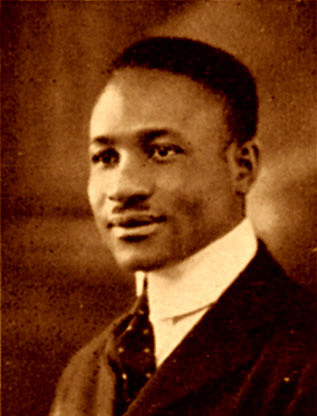
When he opened shop at Ebony, J. Mayo Williams had already been in the music business for over 20 years. He was born in Pine Bluff, Arkansas on July 26, 1893 (or July 25, 1894—both dates have been given). His father was murdered when he was seven, and the family moved to his mother's hometown, Monmouth, Illinois. Williams initially became known as an athlete. In 1912, he took the Illinois high school state championship in the 50-yard dash and placed second in the 100. His football prowess eventually got him a scholarship to Brown University, where he played in 1917, 1919, and 1920. After graduating in 1921, he played in the fledging National Football League through 1926, making all-pro in 1923. "Ink" Williams, as he was known in his playing days, was one of the first three African-American athletes to play in the NFL.
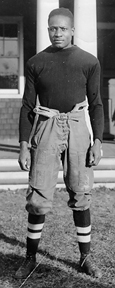
But it was in the music business that J. Mayo Williams would make the rest of his career. In 1924, he began working for Paramount in Chicago, as a producer and talent scout for the label's race series. He also ran the house publisher, Chicago Music. In 1927, he went independent, opening the Chicago Record Company with the Black Patti label, but it folded in six months and most Black Patti releases are major rarities today. Subsequently, he went to work for the Vocalion and Brunswick race music series, again running the house publishing company. When Decca emerged in 1934 from various mergers and consolidations, Williams was the head of the race department. During the years when Williams occupied this high-profile position, however, Decca was doing so little recording in Chicago that the studio was used as a storeroom several months out of the year.
Although Decca was already recovering from the World War II recording ban in 1944, Williams left the company at the beginning of 1945, setting up as a freelance producer and indepedent label entrepreneur. His main ventures were the Southern and Harlem labels, which he initially ran out of a New York office located at 307 Lenox Avenue. Most of his recording activity, especially during his first year of operation, took place in New York, although Williams was also doing some cutting in Chicago.
Williams also maintained a somewhat strangely named Chicago label (with "Harlem Series" right on the logo, and "The Southern Record Corporation" in small print). Initially the output of the Southern company actually carried this Chicago imprint. It appeared on 19 releases that we know about. After Chicago 100/101, the series ran consecutively from Chicago 102 through 119.
Below is our current listing of Chicago releases. Where we have been able to see the actual 78s, or know what was printed on the labels, there is verbose copy of the sort that Mayo Williams went for—and there are side designations. (The piece by the unknown gospel group was erroneously subsituted for the correct A side on some copies of Chicago 106.) No doubt additions and corrections are still required...
The memorial tributes to Franklin D. Roosevelt (such as C-19, and N-9 and 10) look like immediate responses to the president's death on April 12, 1945. Williams' New York recordings in the N-500 series appear to have begun earlier. The Horsecollar Wiliams session (N-549 and 550) is dated January or February 1945 in Tom Lord's Jazz Discography. These sides featured a combo with the leader on alto sax, Jesse Drakes (trumpet); Joe Evans (alto sax); John Hartzfield (tenor sax); Duke Jordan (piano); Gene Ramey (bass); J. C. Heard (drums); and Etta Jones (vocals). Williams may well have started right up in January; in any event 1945 would be his biggest year in the studio.
Many of the Chicago-label releases were recorded in different New York studios, as signaled by the N, IN, and N-500 matrix series. Those actually made in Chicago carried a C- prefix.
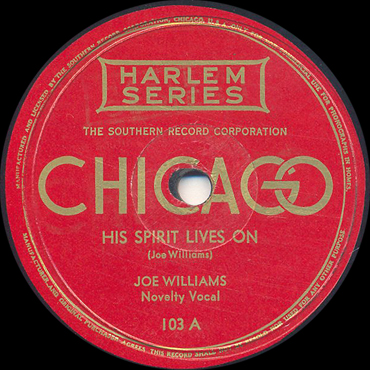
Among the sides recorded in Chicago were the first two to be released, on Chicago 100/101. Ann Sorter McCoy's title, "Tell It to the O. P. A.," a reference to the World War II price-fixing bureaucracy, is one of many indications that Williams was busily stockpiling sides while the war was still on. The James McCain side is said by Fancourt and McGrath to have been made in Chicago, with Memphis Slim accompanying on piano; its flip, by bluesman Big Joe Williams accompanied by one Clfford Dinwiddie on washboard, was also done in the Windy City. On the Lee Brown sides, the pianist was joined by Baby Face Leroy Foster on barely audible guitar, Ernest "Big" Crawford on bass, Oliver Alcorn on tenor sax, and very possibly Leroy Foster also working the drum pedals.
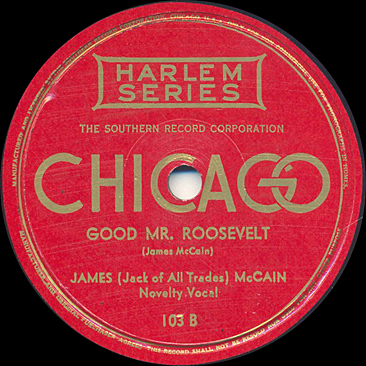
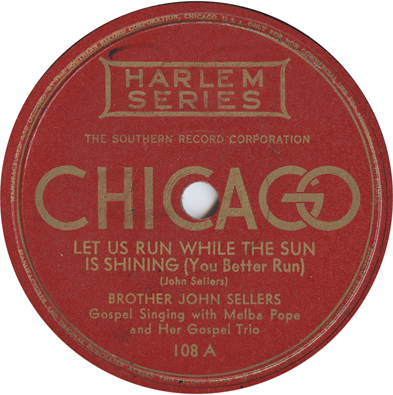
According to Hayes and Laughlin, the sides by John Sellers were done in Chicago in May 1945, but given the presence of N-500 numbers on two sides we aren't buying the Chicago bit. Sellers recorded with the Melba Pope Trio (Melba Pope, piano; Huey Long or Johnny Johns, guitar; and Allan Lott, bass), a New York-based group whose appearances were advertised in the Amsterdam News. Both gospel and secular titles were included. The known blues sides that Sellers made for Williams carry IN and UN suffixes, indicating other dates in other New York studios. One of these appeared on Southern 128 and two on Queen 4114. Finally, two gospel sides from one of his 1945 sessions ended up in the hands of Decca after a transaction in early 1950 (see below). Sellers would go on to record in Chicago for Miracle, Victor, King, and Chance, among other labels.
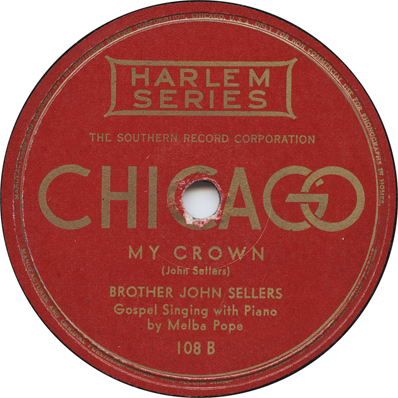
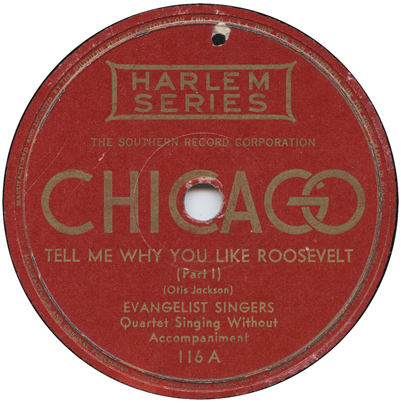
Williams had a strong interest in gospel, which he would retain throughout his years as an indie entrepeneur. Among the groups he recorded in New York were the Evangelist Singers, who were entrusted with one of his Roosevelt tributes. "Tell Me Why You Like Roosevelt" extends over two sides, albeit with some stretching (the section on General Benjamin O. Davis gets repeated).
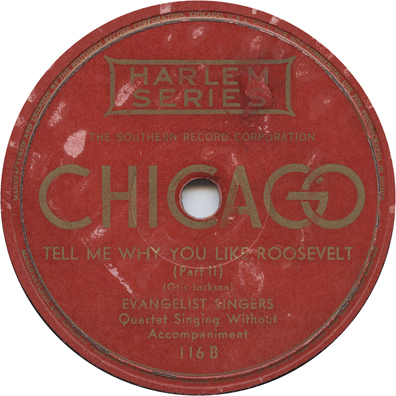
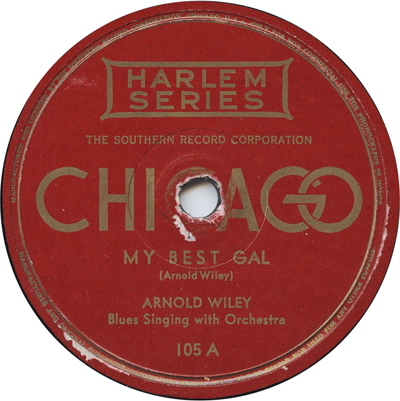
Among those done without question in New York were two by Arnold "Doc" Wiley's combo, featuring Wiley on piano, Skippy Williams on clarinet and tenor sax; Eddie Gibbs on guitar; John Brown on bass; and George Turner on guitar. Wiley, whose basic style went back to the 1920s, would resurface on Apollo (recorded in New York in 1947), but is best known today for the marathon recording session he did in Detroit for Sensation toward the end of that year (see our Vitacoustic page).
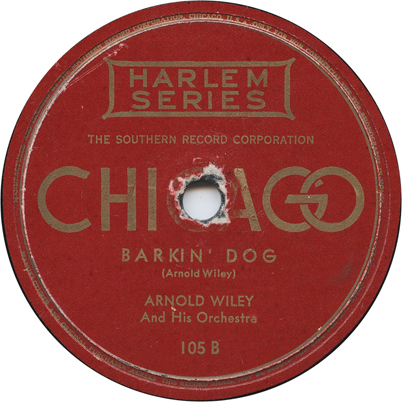
Another definite New York session produced the two sides by Swing tenor saxophonist Teddy McRae and his band, which were released on Chicago 106. Both sides, "Pluggin' Jane" and "To Satisfy You," were songs being plugged by a brand new publishing company, Perry Alexander Music, in an advertisement in Billboard in January. Williams must have dealt promptly for them, putting the session among his earliest. According to Lord's Jazz Discography, McRae's band included Pete Clark on alto sax and Kenny Kersey at the piano. A second session in December 1945, featuring the Palmer Brothers (aka the Cabaliers), produced two sides that were released on Queen 4122 in July 1946. Yes, one was titled "C-I-N-C-I-N-N-A-T-I", but one still wonders whether Mayo Williams played a role. McRae's only other recordings as a leader were made in New York in the 1950s; these were R&B sides featuring "Mr. Bear" as the lead vocalist, while McRae also played a little baritone sax. He cut three singles in 1955 for RCA's Groove subsidiary, with backing by top studio musicians. A final single came out around 1958 on a New York-based label called AMP. As Mr. Bear, he also appeared on at least one session for King in the late 1950s, and in the early 1960s led the studio band for a small New York label called Rae-Cox, which he might have owned a piece of.
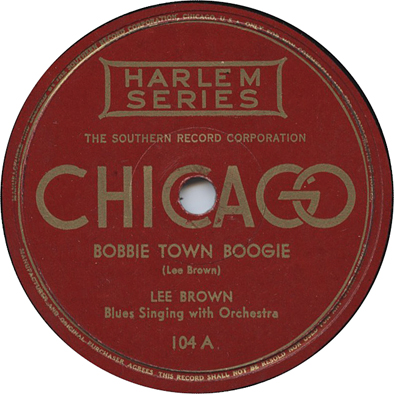
| Matrix number | Artist | Title | Release | Recording Date | Release Date |
| C-16 | Ann Sorter McCoy | Vocal Blues with Trio | Tell It to the O. P. A. | Chicago 100 A | 1945 | 1945 |
| C-14 | Jack Cooley And His Cooley Boys | Vocal Blues | Time to Think | Chicago 101 B | 1945 | 1945 |
| N-550 | Horse Collar Williams And His Orchestra | Vocal Ensemble | How Ya Like That | Chicago 102 A | Jan.-Feb.1945 | 1945 |
| N-549 | Horse Collar Williams And His Orchestra | Vocal Blues by Etta Jones | You Ain't Nothin' Daddy | Chicago 102 B | Jan.-Feb. 1945 | 1945 |
| C-50 | Joe Williams | Novelty Vocal | His Spirit Lives On | Chicago 103 A | 1945 | 1945 |
| C-19 | James (Jack of All Trades) McCain | Novelty Vocal | Good Mr. Roosevelt | Chicago 103 B | April 1945 | 1945 |
| C-11 | Lee Brown | Blues Singing with Orchestra | Bobbie Town Boogie | Chicago 104 A | 1945 | 1945 |
| C-12 | Lee Brown | Blues Singing with Orchestra | My Little Girl Blues | Chicago 104 B | 1945 | 1945 |
| N-542 | Arnold Wiley | Blues Singing with Orchestra | My Best Gal | Chicago 105 A | 1945 | 1945 |
| N-543 | Arnold Wiley And HIs Orchestra | Barkin' Dog | Chicago 105 B | 1945 | 1945 |
| N-11 | Teddy McRae And His Orchestra | Vocal, Three Barons | Pluggin' Jane | Chicago 106 A | 1945 | 1945 |
| [unidentified male gospel group] | [unidentified title] | Chicago 106 A | |||
| N-12 | Teddy McRae And His Orchestra | Vocal, Rene Collins & Three Barons | To Satisfy You | Chicago 106 B | 1945 | 1945 |
| N-568 | Laurence "88" Keyes | Vocal Blues with Orchestra | Throw It Out of Your Mind | Chicago 107 A | c. May 1945 | 1945 |
| N-569 | Laurence "88" Keyes | Vocal Blues with Orchestra | Up to Date Blues | Chicago 107 B | c. May 1945 | 1945 |
| N-570 | Brother John Sellers | Gospel Singing with Melba Pope and Her Gospel Trio | Let Us Run While the Sun Is Shining (You Better Run) | Chicago 108 A | May 1945 | 1945 |
| N-574 | Brother John Sellers | Gospel Singing with Piano by Melba Pope | My Crown | Chicago 108 B | May 1945 | 1945 |
| N-572 | Brother John Sellers | Gospel Singing with Melba Pope and Her Gospel Trio | I Had a Dream Last Night | Chicago 109 A | May 1945 | 1945 |
| N-571 | Brother John Sellers | Gospel Singing with Melba Pope and Her Gospel Trio | What a Friend We Have in Jesus | Chicago 109 B | May 1945 | 1945 |
| N-2 | Sister Ann C. Graham And Her Gospel Trio | Put the Whole Armour [sic] On | Chicago 110 B | early 1945 | 1945 |
| N-3 | Sister Ann C. Graham And Her Gospel Trio | You Better Do Right | Chicago 110 A | early 1945 | 1945 |
| N540 | Vicki Graham | Blues Singing with Nelson's New Orleans Trio | New Meat | Chicago 111 A | c. January 1945 | 1945 |
| N539 | Vicki Graham | Blues Singing with Nelson's New Orleans Trio | Swingaroo | Chicago 111 B | c. January 1945 | 1945 |
| N-562 | Melba Pope And Her Village Trio | Vocal Blues | That's the Stuff You Gotta Watch | Chicago 112 A | c. April 1945 | 1945 |
| N-563 | Melba Pope And Her Village Trio | Vocal - Torch | I'm Carrying a Torch for You | Chicago 112-B | c. April 1945 | 1945 |
| N-566 | The Mack Sisters | Trio Singing with Orchestra | I Love That Carrying On | Chicago 113 A | c. May 1945 | 1945 |
| N-567 | The Mack Sisters | Trio Singing with Orchestra | Gin and Cocoanut Water | Chicago 113 B | c. May 1945 | 1945 |
| N-21 | Alan Nurse and His Orchestra | I Love to Read the Funnies | Chicago 114 A | c. April 1945 | 1945 |
| N535 | George Shaw and His Orchestra | Pushin' 'Em Up | Chicago 114 B | c. January 1945 | 1945 |
| N5 | Betty Thornton And Trio | I Don't Want the World | Chicago 115 A | early 1945 | January 1946 |
| N6 | Betty Thornton And Trio | Something Strange Has Happened | Chicago 115 B | early 1945 | January 1946 |
| N-9 | Evangelist Singers | Quartet Singing Without Accompaniment | Tell Me Why You Like Roosevelt (Part I) | Chicago 116 A | April 1945 | 1945 |
| N-10 | Evangelist Singers | Quartet Singing Without Accompaniment | Tell Me Why You Like Roosevelt (Part II) | Chicago 116 B | April 1945 | 1945 |
| N-16 | Dossie "Georgia Boy" Terry | Blues Singing with Melba Pope's Blues Boys | The O. P. A. Blues | Chicago 117 A | 1945 | 1945 |
| N-15 | Dossie "Georgia Boy" Terry | Blues Singing with Melba Pope's Blues Boys | Furlough Blues | Chicago 117 B | 1945 | 1945 |
| The Evangelist Singers | Brand New | Chicago 118 | |||
| The Evangelist Singers | The Lord Will Make a Way | Chicago 118 | |||
| IN-66 | Georgia Boy Terry And Melba Pope's Trio | Doretha Doretha Boogie | Chicago 119 | 1945 | 1946 |
| IN-67 | Georgia Boy Terry And Melba Pope's Trio | Whiskey Head Woman | Chicago 119 | 1945 | 1946 |
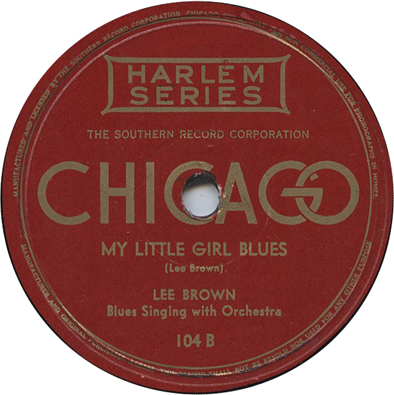
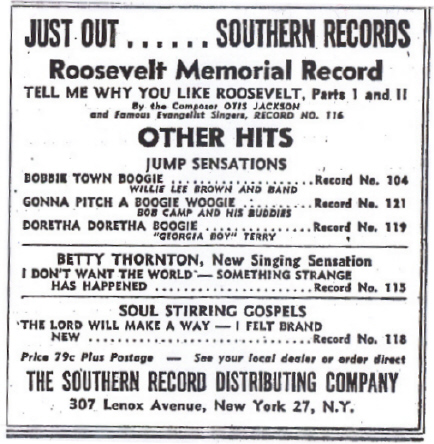
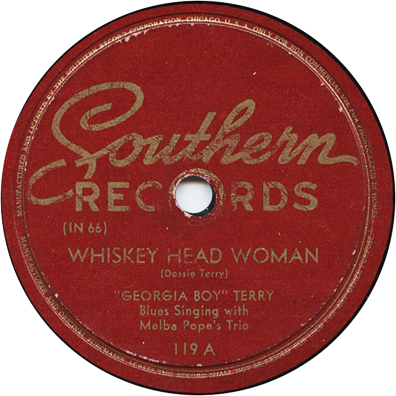
The Chicago label used a 100 series that ran through 119, at which point the baton was passed to the Southern imprint. (Better documentation of the transition would, of course, be nice). 119, by Blues singer Dossie "Georgia Boy" Terry with the omnipresent Melba Pope Trio, has been listed as both a Chicago and a Southern release. Both labels referred (in the fine print around the rim) to the Southern Record Company, whose location was given as Chicago. We presently know of 14 releases on Southern.
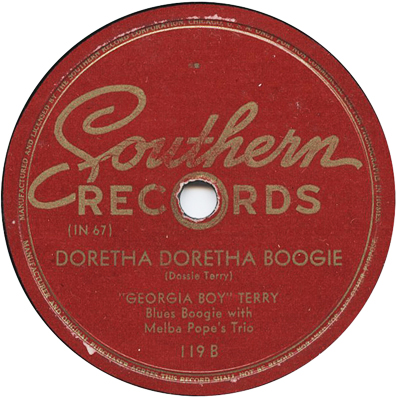
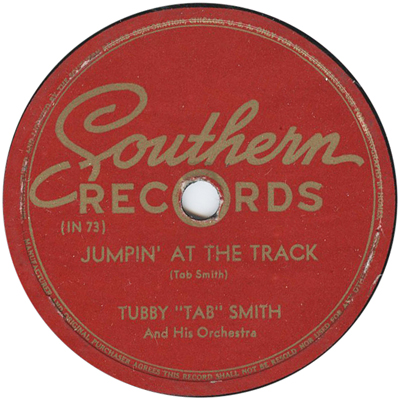
Prominent among the artists featured on Southern was alto saxophonist Tab Smith. Born in Kinston, North Carolina in 1909, Smith was already a veteran of the Lucky Millinder and Count Basie bands when he estblished a jump combo in New York City, which began recording in 1944. In fact, two of his four recording sessions that year were done for Decca when Mayo Williams was still with the company. Smith cut twice for Mayo Williams's company. The first session, around August 1945, was done with a combo (piano, guitar, bass, and drums) and eventually led to two releases on the Harlem label. Smith played some tenor saxophone on it. The second, around September 1945, was done with a big band and led to releases on Southern.. There were two sides done in obvious emulation of Basie ("Jumpin' at the Track" was a close relation to "One O'Clock Jump," while "Morning Blues" featured the leader's vocals) and two more featuring singer Roebie Kirk.
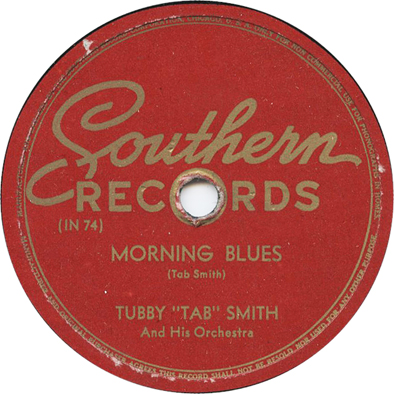
Southern seems to have wrapped up its recording activities in 1947. The last known release, Southern 134, was by veteran Swing musician Harry Dial (although Dial was a drummer, he stuck to singing on this date) and his combo (Reuben Reeves, tumpet; Henry Jones, clarinet and alto sax; Earres Prince, piano; Olin Aderhold, bass; and Ted Fields, drums). According to Lord's Jazz Discography, which supplied the personnel, the session took place in New York around February 1947. "I Like What I Like like I Like It," credited to Dial and Mayo Williams, was a remake of a recording that Dial's combo made in Chicago for Vocalion, all the way back in 1930. The session was Dial's second for Williams' operation: Harlem 1035 and 1040, along with one side of Ebony 1040, include four sides from a Dial session in the UN matrix series. It ran to 8 sides in all (see below for two that Williams later dealt to Decca) and appears to be from 1945.
| Matrix number | Artist | Title | Release | Recording date | Release date |
| IN 66 | Dossie "Georgia Boy" Terry | Blues Singing with Melba Pope's Trio | Whiskey Head Woman | Southern 119 A | 1945 | 1946 |
| IN 67 | Dossie "Georgia Boy" Terry | Blues Boogie with Melba Pope's Trio | Doretha Doretha Boogie | Southern 119 B | 1945 | 1946 |
| Steve Samuels' Calypso Band | Honey Bunny | Southern 120 | |||
| Steve Samuels' Calypso Band | Stop Shaking That Thing | Southern 120 | |||
| C-2 | Bob Camp and His Buddies | Gonna Pitch a Boogie | Southern 121 | 1945 | |
| C-3 | Bob Camp and His Buddies | Blues Mixture | Southern 121 | 1945 | |
| UN-28 | Little Four | Quartet Singing with Haynes Trio | Don't Forget To Be True | Southern 122 B | 1945 | |
| UN-29 | Little Four | Quartet Singing with Haynes Trio | Tee-U-Eee | Southern 122 | 1945 | |
| Alan Nurse Blues Band | Jelly Shakin' Blues | Southern 123 | |||
| Alan Nurse Blues Band | Bye Bye Mary | Southern 123 | |||
| IN-71 | Tubby "Tab" Smith And His Orchestra | Joy at the Savoy | Southern 124 | c. September 1945 | 1946 |
| IN-72 | Tubby "Tab" Smith And His Orchestra | Keep Right on Doin' | Southern 124 | c. September 1945 | 1946 |
| IN 73 | Tubby "Tab" Smith And His Orchestra | Jumpin' at the Track | Southern 125 | c. September 1945 | 1946 |
| IN 74 | Tubby "Tab" Smith And His Orchestra | Morning Blues | Southern 125 | c. September 1945 | 1946 |
| Bill Campbell | Vocal Baby Dee | I Like to Ride | Southern 126 | |||
| Bill Campbell | Vocal Baby Dee | I'm Gonna Make Him Love Me | Southern 126 | |||
| IN-126 | Ray Dars | After Hours | Southern 127 | ||
| Ray Dars | Everybody's Doing the Zig Zag | Southern 127 | |||
| IN-115 | Big Johnny Sellers | Shorty Come Out from Under My Bed | Southern 128 | ||
| Melba Pope Trio | [unidentified title] | Southern 128 | |||
| C-4 | Bob Camp and His Buddies | Without Your Love | Southern 130 | 1945 | |
| C-1 | Bob Camp and His Buddies | Lonely (And Longing for You) | Southern 130 | 1945 | |
| Brother John Sellers | He Came All the Way Down | Southern 132 | 1945 | ||
| Brother John Sellers | Bye and Bye | Southern 132 | 1945 | ||
| Rev. John Schell Jr. | Going to Heaven | Southern 133 | |||
| Rev. John Schell Jr. | What Are They Doing | Southern 133 | |||
| IN-158 | Harry Dial and his Blusicians | I Like What I Like like I Like It | Southern 134 | c. February 1947 | 1947 |
| IN-159 | Harry Dial and his Blusicians | Wedding Day Blues | Southern 134 | c. February 1947 | 1947 |
The first Ebony operation, under the Southern Record Company umbrella, was the most modest of the four, and releases on it are unusually rare today. There were 6 (at most) of these Ebonys, in a 100 series that in the past has been mislisted by discographers (ourselves included) as a Harlem 100 series. Ebony IA, as we'll call it, doesn't appear to have done any recording past the end of 1945, when the imprint was mothballed.
We are still learning about Ebony 1A releases, and further corrections to our list will no doubt follow. For instance, in emulation of existing sources we used to list an Ebony 100 by the Four Tones ("What A Fool I Was" b/w "Two Hearts Beat Tonight") as the first in this series. However, it turns out the Four Tones recorded for a different Ebony label—in Los Angeles, in December 1940. "What a Fool" was composed by Otis René and "Two Hearts" by Shelton Brooks—they were this Ebony label's co-owners. (Our thanks to Tony Fournier for pointing this out to us, in his email of February 23, 2014.) We are skeptical of the Ebony 101 by Buddy Thompson (the "other" 101 by Johnny's Rhythmites carries matrix numbers from a series that Mayo Williams used), but will keep it on our list for now, as we know too little about it.
According to Hayes and Laughton's Gospel Discography, the Shelly Quartette was an unaccompanied male vocal group. H and L give Spring 1945 as the date (about right) and Chicago as the location (which is ruled out by the UN prefix to the matrix number). They also give UN19 as the matrix number for "Looking for My Jesus"—it was UN 17. "Looking for My Jesus" was reissued on King, well after any other Harlem-Southern-Chicago material of which we are aware. It appeared on King 4298, as by the "Shelley Quartet" in November 1948, at which time it was assigned a new matrix number, 5636.
The Shelly Quartette recorded one other time: one single, at an unknown date, for a label called Val-ue.
The Tom Fletcher Ebony is listed in Fancourt and McGrath's Blues Discography. No matrix numbers, location given as New York, date as c. 1948 (which is too late for an Ebony IA). Fletcher's only other release, which may not be coincidental, was on Decca in 1950.
| Matrix number | Artist | Title | Release | Recording date | Release date |
| Buddy Thompson | It's Your Eyes That Hypnotized | Ebony 101 | |||
| Buddy Thompson | God's Country USA | Ebony 101 | |||
| UN-1 | Johnny's Rhythmites | Vocal Paul Johnson | Look Out Jack | Ebony 101 [sic] | 1945 | |
| UN-2 | Johnny's Rhythmites | Vocal Paul Johnson | The Worse Woman Blues | Ebony 101 [sic] | 1945 | |
| Viola Watkins and the Honey Drips | Somebody's Somebody | Ebony 102 | |||
| Viola Watkins and the Honey Drips | I Guess I'm Not the Type | Ebony 102 | |||
| UN 17 | The Shelly Quartette | Looking for My Jesus | Ebony 103 | Spring 1945 | |
| UN 18 | The Shelly Quartette | I Love the Name Jesus | Ebony 103 | Spring 1945 | |
| UN-87 | Tab Smith | If You Don't | Ebony 104 | c. November 1945 | 1946 |
| UN-91 | Tab Smith | On the Jersey Side | Ebony 104 | c. November 1945 | 1946 |
| Tom Fletcher and His Music | Late Hours | Ebony 105 | |||
| Tom Fletcher and His Music | He's a Cousin of Mine | Ebony 105 |
The Harlem operation was a good deal more ambitious than Ebony IA, with 26 releases in a 1000 series. The label lasted long enough to go through 4 variants with gold print on a red background, plus a gold on purple variant of the second gold on red pattern.
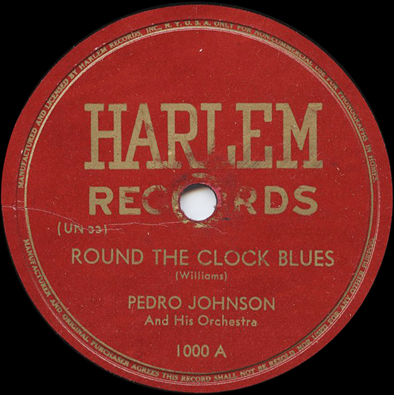
The first two artists in the Harlem 1000 series were, er, familiar to Williams from his previous employment. Buddy Johnson's band, featuring Ella Johnson on vocals, was scoring hits for Decca in 1944 and 1945. However, there was a hiatus of over a year between Johnson's Decca session in 1944 and the follow-up in 1945, and this gave Williams room to move in. Moonlighting as Pedro, Buddy Johnson, whose name at birth was Woodrow Wilson Johnson, took on "Round the Clock Blues," a much-emulated number since Joe Williams had cut it for the Cincinnati label in the fall of 1944. At Buddy Johson's leisurely tempo, leaving room for a guitar solo, two sides of a 78 were just enough to get him to 7 o'clock. The other two sides from this session featured Ella Johnson, using her real name because she was not under separate contract to Decca.
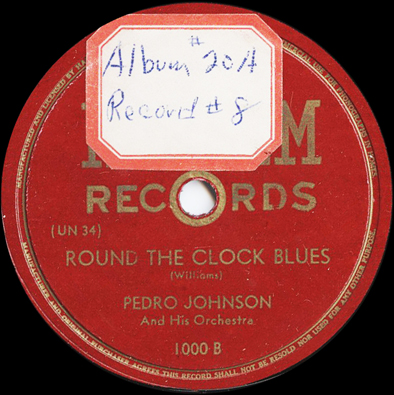
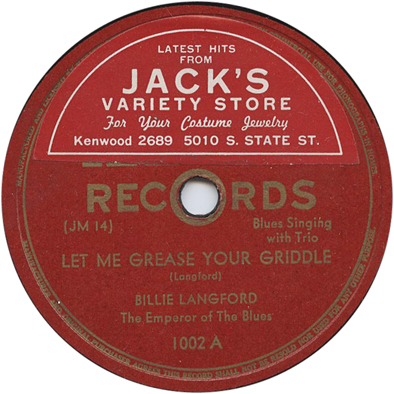
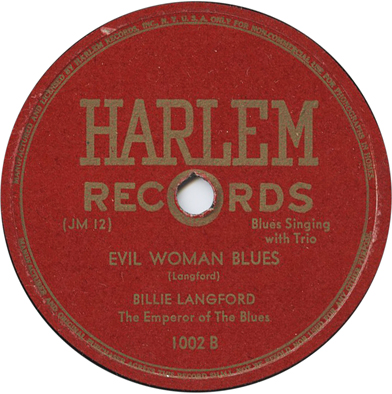
Among the other New York-based artists featured in the 1000 series were uptown blues shouter Billie Langford and female vocalists Muriel Nichols and Betty Thornton. The decision to pair Nichols and Thornton (who were accompanied by the same Swing combo) on Harlem 1003 was curious, to say the least. Even curiouser was the decision to pass Nichols off as another singer.
According to research by Rob Ford, Muriel Nichols was probably born in Philadelphia in 1908. She worked as a singer and dancer, first in Philadelphia clubs (the Amsterdam News reports her working with the Eddie Hill band at the Goldfield Grill in South Phill, March 20, 1937). By 1940 or so she had moved to New York City, where she would be mentioned on occasion in the Amsterdam News. For instance, Muriel Nichols or "Nicholas" appeared in 1951 at the Mayfair Lounge on West 125th; billed as "rhythm queen," she was appearing in a package show with backing from the Teddy Smalls Trio (Amsterdam News, March 3, 1951). She continued to receive occasional mentions in the Amsterdam News into the early 1950s.
So why was she (on what appears to have been her only commercial recording) billed as Muriel (Bea Booze) Nichols?
The real Wee Bea Booze was born Beatrice Booze, in Baltimore, Maryland, on March 23, 1912; she played the tenor guitar, and her brothers Eddie and Charles both played piano professionally. Growing up in Baltimore, she was signed by Decca in 1942, on Lionel Hampton's recommendation; the company apparently was looking for a blues singer to compete with Lil Green on Victor. Her opportunities to record were limited, because of the ban that hit on August 1 of that year, but she did have time to lay down a memorable performance of "See See Rider" with Sammy Price on piano. After the war, she recorded for Decca again on January 3, 1946 (doing one vocal with Andy Kirk's band). Otherwise, she cut four sides for Apollo in May 1950. Retired from the scene for many years, Bea Booze died in Scottsville, New York in November 1986 (our thanks to Winne Freyer, Rob Ford, and Bob Eagle for finally identifying when she was born and when she died; see the Baltimore Afro-American, March 7, 1942, and posts at the Real Blues Forum by Rob Ford and Bob Eagle, February 26-March 1, 2014).
Williams knew Bea Booze from his days at Decca, and obviously would have liked to get her to record for him, but apparently she was unavailable or uninterested (we very much doubt that Decca had signed her to a multiyear contract). So he had Muriel Nichols (who despite her heavier voice could do a very good impression of Bea Booze) to do a knockoff of Booze's "See See Rider." Where the Decca's near-funereal tempo harked back to the 1920s, Williams brought in a Swing combo (with a somewhat lumbering tenor saxophonist, a steel guitar soloist, piano, bass, and drums) for accompaniment at a somewhat brighter pace. If Muriel Nichols made anything else at the session, we suspect it has been lost.
Mayo Williams' bit of subterfuge had many people (including the authors of the liner notes to a 1996 Delmark reissue of her Apollo sides—and ourselves, till very recently) supposing that Harlem 1003 A was by Bea Booze, whose real name was Muriel Nichols. In fact, 7-year-old Beatrice Booze from Baltmore had been on the 1920 US Census rolls all along.
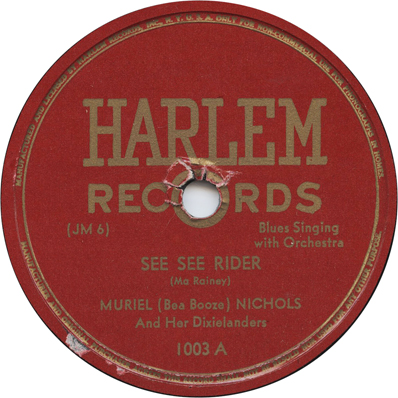
The other side of Harlem 1003 belonged (for real) to Betty Thornton, a contralto singer, nearly down in Ma Rainey territory, who played piano. "I Love You After All" is lugubrious, despite the attempt by the "Dixielanders" to give some lift. Thornton made two more tracks for Williams, also early in the history of his operation, which appeared on Chicago 115. These were made at a different session with the then-typical piano-guitar-bass lineup. We'll assume she played the piano herself. Both sides of Chicago 115 are droopy ballads, of no particular distinction, that her uninflected, vibrato-less delivery makes especially hard to listen to. All the same, Williams took out a rare ad in Billboard in support of the release (January 12, 1946, p. 22; the ad indicates some kind of alliance between his Southern Record Company and Regis, which was based in New Jersey.) In 1946, Thornton made two 4-pocket albums for the Joe Davis label, Nice Songs for Naughty People and Songs They Don't Sing in School. The latter, at least, was made with white jazz musicians, such as Phil Napoleon and Hank D'Amico, who had radio network jobs at the time and also did a lot of session work for jazz-oriented indies; a photo of her and this band at the Joe Davis session, appearing in the Chicago Defender for November 2, 1946, noted that she had attended the Hampton Institute and was singing and playing piano at the Hotel Sutton. The Joe Davis albums appear to have been better suited to her talents. (Our thanks to Rob Ford and Big Joe Louis for their research on Betty Thornton, and to Robert Javors and Konrad Nowakowski for more information on Chicago 115.)
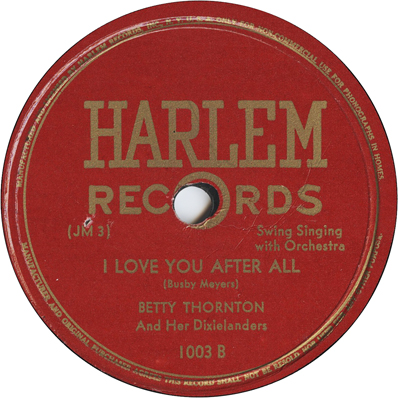
Bill Campbell, whose band was responsible for Harlem 1010, was a New York-based pianist who led combos. 1946 was his year, as far as recording opportunities went: he also appeared on DeLuxe, with his Harlem Eight and singer Thelma Cooper, and in November he recorded for Apollo, with the same vocalist, Baby Dee, who was featured on his Harlem. Baby Dee, whose real name was Delores Spriggs, went on to cut a session for Sonora in February 1947. The band is uncredited on her Sonora release that we have seen, but Bill Campbell was the composer on both sides. Bill Campbell's band with Baby Dee continued to tour through 1950; Baby Dee would resurface as a solo act on MGM in 1954, without Bill Campbell, and on some smaller labels in the late 1950s, with Bill Campbell.
Among instrumentalists, Williams was especially eager to record alto saxophonist Tab Smith. (We used to think, as other discographers have previously, that the sides with the BEL matrix numbers came from a Southern California independent called Bel-Tone. We've learned that until close to the end of Bel-Tone's run, its matrix numbers were prefixed with a BT, not a BEL. Meanwhile, there was a Beltone Studio in New York City.) Some sides by Tab Smith were cut at Beltone. Drummer Harry Dial, a veteran of the jazz scene, contributed on the R and B side.
Williams recorded several gospel singers and ensembles in New York. Most notable were the Jubalaires and The Five Gospel Souls. The Five Gospel Souls were, in fact, The Soul Stirrers, a quintet that had made two sides for Bronze in 1945, then began recording in earnest for Aladdin, around May of 1946. The Soul Stirrers under contract to Aladdin when Williams recorded them, hence the faint disguise. Although the group recorded in Chicago for Aladdin, the matrix series on the sides they made for Williams are from New York City. According to Hayes and Laughton, the Soul Stirrers who recorded for Williams were Robert H. Harris and Senior Roy Crain (tenors); James Heywood Medlock, Thomas L. Bruster, and R. B. Robinson (baritones); and Jesse James Farley (bass), working unaccompanied. They recorded 6 sides, two of which were initially released on 20th Century. We disagree with Hayes and Laughton about the recording date, which they put in 1945; IN 165 through 169 are far enough into that matrix series to put the session around the beginning of 1947.
While most Harlem releases originated in New York City, there was Chicago-based product in the mix. Gospel-wise, there were two celebrated releases by the Famous Blue Jay Singers, one of the great groups from the golden age of gospel.
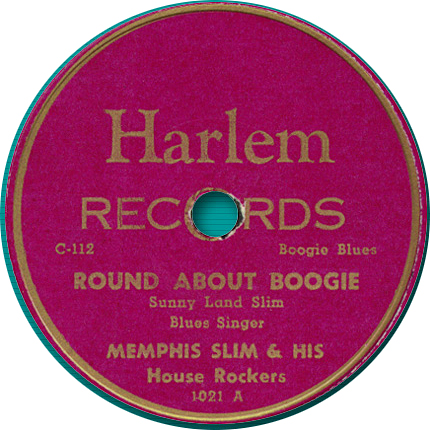
On the blues side, there was the legendarily enigmatic "Round About Boogie," recorded in Chicago in 1946 and wrongly attributed on the label to a Memphis Slim combo with Sunnyland Slim singing. Williams had used Memphis Slim as an accompanist for James "Jack of All Trades" McCain in 1945, but if he ever recorded Memphis Slim as a leader or recorded anything at all on Sunnyland Slim, it never saw release and has disappeared without a trace. "Round About" is in fact the recorded debut of bluesman Jimmy Rogers, singing and playing his first instrument, the harmonica. The accompaniment is by Lee Brown on piano, Alex Atkins on alto sax, probably Big Crawford on bass, possibly Leroy Foster on drums. The other side, "Bobbie Town Woogie," was by Lee Brown with a different lineup. Alex Atkins is on alto sax, and Leroy Foster is definitely playing the guitar on it. This is a different version, of what was supposed to be titled "Barber Town Woogie," from the one that Williams had previously released on Chicago 104. The record did not come to the attention of blues collectors until nearly 50 years after its release, when the late George Paulus began spreading the word about it.
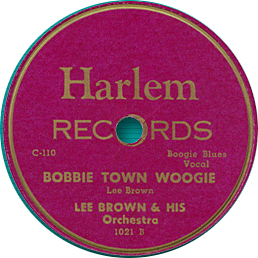
"Round About Boogie" is also distinctive for appearing on a purple Harlem label, otherwise known only from Harlem 1020, a single by a New York-based female vocalist, Ollie Potter. The Ollie Potter single features a seriously raunchy novelty number, about the "fish man" who makes a home delivery of "too much eel."
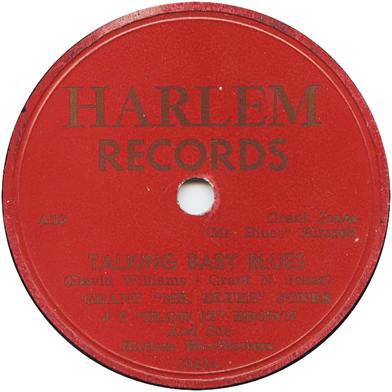
Among the other blues recordings that the company did in Chicago were a series of probably 10 sides by J. T. Brown and his blues band. Those released on Harlem feature a new style of label. Grant "Mr. Blues" Jones was one of the guest vocalists on the session. When these sides were made, in the first quarter of 1949, Williams had closed down his New York office. Ebony Distributors, which handled Miracle in the early going, lost the Miracle account in November 1947. We wonder if the distributor was already on the way out, because by then it had been several months since Williams had done any recording in New York. In January 1948, Billboard was still giving the 307 Lenox Avenue address for Southern Record Company (Juke Box supplement, January 24, 1948, p. 9); how much longer it was occupied?
Only two of the five releases from the J. T. Brown sessions came out on Harlem. Another release appeared only on Apex, two others only on Decca. Decca 48179 and 48192 are said to have been cut in New York on September 13, 1950, but this was almost certainly when Decca mastered the sides after buying them from Williams. Decca 48179 was reviewed in Cash Box on November 11, 1950, p. 18; 48192 (which Decca put on 45 rpm as well as 78, which could make it the only single from the Harlem/Ebony I period to see release on 45), appeared in May 1951 (advertised in Cash Box, June 2, 1951, p. 19).
For a hot minute Williams was also trying a new distribution deal, with Jim Bulleit, who was moving from Bullet Records into the distribution end of the business.
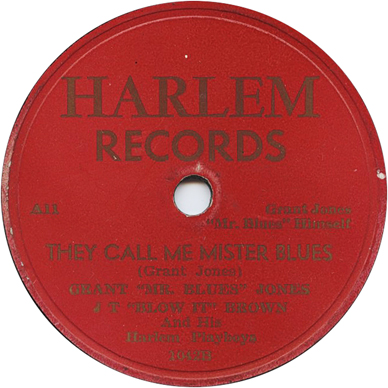
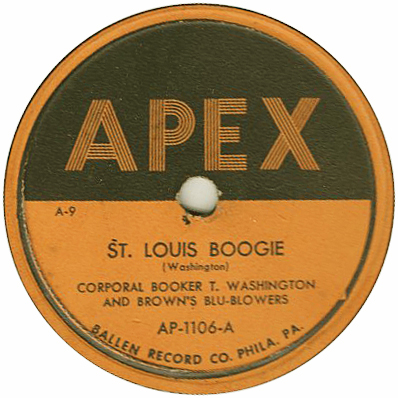
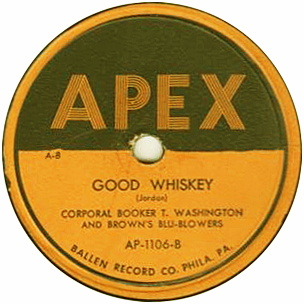
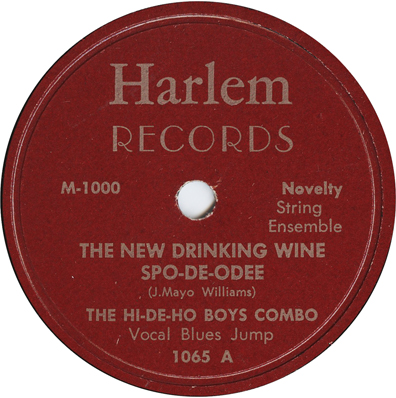
After the last release off the J. T. Brown session, there would be one more on Harlem 1065, with one last change of label style. Harlem 1065 was made in Chicago with the Hi-De-Ho Boys, a string ensemble that remained ensconced at the Club DeLisa until May 1950. Williams had recorded an early version of the group for Decca, all the way back in 1936. The 1949-1950 edition of the group consisted of Lefty Bates and Wilbur Wynne on guitars along with a third guitarist and a string bass player. One of the Hi-De-Ho sides was a cover of "Drinking Wine Spo-De-Odee"; Mayo Wiliams was trying once again to cash in on the hit version that had appeared on Atlantic.
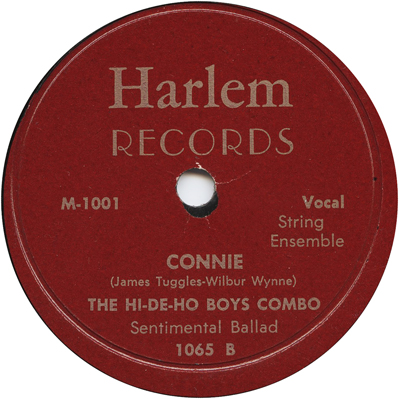
| Matrix number | Artist | Title | Release | Recording Date | Release Date |
| UN-33 | Pedro Johnson And His Orchestra | Round the Clock Blues | Harlem 1000 A | 1945 | 1945 |
| UN-34 | Pedro Johnson And His Orchestra | Round the Clock Blues | Harlem 1000 B | 1945 | 1945 |
| UN-35 | Ella Johnson | Darling Baby | Harlem 1001 A | 1945 | 1945 |
| UN-36 | Ella Johnson | Since You Went Away | Harlem 1001 B | 1945 | 1945 |
| JM 12 | Billie Langford | The Emperor of the Blues | Blues Singing with Trio | Evil Woman Blues | Harlem 1002 A | 1945 | 1945 |
| JM 14 | Billie Langford | The Emperor of the Blues | Blues Singing with Trio | Let Me Grease Your Griddle | Harlem 1002 B | 1945 | 1945 |
| JM 6 | Muriel (Bea Booze) Nichols [sic] And Her Dixielanders | Blues Singing with Orchestra | See See Rider | Harlem 1003 A | 1945 | 1945 |
| JM 3 | Betty Thornton And Her Dixielanders | Swing Singing with Orchestra | I Love You After All | Harlem 1003 B | 1945 | 1945 |
| C 104 | Lil "Caldonia" Palmore | Blues Singing with Trio | I Believe I Believe (I'll Go Back Home) | Harlem 1004 A | 1946 | 1946 |
| C 105 | Lil "Caldonia" Palmore | Blues Singing with Trio | Come Back to Me | Harlem 1004 B | 1946 | 1946 |
| Tubby "Tab" Smith And His Orchestra | Vocal Roebie Kirk | Romance Time | Harlem 1008 A | |||
| UN-88 | Tubby "Tab" Smith And His Orchestra | Tabs Saxophone Disertation [sic] | Tab's Purple Heart | Harlem 1008 B | c. November 1945 | 1946 |
| IN-131 | Bill Campbell And His Harlem Band with Vocalizing Baby Dee | It Was So Good | Harlem 1010 A | 1946 | 1946 |
| IN-132 | Bill Campbell And His Harlem Band with Vocalizing Baby Dee | Got a Man in My System | Harlem 1010 B | 1946 | 1946 |
| IN-143 | Bill Johnson And His Musical Notes | Vocal: Gus Gordon | Don't You Think I Ought to Know | Harlem 1011-A | 1946 | 1946 |
| IN-142 | Bill Johnson And His Musical Notes | Stuff in D Flat | Harlem 1011-B | 1946 | 1946 |
| UN-88 | Tubby "Tab" Smith And His Orchestra | Tabs Saxophone Disertation [sic] | Purple Heart | Harlem 1008 B [the B side for some copies of 1011-A (!)] |
c. November 1945 | 1946 |
| H-102 | The Jubalaires | Gospel Singing with Piano The Dixieaires | Gospel Singing with Music |
Well Done! Well Done! Well Done, Well Done |
Harlem 1012-A | c. January 1947 | |
| H-101 | The Jubalaires | Gospel Singing with Piano The Dixieaires | Gospel Singing with Music |
Gabriel Sound Your Trumpet | Harlem 1012-B | c. January 1947 | |
| IN-168 | The Five Gospel Souls [The Soul Stirrers] | Gospel Singing Without Accompaniment | His Eye Is on the Sparrow | Harlem 1013 A | 1947 | |
| IN-167 | The Five Gospel Souls [The Soul Stirrers] | Gospel Singing Without Accompaniment | This Friend of Mine | Harlem 1013 B | 1947 | |
| IN-150 | Sister Elizabeth Eustice with Melba Pope's Trio | He Knows My Heart | Harlem 1015 | December 1946 | |
| IN-149 | Sister Elizabeth Eustice with Melba Pope's Trio | I'll Let Nothing Separate Me from the Lord | Harlem 1015 | December 1946 | |
| Senaca Blues Singers | Sugar Stomp Blues | Harlem 1017 | 1947 | ||
| Senaca Blues Singers | Black Market Blues | Harlem 1017 | 1947 | ||
| 16B | "Stick" McGhee and His Buddy | Drinkin' Wine Spo-Dee-O-Dee | Harlem 1018A | 1947 | 1947 |
| C-3 | Bob Camp | Blues Mixture | Harlem 1018B | 1945 | 1947 |
| H-110 | Ollie Potter And Her After Hours Orchestra | Too Much E-E-L | Harlem 1020A | 1947 | 1947 |
| H-108 | Ollie Potter And Her Buck Eye Boys | Big Fat Dollar Bill | Harlem 1020B | 1947 | 1947 |
| C-112 | Memphis Slim & His House Rockers | Sunny Land Slim Blues Singer [Jimmy Rogers] | Round About Boogie | Harlem 1021A | 1946 | 1946 |
| C-110 | Lee Brown & His Orchestra | Bobbie Town Woogie | Harlem 1021B | 1946 | 1946 |
| BEL-16 | Tab Smith & His Orchestra | Vocals: Tab Smith and Riff Washington | Believe Me When I Tell You | Harlem 1022 A | c. August 1945 | |
| BEL-17 | Tab Smith & His Orchestra with Riff Washington | Unforgettable Blues | Harlem 1022 B | c. August 1945 | |
| BEL-15 [sic] | Tab Smith & His Orchestra | Granny Dodging at the Savoy | Harlem 1023 A | c. August 1945 | |
| BEL-19 | Roebie Kirk with Tab Smith's Orchestra | So This Must Be Love | Harlem 1023 B | c. August 1945 | |
| BEL-18 | Roebie Kirk with Tab Smith's Orchestra | Don't Want to Play in the Kitchen (Let's Go Upstairs) | Harlem 1024 A | c. August 1945 | |
| BEL-15 | Roebie Kirk with Tab Smith's Orchestra | Roebie's Blues | Harlem 1024 B | c. August 1945 | |
| CHI-100 | The Famous Blue Jay Singers Of Birmingham, Ala. | Gospel Singing | There Is Plenty Good Room | Harlem 1026 B | January 1947 | 1947 |
| CHI-104 | The Famous Blue Jay Singers Of Birmingham, Ala. | Gospel Singing | I'm Standing on the Highway | Harlem 1026 A | January 1947 | 1947 |
| CHI-101 | The Famous Blue Jay Singers of Birmingham, Ala. | Gospel Singing | In the Upper Room | Harlem 1027 A | January 1947 | 1947 |
| CHI-102 | The Famous Blue Jay Singers of Birmingham, Ala. | Gospel Singing | I'm Bound for Canan Land | Harlem 1027 B | January 1947 | 1947 |
| UN-20 | Harry Dial | Broad Bottom Boogie | Harlem 1035 | 1945 | |
| UN-21 | Harry Dial | My Heart Says Yes But My Head Says No | Harlem 1035 | 1945 | |
| BEL-165 [sic] | The Five Gospel Souls | Sleep On Darling Mother | Harlem 1037 | 1947 | |
| BEL-169 [sic] | The Five Gospel Souls | One Moment in God's Kingdom | Harlem 1037 | 1947 | |
| UN-22 | Harry Dial | Don't Tell Me to Ugh-Ugh | Harlem 1040 | 1945 | |
| UN-23 | Harry Dial | I Know You're Lying | Harlem 1040 | 1945 | |
| A-9 | Corporal Booker T. Washington and Brown's Blu-Blowers | St. Louis Boogie | Apex 1106-A | Jan.-Mar. 1949 | 1949 |
| A-8 | Corporal Booker T. Washington and Brown's Blu-Blowers | Good Whiskey | Apex 1106-B | Jan.-Mar. 1949 | 1949 |
| A10 | Grant "Mr. Blues" Jones | J. T. "Blow It" Brown And His Harlem Blu-Blowers | Talking Baby Blues | Harlem 1042 A | Jan.-Mar. 1949 | April. 1949 |
| A11 | Grant "Mr. Blues" Jones | J. T. "Blow It" Brown And His Harlem Playboys | They Call Me Mister Blues | Harlem 1042 B | Jan.-Mar. 1949 | April 1949 |
| A-13 | J. T. "Blow It" Brown And His Blu-Blowers J.T. Brown and His Blu-Blowers* |
Black Jack Blues Blackjack Blues* |
Harlem 1044 A, Apex 1107-A* | Jan.-Mar. 1949 | 1949 |
| A-12 | J. T. "Blow It" Brown And His Harlem Blu-Blowers J.T. Brown and His Blu-Blowers* |
Brown's Bop Boogie Brown's Boogie* |
Harlem 1044 B, Apex 1107-B* | Jan.-Mar. 1949 | 1949 |
| 76868 | Grant "Mr. Blues" Jones with Brown's Blues Blowers | Night Time Is the Right Time | Decca 48179 | Jan.-Mar. 1949 | November 1950 |
| 76869 | Grant Jones with Brown's Blues Blowers | I'd Rather Drink Muddy Water (And Sleep in a Hollow Log) | Decca 48192 | Jan.-Mar. 1949 | May 1951 |
| 76870 | Grant Jones with Brown's Blues Blowers | When the Deal Goes Down | Decca 48192 | Jan.-Mar. 1949 | May 1951 |
| 76871 | Grant "Mr. Blues" Jones with Brown's Blues Blowers | Michigan Water Blues | Decca 48179 | Jan.-Mar. 1949 | November 1950 |
| M-1000 | The Hi-De-Ho Boys Combo | Vocal Blues Jump | The New Drinking Wine Spo-De-Odee | Harlem 1065 A | 1949 | 1950 |
| M-1001 | The Hi-De-Ho Boys Combo | Sentimental Ballad | Connie | Harlem 1065 B | 1949 | 1950 |
During the late 1940s, Williams was not fully in touch with musical trends in Chicago. He had the prescience to record Muddy Waters in 1946, but he didn't have enough prescience to use one of the bands that Muddy regularly played with. Instead, he chose to accompany Muddy's version of "Mean Red Spider" with alto sax, clarinet, and a piano that Muddy's biographer Robert Gordon has described as "ragtimey." (The record was subsequently dealt to 20th Century, one of the companies that Williams had a relationship with, then incorrectly issued under the name of the pianist, James "Sweet Lucy" Carter.) He didn't yet understand the blues style that recent Southern immigrants were bringing to Northern cities. Williams would catch up in time, compiling a much better track record in the early 1950s with such performers as Earl Dranes and Birmingham Junior.
Mayo Williams' peak year for recording activity was 1945, his very first in the business. The realities of recording and pressing expenses, of carrying inventory, and of running one's own distributor (for Williams, this was Ebony, out of New York City) or dealing with recalcitrant distributors operated by others, diminished the exuberance of many an indie label enterpreneur. He recorded much less in 1946, far less still in 1947. In Chicago the "recording ban" imposed by the American Federation of Musicians was effectively enforced during the first half of 1948, and flouted with caution during the fall. The ban killed off some local independents, including Hy-Tone and Gold Seal, and delivered a blow to RCA Victor and Columbia's "race" recording in Chicago from which these operations would never recover. Williams, however, seems to have had so little money to spend on new sessions that the ban made no difference to him. He was still standing in 1949—though he had closed his New York office—and he ended up recording even less than he had in 1947.
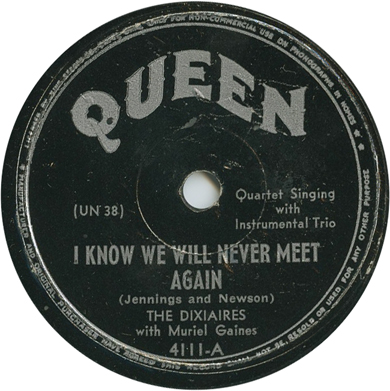
Mayo Williams' late-1940s enterprises went through several short-term partnerships with other independent labels that had more capital at their disposal or could offer better distribution.
Initially Williams had a lease arrangement with Syd Nathan of King Records; a fair amount of his 1945-1946 output actually came out on Nathan's "race" subsidary, Queen, and a couple more items would show up after Nathan, in September 1947, discontinued the separate label for "race" releases and consolidated everything on King. Around this same time, however, the deal was not renewed, leaving Williams to rely on Ivan Ballen's 20th Century operation, which he had begun collaborating with in February 1947 (later on, some of his masters appeared on Ballen's subsidiaries Apex and Gotham). However, Mayo Williams and Syd Nathan made another pact at the beginning of 1949, with scant results: just one single on King. According to Bill Daniels, on this occasion King bought or leased another 7 singles' worth of material from Williams, assigning King matrix numbers to each—and never issuing any.
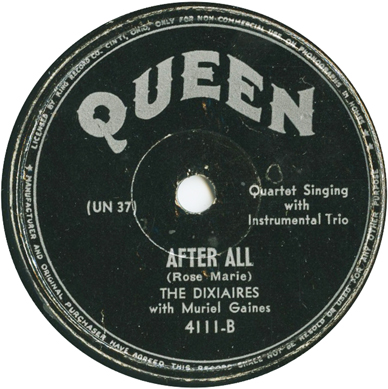
Some Queen releases carry the original matrix numbers from Williams' many series. By 1947 King had arrived at a consistent policy of attaching matrix numbers in its own K-5000 series to everything that appeared on the label, even when the sides had been bought or leased from someone else.
We have included the first four Slim Gaillard items (5004-5007) because Bill Daniels has documented that they were recorded in Chicago on July 1, 1944, before Mayo Williams had officially gone into business for himself. One wonders whether they were initially slated for release on the short-lived Cincinnati label. There was a lot of concealment: Slim Gaillard's name was changed to Slim Stewart; Gaillard's original titles were all changed; and we don't know who else was in the band besides bassist Chubby Jackson. To complicate matters, Queen 4101 (not one of the more common jazz 78s) has recently turned up with the tune titles and the matrix numbers that have been presented in discographies. Except the artist credit is to the Chubby Jackson Sextet, not to Slim Stewart. And personnel are given on the label: Neal Hefti, trumpet; Flip Phillips, tenor sax; Ralph Burns, piano; Billy Bauer, guitar; Dave Tough, drums. "I Gotcha' Covered" is credited to Jackson and "Popsie" to Flip Phillips. If Queen 4101 really had Slim Gaillard on it this can't be the correct personnel. It's possible that the July 1, 1944 session really did belong to Chubby Jackson and four Slim Gaillard titles that we show in brackets, if they are genuine, came from another session entirely. To sort out this rat's nest, we still need to hear Queen 4101 and see and hear Queen 4103.
The items that were given King matrix numbers 5008 through 5021 were all recorded in Los Angeles during September 1945; Mayo Williams didn't normally operate in Southern California, but all of the sides to see release appeared either on Queen or on 20th Century, which can't be an accident. According to Tom Lord's Jazz Discography, 5008 and 5009 were recorded by Karl George (trumpet); Vic Dickenson (trombone); Jewell Grant (alto sax); Fletcher Smith (piano); Slim Gaillard (electric guitar, piano, harpsichord, vocal); Tiny Bam Brown (bass); and Leo Watson drums; 5010-5013 were left to Gaillard (playing a lot of harpsichord) and the rhythm section. At a second session during the same month, Karl George and Howard McGhee (trumpets), Lucky Thompson, Teddy Edwards, and Wild Bill Moore (tenor saxes), Smith, Gaillard, Brown, and Watson were responsible for 5014-5017. At a third session, the rhythm section laid down 5018-5021. The ownership history of these sides has been unusually shadowy; many were reissued on Swingtime LP ST1018, which may also have been the first to put out 5013 and 5020.
We included the sides by bluesmen Johnny Temple and Jimmy Gordon because they were recorded in Chicago and Williams had ongoing relationships with both musicians (each had been an exclusive Decca artist and each had recorded in Chicago while he was with the company).
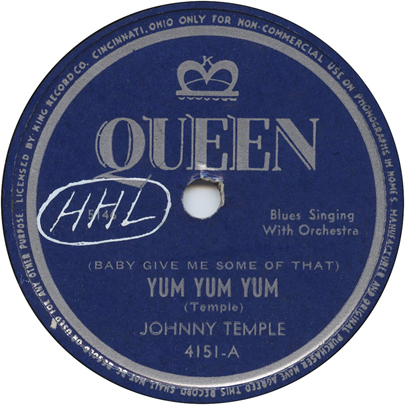
The Johnny Temple session came close to marathon proportions, but after the musicians were paid, little was heard of it for more than 50 years. Just one single materialized from it, on Queen 4151. The instrumentation (trumpet, tenor sax, piano, bass, and drums along with Temple's guitar) belongs to a jazz combo. Williams appears to have brought it in to accompany the bluesman. One of the released sides ("Yum Yum Yum") is a new version of the raggy number that Temple first waxed with the Harlem Hamfats. The sides recorded for Williams' company were strong musically, but would have have sounded quite dated to African-American record buyers in 1946. The masters were shelved in the King vaults, and none of the others would see the light of day until 2005, when they were finally included in a 4-CD set on Proper Records, Broke, Black, and Blue (Properbox 7).
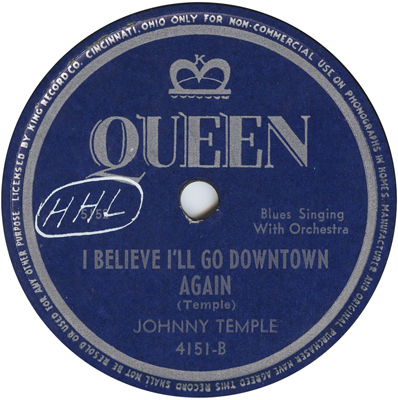
Jimmie Gordon also recorded extensively for Williams with a jazz combo. This could have been his actual band at Club Blue Flame, where he was ensconced during the period. Transitions in jazz styles were obliquely acknowledged in the titling (the Vip Vop Band was now the Bip Bop Band) though not in the playing. Two King singles materialized and everything else had to wait till 2005, when it was released as part of Properbox 7.
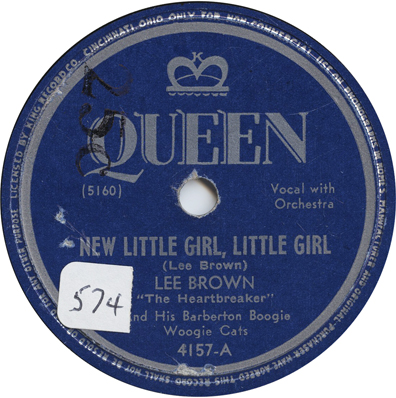
Meanwhile Lee Brown, Tab Smith, Harry Dial, and Teddy McRae had all released recordings on one of Williams' labels. One of the Harry Dial sides ("I Like What I Like like I Like It") also carries a co-composer credit to Mayo Williams. (In addition, saxophonist and bandleader Teddy McRae had a release on Queen 4122, supposedly recorded in Chicago on December 7, 1945. We have to wonder whether Williams had something to do with it.)
The Lee Brown sides, on which his band's name is finally spelled correctly, feature Alex Atkins on alto sax, Leroy Foster on guitar, Big Crawford on bass, and the leader on piano. Brown helpfully identified Foster and Crawford on "Brownie's Boogie." This is probably the same session that yielded the Lee Brown side of Harlem 1021 and the mysterious Jimmy Rogers side of the same disk; both sides of Chicago 104 featured an earlier band with Oliver Alcorn on tenor sax. The sides that Queen chose for release were never issued on Harlem, Chicago, or Southern, and the original matrix numbers are probably not recoverable at this date. However, it is known that four Lee Brown sides recorded by Wiliams were assigned matrix numbers K 5138 through 5141 (none of these were released at the time) and another four, consisting of the 2 sides issued on Queen and 2 that are still unissued, were recoded as K5160 through 5163.
We've listed the Lee Brown, Jimmie Gordon, and Johnny Temple sides that were dealt in a batch to King by their King matrix numbers. This does not put them in chronological order, so far as we know, but we can't think of a better way to present them (most were not released on Queen/King, so the release numbers don't do much for us here).
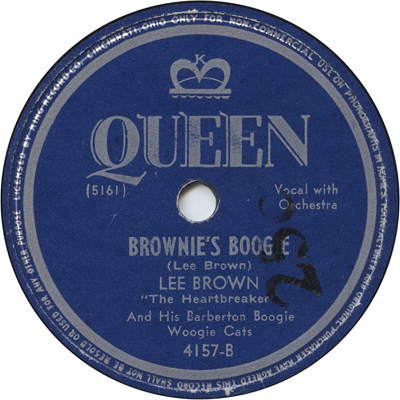
| Matrix number | Artist | Title | Release | Recording Date | Release Date |
| 5004 | Chubby Jackson Sextet | I Gotcha' Covered [House Rent Boogie] | Queen 4101A | July 1, 1944 | |
| 5005 | Chubby Jackson Sextet [sic] | Popsie [Early Morning Boogie] | Queen 4101B | July 1, 1944 | |
| 5006 | "Slim Stewart" | Bass Face [Central Ave. Boogie] | Queen 4103A | July 1, 1944 | |
| 5007 | "Slim Stewart" | Don't Get Too Wild Child [Sightseeing Boogie] | Queen 4103B | July 1, 1944 | |
| 5008 | Slim Gaillard and his Boogiereeners | Vout Orenee | Queen 4104 | September 1945 | |
| 5009 | Slim Gaillard and his Boogiereeners | Please Wait for Me | Queen 4104 | September 1945 | |
| 5010 | Slim Gaillard and his Boogiereeners | Sighing Boogie | Queen 4127 | September 1945 | |
| 5011 | Slim Gaillard and his Boogiereeners | Queen's Boogie | Queen 4159 | September 1945 | |
| 5012 | Slim Gaillard and his Boogiereeners | Voot Boogie | Queen 4159 | September 1945 | |
| 5013 | Slim Gaillard and his Boogiereeners | Nightmare Boogie | Queen (unissued) | September 1945 | |
| 5014 | Slim Gaillard and his Boogiereeners | Slim Gaillard's Boogie | Queen 4121 | September 1945 | |
| 5015 | Slim Gaillard and his Boogiereeners | Harlem Hunch | Queen 4127 | September 1945 | |
| 5016 | Slim Gaillard and his Boogiereeners | Tuitti Fruitti | (20th Century 20-10B) | September 1945 | (July 1946) |
| 5017 | Slim Gaillard and his Boogiereeners | Travelin' Blues | Queen 4121 | September 1945 | |
| 5018 | Slim Gaillard and his Boogiereeners | Sightseeing Boogie | Queen 4105 | September 1945 | |
| 5019 | Slim Gaillard and his Boogiereeners | Central Avenue Boogie | Queen 4105 | September 1945 | |
| 5020 | Slim Gaillard and his Boogiereeners | Boogie | Queen (unissued) | September 1945 | |
| 5021 | Slim Gaillard and his Boogiereeners | Slim's Cement Boogie | (20th Century 20-10A) | September 1945 | (July 1946) |
| IN-58 | Roebie Kirk with Tab Smith and His Orchestra | Where Is Your Husband At | Queen 4110 | c. September 1945 | March 1946 |
| IN-77 | Roebie Kirk with Tab Smith and His Orchestra | Let's Go Upstairs | Queen 4110 | c. September 1945 | March 1946 |
| UN-37 | The Dixiaires with Muriel Gaines | Quartet Singing with Instrumental Trio | After All | Queen 4111-B | 1945 | March 1946 |
| UN-38 | The Dixiaires with Muriel Gaines | Quartet Singing with Instrumental Trio | I Know We Will Never Meet Again | Queen 4111-A | 1945 | March 1946 |
| UN-12 | David Green with Melba Pope Trio | Jodie-Jodie Blues | Queen 4113-A | 1945 | April 1946 |
| UN-11 | David Green with Melba Pope Trio | Why Should I Love You | Queen 4113-B | 1945 | April 1946 |
| UN-23 | Brother John Sellers | Mirror Blues | Queen 4114 | 1945 | April 1946 |
| UN-30 | Brother John Sellers | Rockin' Mama Blues | Queen 4114 | 1945 | April 1946 |
| UN-13 | Stella Green | Worried Blues | Queen 4118 | 1945 | June 1946 |
| UN-14 | Stella Green | Downhearted Blues | Queen 4118 | 1945 | June 1946 |
| IN-99 5056 |
Teddy McRae and his Zanzibar Orchestra | Vocal by Nita Bradley | Lover | Queen 4122-A | December 7, 1945 | July 1946 |
| IN-? 5055 |
Teddy McRae and his Zanzibar Orchestra | Vocal by Palmer Brothers | C-I-N-C-I-N-N-A-T-I | Queen 4122-B | December 7, 1945 | July 1946 |
| IN-89 K-5047 |
Tab Smith | Vocal by Heather Lancaster | Sweet Old Me | Queen 4123-B | c. November 1945 | July 1946 |
| IN-90 K-5048 |
Tab Smith | Vocal by Heather Lancaster | Trunk Packed Up | Queen 4123-A | c. September 1945 | July 1946 |
| IN-40 5050 |
Deacon Lem Johnson | Vocal With Orchestra | Walkin' the Boogie | Queen 4125-A | August 1946 | |
| IN-41 5049 |
Deacon Lem Johnson | Vocal With Orchestra | Oo-We Baby | Queen 4125-B | August 1946 | |
| IN-82 PZ-JB 5051 |
Robie [sic] Kirk | Where Is the Groove | Queen 4129-A | August 1946 | |
| IN-84 PZ-JB 5052 |
Robie Kirk | Mix the Boogie (with the Woogie) | Queen 4129-B | August 1946 | |
| IN-104 5053 |
St. Louis Jimmy | Going Down Slow | Queen (unissued) | ||
| IN-108 5054 |
St. Louis Jimmy | Together We Go | Queen (unissued) | ||
| IN-73 | Tab Smith | Jumpin' at the Track | Queen 4135 | c. September 1945 | September 1946 |
| IN-74 | Tab Smith | Morning Blues | Queen 4135 | c. September 1945 | September 1946 |
| K-5138 | Lee Brown | Horseshoe Boogie | (Properbox 7) | 1946 | |
| K-5139 | Lee Brown | Ruby Moore Blues | (Properbox 7) | 1946 | |
| K-5140 | Lee Brown | Low Land Blues | (Properbox 7) | 1946 | |
| K-5141 | Lee Brown | Round the World Boogie | (Properbox 7) | 1946 | |
| K-5142 | Jimmy Gordon | Bip Bop Band | Rock That Boogie | Queen 4150 | September 1946 | 1947 |
| K-5143 | Jimmie Gordon's Bip Bop Band | Fast Life | King 4191 | September 1946 | 1947 |
| K-5144 | Jimmie Gordon | Mistreated Life | (Properbox 7) | September 1946 | |
| K-5145 | Jimmy Gordon | Bip Bop Band | I Ain't like That No More | Queen 4150 | September 1946 | 1947 |
| K-5146 | Johnny Temple | Chain Gang Blues | (Properbox 7) | September 1946 | |
| K-5147 | Johnny Temple | Yum Yum Yum | Queen 4151-A | September 1946 | 1947 |
| K-5148 | Jimmie Gordon | My Baby's Acting Funny | (Properbox 7) | September 1946 | |
| K-5149 | Jimmie Gordon | It's Time to Go | (Properbox 7) | September 1946 | |
| K-5150 | Jimmie Gordon | That Woman's a Pearl Diver | (Properbox 7) | September 1946 | |
| K-5151 | Jimmie Gordon's Bip Bop Band | Jumpin' at the Club Blue Flame | King 4191 | September 1946 | 1947 |
| K-5152 | Johnny Temple | I Believe I'll Go Downtown Again | Queen 4151-B | September 1946 | 1947 |
| K-5153 | Johnny Temple | Thirty Days | unissued | September 1946 | |
| K-5154 | Johnny Temple | Something in the Moon that Gives Me a Thrill | (Properbox 7) | September 1946 | |
| K-5155 | Johnny Temple | Between Sunup and Sundown | unissued | September 1946 | |
| K-5156 | Johnny Temple | Dixie Flyer | (Properbox 7) | September 1946 | |
| K-5157 | Johnny Temple | Pocket Change | unissued | September 1946 | |
| K-5158 | Johnny Temple | I Believe My Sins Have Found Me Out | (Properbox 7) | September 1946 | |
| K-5159 | Johnny Temple | Rhythm Mama | (Properbox 7) | September 1946 | |
| K-5160 | Lee Brown "The Heartbreaker" and His Barberton Boogie Woogie Cats | New Little Girl, Little Girl | Queen 4157-A | September 1946 | 1947 |
| K-5161 | Lee Brown "The Heartbreaker" and His Barberton Boogie Woogie Cats | Brownie's Boogie | Queen 4157-B | September 1946 | 1947 |
| K-5162 | Lee Brown | Oh Well, Oh Well Baby | September 1946 | ||
| K-5163 | Lee Brown | I'm the Boogie Man | September 1946 | ||
| K-5184 IN-159 |
Harry Dial and his Blusicians | Wedding Day Blues | Queen 4164-A | c. February 1947 | May 1947 |
| K-5185 IN-158 |
Harry Dial and his Blusicians | I Like What I Like like I Like It | Queen 4164-B | c. Feburary 1947 | May 1947 |
| IN-143 | Bill Johnson's Musical Notes | Don't You Think I Ought to Know | Queen 4171 | 1946 | June 1947 |
| IN-88 | Tab Smith and His Orchestra | Tab's Purple Heart | Queen 4171 | c. November 1945 | June 1947 |
| BEL-17 K-5241 |
Roebie Kirk with Tab Smith Orchestra | Roebie's Blues | King 4180 | c. August 1945 | September 1947 |
| BEL-18 K-5255 [remastered from K-5240] |
Roebie Kirk with Tab Smith Orchestra | I Don't Want to Play in the Kitchen | King 4180 | c. August 1945 | September 1947 |
| BEL-16 K-5627 |
Tab Smith | Believe Me When I Tell You | King 4264 | c. August 1945 | January 1949 |
| IN-5 K-5628 |
King 4264 | January 1949 |
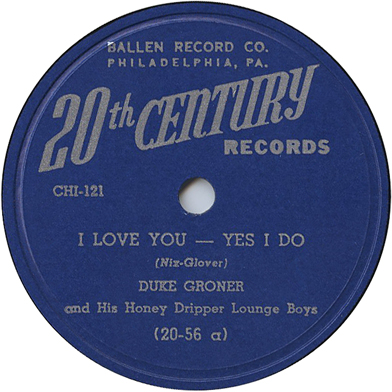
According to Bill Daniels, Williams dealt some of his material to the Philadelphia-based 20th Century operation in Feburary 1947. Later Williams would add two from the first recording session by the Duke Groner Trio. The cover of "I Love You, Yes I Do" (released in January 1948) was aimed squarely at Nathan, which had recently scored a hit on King with Bullmoose Jackson's version of the ballad. Some of the items that Williams recorded were released only on 20th Century; others were reissued on the Philadelphia-based label. (We have heard that there is a black-label Ebony IB 78 by Duke Groner, though we have yet to see it, and it would have to be a lot scarcer than its counterpart on 20th Century.)
Our list is almost certainly incomplete. For instance, a single by the "Dixiaires" on 20th Century 20-60 probably came from Wiliams' operation (its matrix numbers are in the noncommittal 1500 series that Ballen used for some of his other masters), but the Dixieaires were recording prolifically for other New York-based labels, including Sunrise—which, we might add, had the same New York Street address as Williams' Southern/Chicago/Harlem company and Ebony Distributors—and this compounds the difficulty of tracing such sides.
| Matrix number | Artist | Title | Release | Recording Date | Release Date |
| 5021 | Gaillard's Boogie Three | Slim's Cement Boogie | 20th Century 20-10A | September 1945 | July 1946 |
| 5016 | Slim Gaillard And His All Stars | Tuitti-Fruitti [sic] | 20th Century 20-10B | September 1945 | July 1946 |
| BEL-15 [sic] | Tab Smith | Granny Dodging at the Savoy | 20th Century 20-45 | c. August 1945 |
1947 |
| BEL-19 | Tab Smith | Vocal: Roebie Kirk | So This Must Be Love | 20th Century 20-45 | c. August 1945 |
1947 |
| C-110 | Lee "Georgie Boy" [sic[ Brown and His Boogie Band | Bobbie Town Woogie | 20th Century 2046a | 1946 | 1947 |
| BEL 153 | Dossie Terry | She's Alright | 20th Century 2046b | late 1946 | 1947 |
| CHI-103 | The Famous Blue Jay Singers | I Must Tell Jesus | 20th Century 2047 a | January 1947 | 1947 |
| CHI-105 | The Famous Blue Jay Singers | The Time Is Drawin' Nigh | 20th Century 2047 b | January 1947 | 1947 |
| JM-6 | Muriel (Bea Booze) Nichols and Her Dixielanders | See See Rider | 20th Century 20-48 A | 1945 | 1947 |
| JM-3 | Betty Thornton and Her Dixielanders | I Love You After All | 20th Century 20-48 B | 1945 | 1947 |
| 1594 | Ann Sorter McCoy | Bad Stuff | 20th Century 20-50 | 1947 | |
| 1595 | Jack Cooley Trio | Half Way 'Round the Clock | 20th Century 20-50 | 1947 | |
| 1596 | James "Sweet Lucy" Carter And His Orchestra | Let Me Be Your Coal Man | 20th Century 20-51A | 1947 | |
| 1597 | James "Sweet Lucy" Carter And His Orchestra [Muddy Waters] |
Mean Red Spider | 20th Century 20-51B | 1947 | |
| 1606 BR 1268 |
Five Gospel Souls [The Soul Stirrers] | Sleep on Darling Mother | 20th Century 20-52 Gotham 621 |
1947 | 1947 |
| 1605 BEL 165 |
Five Gospel Souls | Don't Wonder about Him | 20th Century 20-52 Gotham 621 |
1947 | 1947 |
| 1607 IN 166 |
Five Gospel Souls | Well, Well, Don't Worry about Me | 20th Century 20-53 | 1947 | 1947 |
| 1608 IN 167 |
Five Gospel Souls | This Friend of Mine | 20th Century 20-53 | 1947 | 1947 |
| IN-168 | Five Gospel Souls | His Eye Is on the Sparrow | 20th Century 20-54a | 1947 | 1947 |
| BEL-169 | Five Gospel Souls | One Moment in God's Kingdom | 20th Century 20-54b | 1947 | 1947 |
| CHI-121 | Duke Groner and His Honey Dripper Lounge Boys | I Love You—Yes I Do | 20th Century 20-56 a | 1947 | January 1948 |
| CHI-122 | Duke Groner and His Honey Dripper Lounge Boys | New Blow Top Blues | 20th Century 20-56 b | 1947 | January 1948 |
| UN-20 | Harry Dial | Broad Bottom Boogie | 20th Century 20-57 | 1945 | 1948 |
| UN-23 [?] | Harry Dial | I Know You're Lying | 20th Century 20-57 | 1945 | 1948 |
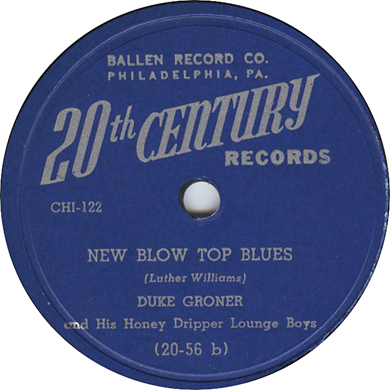
In 1948 Williams leased a Lil Palmore single (as released on Ebony 1B, one side having already appeared on Harlem) to Bob Shad's Sittin' in with operation. In 1949, Williams leased two sides, by the Famous Blue Jay Singers, to Evelyn Aron and Leonard Chess's Aristocrat label. That same year, he leased a handful of sides to Dave Miller's Essex label, which was also headquartered in Philadelphia.
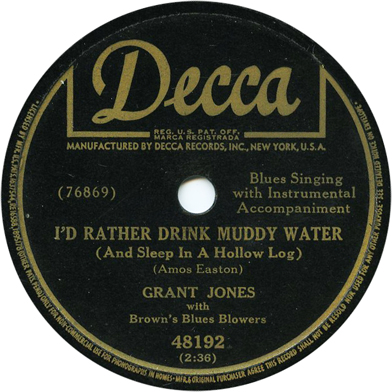
Williams also made an occasional deal with his former employer. In late 1947, he had recorded Stick McGhee's original version of “Drinking Wine Spo-Dee-O-Dee," which appeared on Harlem 1018A. The number rapidly became a big hit when it was re-recorded by Atlantic in February 1949; Ahmet Ertegun had heard that there was unmet demand for the single in New Orleans, so he found McGhee and signed him. The Harlem record had used an older Southern master by Bob Camp for the reverse; Ertegun compounded the insult by including "Blues Mixture" on the same February 1949 session. Williams, who had no distribution in 1949, promptly dealt his McGhee sides to Decca. Williams' version was reissued on Decca 48104, backed with an unissued McGhee master that presumably had also been done for Williams. Decca subsequently either recorded or picked up a four song session by Camp in July. Williams later sold or leased his May 1945 John Sellers session to Decca, which slapped new matrix numbers on a couple of sides on February 9, 1950. Decca also released two sides from an 8-tune session that Harry Dial and his band had done in 1945 (the same one that produced UN-20 through UN-23, originally released on Harlem 1035 and 1040). "Prince's Boogie Woogie" and "Diddywadiddy" were given new matrix numbers (75848 and 75849) and released on Decca 48142.
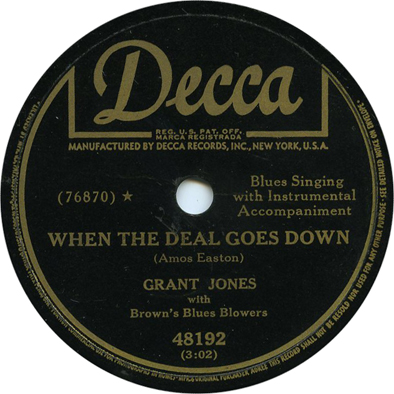
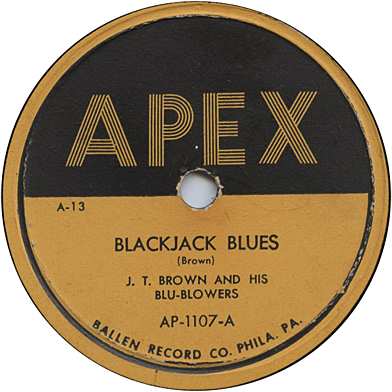
Also in 1949, Williams cut another deal with Ivan Ballen. By this point, Ballen had temporarily closed 20th Century (he would revive the imprint several years later) and started another label called Apex (which is not to be confused with the label from the 1920s, or with the Chicago-based independent label from the late 1950s). Apex released a single by Booker T. Washington with a band led by tenor saxophonist J. T. Brown; no Harlem release is known. The second to last Harlem, two sides from the same sessions issued under J. T. Brown's name, also appeared on Apex. Two further sides from the same sessions appeared on Harlem under the name of the singer, Grant Jones; we have not located a corresponding release for these on Apex. Another two Grant Jones sides from this session were dealt to Decca; they appeared on Decca 48192 with new matrix numbers.
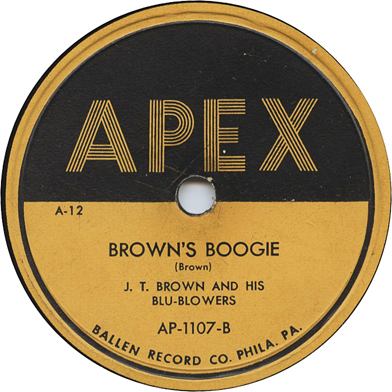
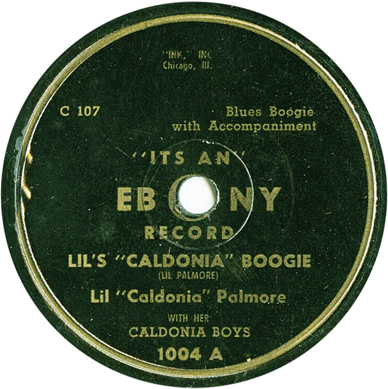
In 1947, Williams opened a really small, strictly Chicago-based label, for which he revived the Ebony imprint (in this phase, we will call it Ebony IB). He ran it out of an office in the old South Side Record Row, at 4823 South Cottage Grove. There were just a handful of releases on Ebony IB, which used a 1000 series. (Our best current guess is that there were five, which factors in word of mouth that there was a black-label Ebony IB by Duke Groner.) It's been assumed by some that the Ebonys shared the series with Williams' earlier and longer-lived Harlem label. It appears to us, though, that the two series were independent and the scattered Ebony releases could be (and have been) misconstrued as filling a few gaps in the denser but far from perfectly consecutive Harlem series. There is also the cases of Harlem 1004-A becoming Ebony 1004-B and one side of Harlem 1040 becoming Ebony 1040-A… but the couplings were different.
Williams wasn't listed in Chicago phone directory under "Record Wholesalers and Manufacturers" until June 1947, when his operation showed up under the name of Harlem Records, further identified as national distributors of the Harlem-Southern-Ebony labels. The new Ebony operation started at this time, or a little later. The address was at 5056 South Michigan Avenue. The listing last appeared in the June 1949 phone directory, indicating that Williams' first independent operation closed down around this time.
The Ebony IB label featured gold print on a black (occasionally red) background. In place of the elaborate notice around the edge of the label on the Chicago, Southern, Harlem, and Ebony IA label releases, the Ebony IB labels cryptically identified the producer as "Ink," Inc., and gave the location as Chicago, Ill. We have included records among our Ebony IBs if they have "Ink," Inc. and Chicago, Ill. at the top of the label, even when the label reads "Harlem Ebony" instead of "It's An Ebony," or is red instead of black.
Lil Palmore (v -1, p); unidentified (eg); unidentified (b).
Chicago, prob. 1946
| C-107 | Lil's "Caldonia" Boogie (Palmore) | Ebony 1004 A, Sittin' in with 18000*, Sittin' in with 540 | |
| C-104 | I Believe I'll Go Back Home (Palmore) -1 | Harlem 1004-A, Ebony 1004 B, Sittin' in with 18000*, Sittin' in with 540 |
Williams had used the C matrix series for many of his Harlem releases. C-104 and 107 appear to date from 1946. Courtesy of the 78 Archives at archive.org, we have just discovered a rare Harlem release. It was the first one from this session, and probably came out in 1946. Harlem 1004 had "I Believe (I'll Go Back Home)" as 1004-A. The other side, "Come Back to Me" (CHI-105, Harlem 1004-B), would not be reissued. Ebony 1004 came out in 1947; subsequently, Williams, who as usual needed distribution and by 1948 really didn't have any, dealt it to Bob Shad's Sittin' in with operation. The New York-based label first put it out in 1948, on Sittin' in with 18000. After Shad established a regular 500 series for R&B items, the single reappeared on Sittin' in with 540. We haven't seen the label copy for the 540 release.
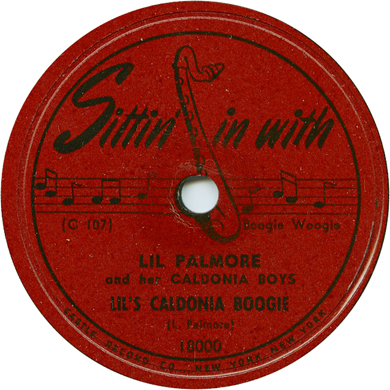
Sometimes billed as "Queen of the Blues," Lil Palmore was a popular vocalist and pianist in the late 1940s, playing innumerable clubs. She first appeared on the contract list maintained by Musicians Union Local 208 on February 3, 1944, when "Lillian" Palmore filed an indefinite contract with the Garrick Stage Bar. On May 11, 1944, she posted an indefinite contract at the Hurricane Show Lounge. She picked up another 3 weeks at the Hurricane on September 7, and no fewer than 13 weeks on October 19. In 1945, she spent some time at the Ritz Lounge (4-week contract posted on March 15). In May she was back at the Hurricane, filing a 4-week contract on May 17, 1945. In June, she began her association with Pitts Pub in the famed Point nightclub area (39th and Cottage Grove), posting a contract on June 21 for 4 weeks with options. On December 6, 1945, she filed an indefinite contract with the same establishment.
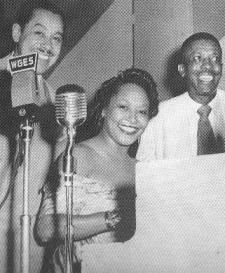
In 1946 Palmore enjoyed a long run at Pitts Pub; on May 16, 1946, she filed a contract with Local 208 for 4 1/2 months, and on October 3, she filed for another 16 weeks. Early in 1947 Palmore moved to the West Side at Ike's Oasis Lounge (1900 West Lake; this was really Martin's Corner temporarily functioning under another name). Her career was interrupted in February 1947, when she made tabloid headlines, for shooting her husband to death in a domestic dispute.
Palmore apparently beat the charges, because she was soon back entertaining again, at George's Lounge in May; at the Hollywood Rendezvous (3849 Indiana) and the Ebony Lounge in July and September, and Pitts Pub in September and October (contract for 2 weeks with option filed on September 18, extended for 4 weeks on October 2). In November she was at Ralph's Lounge (indefinite contract posted on November 6, 1947). She finished the year at Pitts Pub once again (8 week contract filed on November 20).
Lil (sometimes spelled "Lill") Palmore was at Howard Brothers Lounge toward the end of January 1948 (indefinite contract posted on January 22), extending her contract with what was now called Howard's on February 5. In April, she returned to Pitts Pub, filing a contract for 12 weeks on April 15, extended for another 12 weeks on July 15. She held down a gig at the Music Box Lounge (408 East 63rd) for some time in 1948. In October of that year, when she was performing at the well known blues establishment the 708 Club (708 East 47th; 6 week contract filed on October 7), she was billed as a "recording artist." This could be the date of release for Ebony 1004. More likely, though, it marks the appearance of Sittin' in with 18000 which, though not common, shows up more often today than Ebony 1004.
Mayo Williams' fondness for female performers doing boogies must have started with Ebony 1004. Contrary to the usual commercial procedure, he marked the boogie as the A side. "Lil's Caldonia Boogie" is strong performance featuring fleet pianism and nice work by the electric guitarist. On "I Believe I'll Go Back Home" Palmore shows off her prowess as a blues singer. Were the long held notes in the final chorus a trademark?
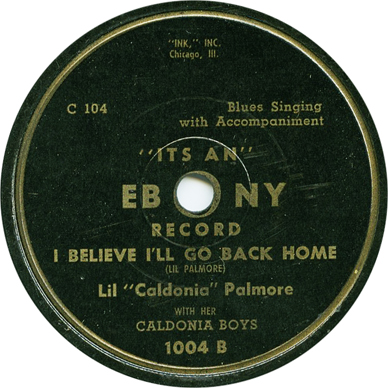
In December 1948, Palmore returned to her home away from home, Pitts Pub, for another 12 weeks (she filed her contract with Local 208 on December 2). She scored another 12-week deal with Pitts on May 19. She moved to the Sago Lounge for a 12-week gig in November 1949 (contract filed by Local 208 on November 17). In 1950, a lean year for many South Side musicians, she filed no contracts with Local 208. In 1951 she was at Jimmy's Palm Garden (indefinite contract posted on January 18).
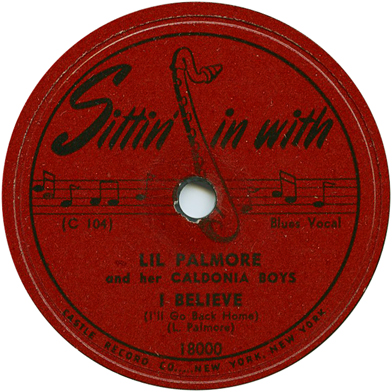
Palmore kept a low profile for several years, filing no contracts with Local 208 from 1952 through 1955. She would not record again until 1956, when she appeared on two sides for the Verro label, peculiarly using the new name of Cal Palmer. She sang two sort of pop songs written by Hobart Dotson, who was also responsible for playing trumpet and arranging the sides; a band led by drummer Buddy Butler accompanied her. If we hadn't realized that the Cal comes from "Lil's Caldonia Boogie," we'd have expected a male singer. In 1959, Williams' third and final Ebony series would include three more sides on her, again as "Cal Palmer."
Mabel Robinson (voc) with Alan Nurse (p, dir); tp; ts; b; d
New York, 1945
| UN-26 | Black Snake Blues | Ebony 1030 A | |
| UN-27 | There's Only One Man | Ebony 1030 B |
This was one of the recordings that Williams had made in New York. The UN prefix appears on many Southern and Chicago releases: UN-23 and 30, recorded in New York by Brother John Sellers, were dealt to Queen and released in 1945. The Ebony release is probably from 1948 or 1949.
Harry Dial (d, voc, dir); others unidentified/ Huey Long (eg, dir); Maxine Johnson (voc); others unidentified.
New York, 1945 / New York, 1947*
| Bel 23 [sic] | Don't Tell Me to Ugh-Uh (When I want to Ugh-Huh) | Ebony 1040 A | |
| Bel 163 | No Romance with Finance (Is All She Wrote)* | Ebony 1040 B |
The Harry Dial side was from a session that Williams had made in New York in 1945; all four sides were previously released on Harlem 1035 and 1040. Dial half-sings, half-talks the vocal, doing multiple vocal impressions. The band is a swing combo with three horns. The information we have on 1035 and 1040 puts the matrix numbers in a series from UN-20 to 23, not in the BEL series. (And "Ugh-Uh" was originally UN-22—if our other information is accurate.)
The Huey Long side is from another New York session, probably from early 1947 as Williams' New York operations were winding down. Long can be heard briefly on electric guitar; otherwise the side is a vehicle for the vocalist and medium-size band. The Ebony release is from 1948 or 1949.
The last (maybe the rarest) Ebony IB was discovered around 2015. It has been brought to our attention by Yves François Smierciak (Facebook messages, August 2025); he bought it in a second-hand store on Clark Street after being told that a newly accessioned 78 had "rap" on it. Stanley R. "Fess" Williams had been on the scene since the 1920s. "Wild Cat Special" is a remake of "Hot Town," first recorded by Fess Williams and his Royal Flush Orchestra in 1929. By the 1940s, Williams was leading a jump band. The exchanges between Fess Williams and Andy Pendleton on "Wild Cat" are a (distant) precursor to rap.
There are no vocals on "T Town Blues," a boogie that features the piano and the trumpet. No solo by Fess Williams, either.
Personnel are as identified by Yves François. What little is known about Williams' groups in the first half of the 1940s comes from an article in IAJRC 16.
Fess Williams (cl, as, dialogue); Andy Pendleton (dialogue); Ben Rogers or Alex Atkins (tp); unidentified (as); John Hartzfield (ts); Larry Johnson (p); Arnold Adams or Andy Pendleton (g); June Cole (b); Clint Smith (d).
New York, 1945 / New York, 1947*
| BE 1025 IN 50 JN FR |
T Town Blues (Tulsa Boogie Woogie) (F. Williams) Trumpet Boogie% |
Ebony 1045 A, King 4264 B% | |
| H 108 | Wild Cat Special (F. Williams) | Ebony 1045 B |
This Ebony release looks like the end of the line from 1949. The two sides carry matrix numbers from different series, each made in New York City. Both were most likely recorded in 1945.
By 1950, Williams had his office at the South Center Building, located at 417 East 47th Street, on Bronzeville's main business drag. That building contained not only the famed South Central Department Store, but also the Negro Chamber of Commerce, and the offices of lawyers and other professionals. His Harlem-Southern-Ebony complex had closed down, and Williams probably maintained the office to keep up with his publishing, to support any freelance producing that he was doing, and to gear up for a future relaunch. His company in the December 1950 directory was listed under the name, "Williams, J. Mayo," with a line under it that read, "Harlem Records-Artists Representatives."
During this fallow period, we strongly suspect Williams' involvement with at least one freelance production that appeared on another label. Early in 1950, Lee Egalnick and Lew Simpkins' Miracle operation, then on its last legs, announced the signing of bluesman Johnny Temple. And one single on Temple did appear, on Miracle 156, right before the company went broke. Temple was not a typical Miracle artist, his sides were recorded in a cheap studio not otherwise used by the label, and the matrix series, 2000 and 2001, is otherwise unknown. Meanwhile, Williams had recorded Temple back in 1946 (two sides from a long session appeared on Queen) and his last Harlem release had sported matrix numbers 1000 and 1001.
Ebony relaunched as an imprint in 1952, again using 417 East 47th Street as its business address. Throughout the lifetime of Ebony II (and its successor, which we will call Ebony III), Williams barely distributed his releases and must have sold handfuls on most of them. But he lived well during this time. Apparently he was drawing enough legacy income from his Decca years and his songwriting credits, which included "Corrina Corrina," "Fine Brown Frame," and Louis Jordan's "Mop Mop." The Chicago Defender considered Williams a society figure, and regularly reported on his vacation trips to California and the East, or visits to his Michigan summer home.
Like Ebony IB, Ebony II was a boutique label. In fact, it was smaller and more local than its predecessor. To our knowledge all of Williams' new recording in the 1950s took place in Chicago. As Williams entered his 60s, his nose for talent was still fully functional, but his sense of what would sell had long since deserted him, and the sonic quality of some of his company's sessions could be on the rugged side.
Nonetheless, the second Ebony label was responsible for a number of valuable sides by bands and singers, then active on the Chicago scene, who would otherwise be completely forgotten today. It also recorded some new artists, like saxophonist Red Holloway, who would quickly move on to greater renown.
The second incarnation of Ebony had such weak distribution that an occasional deal with another company was the only way to get a record in front of more potential buyers. So far we have been able to document partnerships with Art Sheridan and Ewart Abner's Chance label, as well as Joe Brown's JOB—but again much remains unexplored.
To keep confusion at a maximum, Williams used a 1000 series for most of his releases on Ebony I (and on Harlem) in the 1940s. He used a 1000 series for all known releases on Ebony II, and would continue reusing the 1000 series during the Ebony III period as well. In turn, some of the Ebony IIs reissued material from Ebony I, or one of Williams' other 1940s labels...
Williams was tardy getting into 45s. So far as we know, his releases were exclusively on 78 until 1957, whereupon he rapidly shifted over to producing 45s only. Less than a handful of the Ebony IIs were released in both formats.
All Ebony II 78s carried the same logo in silver print on a dark red background. The earliest among them carried no further blurb. Wiliams next tried hawking his 78s as "Vibraphonic," before he settled on calling them "High-Fidelity," a much more widespread advertising claim in the 1950s. The "High-Fidelity" would remain in the logo on all subsequent Ebony IIs, and was carried over when Wiliams started pressing 45s.
Anita Brown (voc), with ts, p, b.
Chicago, unknown date.
| EB-1000-A | Yes, I Love You | Ebony 1000-A | |
| EB-1000-B | Hey! Mr. Johnny | Ebony 1000-B |
Fancourt and McGrath list this session in their blues discography. But they also combine the two Anita Brown releases. Rather strangely, she was designated as "The Princess Lady" on the Ebony 1000 release and as "Anita 'The Brown'" on the Ebony 1008 in this series.
Anita Brown (voc ^); Genius Jack (voc %); with ts, p, b.
Chicago, unknown date.
| EB-1008-A | Christmas Time Blues (Blues for the Princess) ^ | Ebony 1008-A | |
| EB-1008-B | Nursery Rhyme Blues % | Ebony 1008-B |
The flip side has the vocal by Genius Jack, about whom we know nothing more. We're assuming that the same group accompanied both performers, but more research is needed on that.
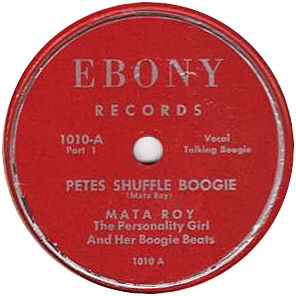
Mata Roy (voc, p); unidentified (eg).
Chicago, prob. 1952
| EB 1010 A | Petes [sic] Shuffle Boogie Part 1 (Roy) | Ebony 1010-A [sic] | |
| EB 1010 B | Petes Shuffle Boogie Part 2 (Roy) | Ebony 1010-B [sic] |
Mata Roy, a piano player and singer, was active in the Chicago clubs from 1941 through 1952. Partly because of her odd name, the story has circulated that she was a female impersonator, but, having seen a photo, we must reject that report.
Mata Roy first shows up on the Musicians Union Local 208 contract list on July 24, 1941, when she posted a contract with the Yes Yes Club. In August 1941, Roy was working at Elmer's Cocktail Lounge (contract accepted and filed on August 14). After that, Roy dropped off the list for several years. Where her travels took her we are not entirely sure, but Dave Penny has pointed out to us that by 1944 she was definitely in Southern California. On August 21, 1944 she appeared on the very first session for Art Rupe's Juke Box Records (an unimaginative name that in 1946 was changed to Specialty), which was cut in Los Angeles. As a member of the Sepia Tones, Roy sang on "When He Comes Home to Me," which was released on Juke Box 100. She was also featured on a piano boogie with the group: "Boogie #1" was released on Juke Box 100 and 500, as well as Specialty 500. The other members of the group were veteran jazzman Paul Howard (clarinet and tenor sax), Nina Russell (organ), and George Vann (drums). Juke Box 101, later Specialty 101, featured Vann's blues singing. Mata Roy participated in all five surviving sides from the session.
Mata Roy seems to have returned to Chicago in 1948. On May 6 of that year she filed for 2 weeks at the Moderne. The contract list for December 16, 1948, puts her at Square Lounge for 2 weeks with an "indefinite option." On February 3, 1949, the Board meeting minutes of Local 208 listed Mata Roy's 2-week contract at Alexandria Cocktail Lounge; on March 17 Roy filed a 1-week contract with the Talk of the Town Lounge, following up with an indefinite contract on April 7. In November 1949 Mata Roy worked at the Nob Hill and Mooney's Lounge (1-week contracts with each filed on November 3). On January 5, 1950, Local 208 posted Mata Roy's 4-week contract with Mooney's Lounge. By April 6 of that year, Roy was holding forth at Show Time Lounge, where she posted a 2-week contract, plus an indefinite stint at the Copa Lounge. On April 3, 1952 Roy posted a contract for one week with options at the Lullaby of Broadway. On May 1, 1952, her contract for 2 weeks at the St. Moritz Tap Room was accepted and filed.
In the second half of 1952, Mata Roy disappeared again from the Local 208 contract lists. We don't know whether she returned to the West Coast. Her absence from Chicago in the second half of 1952 is further evidence that her single was released in the earliest days of Ebony II.
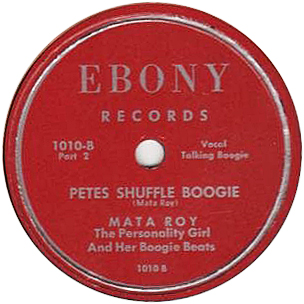
This Ebony release was Mata Roy's only solo record. Williams liked to record female performers doing talking boogies (starting with Lil Palmore in 1948; for Anna Lee's contribution to "Nature Boy Blows It," and Lillian Campbell's "Money Talking Boogie," see below). In this case, the boogie takes up both sides of the 78.
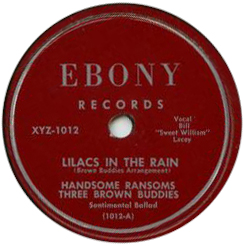
On ^, Bill Lacey (voc, prob. eg); unidentified (p, b, d).
Chicago, unknown date
On %, Olivette Miller (harp); unidentified (p, b).
Chicago, prob. 1947
| XYZ 1012 | Lilacs in the Rain (Brown Buddies Arrangement) ^ | Ebony 1012-A, Ebony [III] 1010 (45 rpm only) | |
| CHI-108 | Harpin on the Harp (Miller) % | Ebony 1012-B |
Ebony [II] 1012 pairs two disparate sides. Although the label is the same silver on red used during the lifetime of Ebony II, it carries neither the "Vibraphonic" logo that appears on a couple of Ebony II 78's, nor the "High Fidelity" moniker that appears on most of the rest. It was probably one of the first Ebony II's to see issue.
The Three Brown Buddies may have used Willie Lacey, who played guitar on a number of late 1940s blues sessions, as their lead singer. One wonders as well whether this is the same group as Buddy Brooks' Three Brown Buddies, who showed up on the Local 208 contract list for May 20, 1954 (when they were signed to a gig of indefinite length at the Normandy Lounge). All to be researched... The XYZ prefix could indicate that the side was recorded during the lifetime of Ebony I. More likely it was an ad hoc way of differentiating this side from its diskmate.
The Three Brown Buddies side would reappear on a 45-rpm release, confusingly numbered 1010, from the Ebony III days (see below).
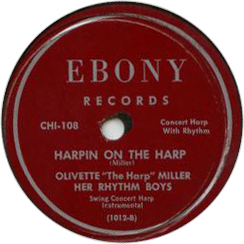
Olivette Miller was active as a harp player in Chicago. She was the daughter of the Broadway show producer, Flournoy E. Miller, who achieved fame for Shuffle Along and Runnin' Wild. She appears to have performed mainly at society affairs, making very sporadic forays into the club scene.
In 1947, she worked for a time at Colosimo's, filing a contract with Local 208 for two weeks with an indefinite option on May 15. In August, she took a gig at the Capitol Lounge ("indefinite" contract posted on August 21). On October 5, 1947, she landed a radio appearance on the NBC network, alongside Louis Armstrong. On December 4, she posted a contract for 3 weeks at Club Detour. In March 1948, she took up a 2-week gig at the Beige Room in the Pershing Hotel (contract posted on March 4, extending her stay for another 2 weeks on March 18). In October she landed another 4 weeks at the Beige Room (contract accepted and filed on October 7). When her spot at the Beige Room was taken by Gene Wright and his Dukes of Swing, she took up a 2-week engagement at the Sherman Hotel (contract posted on October 21).
During 1949 and 1950, Miller took no nightclub engagements that we know of. She was completely absent from the Local 208 contract list.
In 1951, Olivette Miller marked her return to the club scene with a well advertised gig at the high-toned Harry's Show Lounge (423 East 63rd); her contract for 2 weeks with options was accepted and filed on October 4. She shared the bill with guitarist Ike Perkins and His Hawaiian Band, and was billed as "America's Foremost Swing Harpist." Williams probably took this as a propitious occasion to release some of what he had recorded.
After her Ebony release, Miller continued to work in Chicago, though her club gigs were the exception rather than the rule. In April 1952, she landed a gig at the Blackhawk Restaurant (2-week contract posted on April 3). In 1953, she worked at the Black Orchid (contract for one week with an option for a second week, filed on June 18) and appeared on the Danny O'Neill Show on WBKB-TV (contract filed with Local 208 on October 15). 1954 found her completely absent from the Local 208 contract list. In 1956 she teamed up with dancer Bert Gibson, performing at Roberts Show Lounge (6622 South Parkway). Gibson had previously been with a comedy dance trio, the Chocolateers. With Gibson as her partner, in 1957 she produced a 90-minute revue called Highlights, based on scripts and scores she obtained from her father. It featured a cast of 35, which included both her father and the noted black actor, Mantan Moreland.
The CHI prefix on the matrix number was one that Williams had used on a few sessions in the late 1940s; for instance, CHI-101 and 102 were two sides by the Famous Blue Jay Singers, recorded in early 1947. Williams most likely recorded Olivette Miller in 1947, when she was making fairly regular appearances on the club scene, and held the side till later. Given Wiliams' rather eccentric procedures, however, he may also have decided to revive the CHI series in 1951.
During the remainder of 1952 and the first half of 1953, Williams promoted his records as "Vibraphonic." We know of 5 of these vibraphonic entities: 2 in the blues field, 2 in gospel, and one in vocal-group ballad singing.
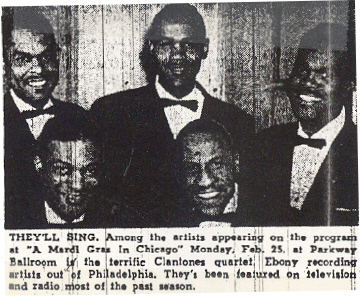
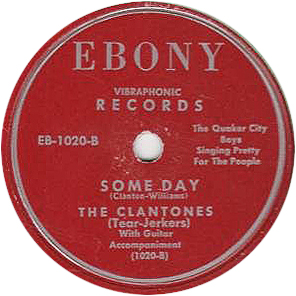
The Clantones (vocal group); unidentified (g).
Chicago, early 1952
| EB 1020 A | It's No Sin (Shull-Haven) | Ebony 1020-A | |
| EB 1020 B | Some Day (Clanton-Williams) | Ebony 1020-B |
The Clantones were a different kind of vocal group, specializing in ballads. "The Quaker City Boys Singing Pretty for the People" is Williams' other descriptor for them.
The group was one of the first that Wiliams would sign to his revived label; he placed a photo of them in the Chicago Defender in February 1952.
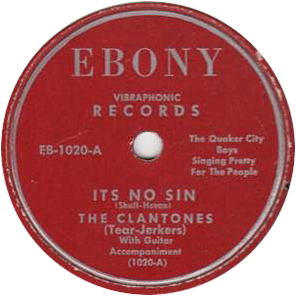
"It's No Sin" is a schmaltzy number that was going the rounds at the time; it was done as a pop vocal by Savannah Churchill for RCA Victor (her version charted) and as an instrumental by Tab Smith for United.
McGrath lists another Clantones single on Ebony 1021. He claims it was originally released in 1964, on the third incarnation of Ebony. McGrath also attributes ownership of Ebony III to Charles Priest, which is clearly incorrect. There is still work to do clarifying things...
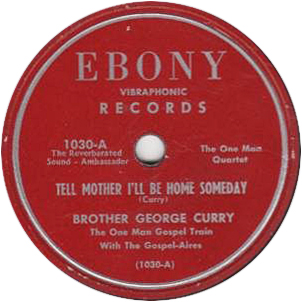
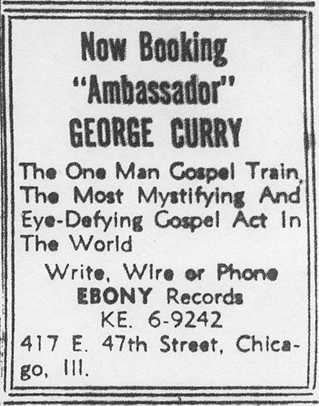
George Curry (voc); others (if any) unidentified.
Chicago, 1952
| EB 1030 A | Tell Mother I'll Be Home Someday (Curry) | Ebony 1030-A | |
| EB 1030 B | Rock Daniel (Curry) | Ebony 1030-B |
Brother George Curry was billed as the "One Man Gospel Quartet." In the studio, multi-tracking was the key; he would record himself on lead and overdub 3 harmony parts. How he coped in live performance remains a little difficult for us to figure, but Williams, whose promotional budget must have been microscopic, actually took out an advertisement in the Chicago Defender to promote bookings for him.
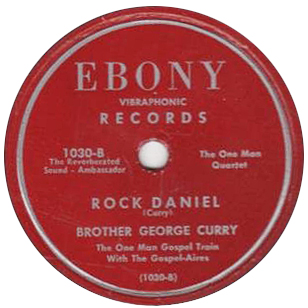
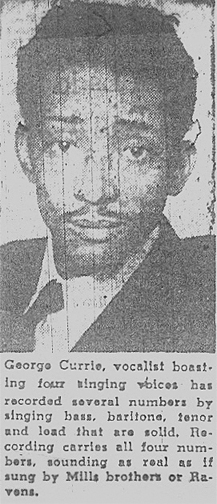
Hayes and Laughton in The Gospel Discogaphy 1943-1970 claim that this session was made "c. 1948." A shellac pressing with the black Ebony label on it would be persuasive... Actually it was in 1948 that a secular-singing George Currie (as he spelled his name then) was briefly featured in the Chicago Defender. The blurb said of him, "boasting of four singing voices has recorded several numbers by singing bass, baritone, tenor, and lead that are solid. Recording carries all four numbers, sounding as real as if sung by Mills Brothers or Ravens." We don't know who Curry made his first record with—no trace of it has been found.
Curry continued to record after his one Ebony release. Either in 1952 or 1953, he put two singles out on the Elko label, which was based in Los Angeles. He appears to have produced and recorded them himself, as they do not sound like anything else that ever appeared on Elko. Unfortunately, Elko 827, his only secular recording that we know of (featuring the inimitable blues with the inimitable title, "Number 9 on the Menu Cat a la Carte and Dog Slaw"), and Elko 828 are even more obscure than his Ebony. It's hard for any record to be more obscure than an Ebony. Curry subsequently recorded two gospel singles for Phoenix, another LA-based indie, and two more for his own Currytone label, whose address was in New York City (our thanks to Big Joe Louis for information on Curry's other records).
We have to wonder what Curry did in live performance, because his recordings depended so heavily on his overdubbed vocal lines. Did he use prerecorded backgrounds?
This is the first gospel release that we know of on the second Ebony label. Williams had previously been quite active recording gospel for Chicago, Southern, Harlem, and the first, red-label Ebony (Ebony IA).
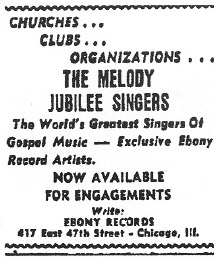
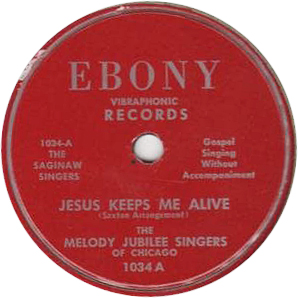
The Melody Jubilee Singers of Chicago (vocal group).
Chicago, poss. late 1952
| EB 1034 A | Jesus Keeps Me Alive (Saxton Arrangement) | Ebony 1034 A | |
| EB 1034 B | I'm in His Care (Parks Arrangement) | Ebony 1034 B |
Williams also identified this group as "The Saginaw Singers," which might indicate where they were originally from.
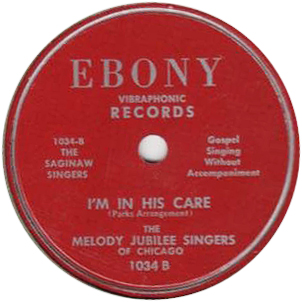
Bob McGrath, in the second edition of The R&B Indies, lists Ebony 1031 by The Melody "Gospel" Singers of Chicago and Ebony 1033 by The Melody Jubilee Singers of Chicago. He attributes both to the first incarnation of Ebony. Hayes and Laughton, concur, giving "c. late 1948" as the recording date for those items; they, too, do not mention Ebony 1034.
Williams may have recorded the Melody Jubilee Singers in 1948. However, the group was on his active artists' roster in 1953, as we learn from another one of his sporadic Defender ads.
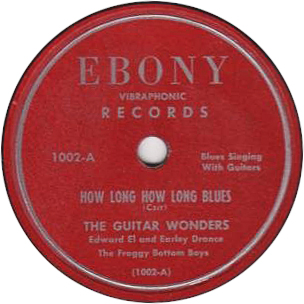
Edward El (eg); Earl Dranes (eg); other musicians unidentified.
Chicago, c. 1952
| EB-1002-A | How Long How Long Blues (Carr) | Ebony 1002-A | |
| EB-1002-B | Hey Babe (Dranes) | Ebony 1002-B |
Eddie El, a veteran blues guitarist, and Earl Dranes (whose name was subjected to quite a variety of spellings during his career) had worked, along with pianist Willie Mabon, in the first editiion of a group called the Blues Rockers, which recorded for DJ Al Benson in 1949; two sides from the session were released on Aristocrat in December 1949.
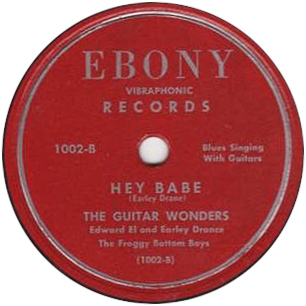
Dranes went on to record a second session for Aristocrat with the Blues Rockers in 1950; by this time, El had left the group. In 1954, "Early Drane" worked the Be Bop Lounge (his indefinite contract was accepted and filed by Local 208 on April 15; a second indefinite contract was posted on May 20). In August of that same year, he recorded as a side man on the James Bannister/Alfred Harris session for States. Dranes used the Blues Rockers name one more time, for a session that he did in Nashville for the Excello label (1955). His last club appearances in Chicago that we know of took place in 1956.
Fancourt and McGrath list this session, claiming that the two guitars are the only intruments on it, and giving a date of "early/mid 1950s."
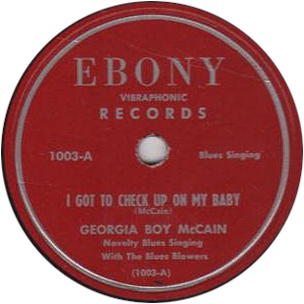
Georgia Boy McCain (voc^); Dossie Terry (voc); other musicians unidentified.
Chicago, c. 1952
| EB-1003-A | I Got to Check on My Baby (McCain)^ | Ebony 1003-A | |
| EB-1003-B | New Moon Blues (Terry) | Ebony 1003-B |
Dossie Terry had previously recorded for Mayo Williams; he was responsible for Chicago 117 and Chicago / Southern 119, both done in 1945. Terry next surfaced on RCA Victor, recording two sessions in New York in December 1951, and another, which was left in the can, in February 1953. Assuming these recordings for Williams were new ("New Moon Blues" was not a title that Terry had previously released), they were probably made in between the RCA Victor outings. After being dropped by Victor, Terry next signed with King, which recorded him twice in New York City in 1957. He subsequently made one single each for the small New York-based operations of X-tra (1957), Amp (1958), and Bonus (1959).
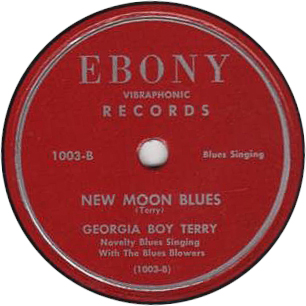
During the second half of 1953, Mayo Williams replaced the Vibraphonic slogan with High-Fidelity.
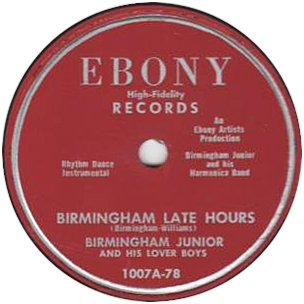
Wright Birmingham [Birmingham Junior] (voc on ^, hca); Freddy Robinson (eg); Charles Jones (eg); Billy Davenport (d).
Chicago, c. 1954
| EB 1007 A | Birmingham Late Hours (Birmingham-Williams) | Ebony 1007A | |
| EB 1007 B | You're Too Bad (Birmingham-Williams)^ | Ebony 1007B |
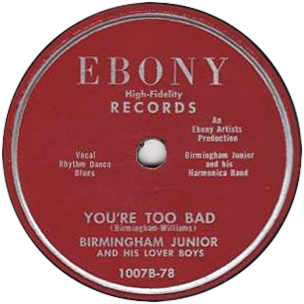
An advertisement in the city edition of the Chicago Defender, seeking bookings for Birmingham Junior, came out in 1957, but stylistically this session appears to have been done earlier, in the wake of Little Walter's success with his band the Jukes.
Personnel as per Fancourt and McGrath; as Birmingham Jones, Wright Birmingham made one more session in 1965, consisting of four tunes, for Vivid, a short-lived Vee-Jay subsidiary. It went unreleased at the time but has since appeared on a Floating Bridge LP and a Charly CD.
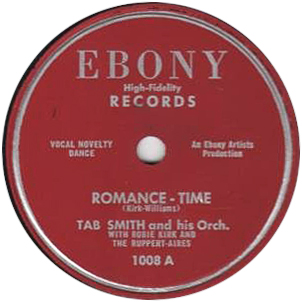
Original recording ^: Roebie Kirk (voc); Tab Smith (as, ts, dir); unidentified (p, eg, b, d). Overdubbing: The Ruppert-Aires (unidentified vocal group); Original recording%: Tab Smith (as, dir); other musicians unidentified; overdubbing: Jack Cooley (d).
Beltone Studio, New York City, August 1945, overdubbed Chicago, 1954 or 1955
| EB 1008 A | Romance-Time [sic] (Kirk-Williams)^ -1 | Harlem 1024 A (before overdubbing) King 4180 (before overdubbing) Ebony 1008 A (overdubbed) |
|
| EB 1008 B | Tabs [sic] Rocker (Smith-Williams)% | Harlem 1023 A (before overdubbing) 20th Century 20-45 (before overdubbing) Ebony 1001 B (see below, overdubbed) Ebony 1008 B (overdubbed) |
The combo led by alto (and occasional tenor) saxophonist Tab Smith (1909-1971) had been under contract to Mayo Williams for a time in 1945. Roebie Kirk sang on two of the four sides that Smith's group recorded at Beltone Studios in New York City, in August 1945; material from this session was released on Harlem and later on 20th Century. To produce maximal confusion, Williams took "I Don't Want to Play in the Kitchen" from this session (which originally appeared on Harlem 1024, then, as "Let's Go Upstairs," on King 4180) instead of the original "Romance Time" (which appeared under its original title on 20th Century 20-45). "Tabs Rocker" was originally titled "Granny Dodging at the Savoy" on Harlem 123 and 20th Century 20-45. It was a vehicle for Smith's "Velvet Tenor"; in fact, an obvious tribute to Lester Young, Tab's former bandmate with Count Basie. Like Lester's "Taxi War Dance," it's an uptempo paraphrase of "Willow Weep for Me."
Kirk did not continue with Smith after these outings; Smith, meanwhile, made one more session for Harlem and the first incarnation of Ebony in November 1945. Smith moved to the New York-based Hub and Manor labels, then, for one session in 1949, to a brand-new outfit called Atlantic. In the later part of 1947, sides from all three of the 1945 sessions under Williams' control were dealt to King Records, which put out several reissue singles.
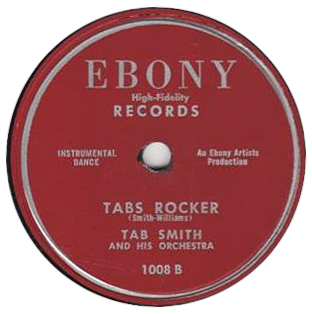
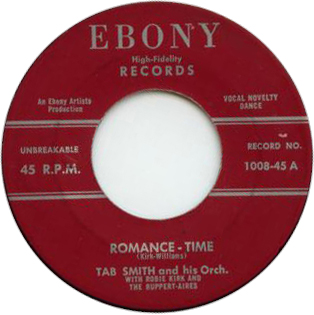
Roebie Kirk (voc on ^); Tab Smith (as, dir); other musicians unidentified; overdubbing: Jack Cooley (d).
Beltone Studio, New York City, 1945; overdubbed, Chicago, 1954 or 1955
| EB 1008 A | Romance-Time (Kirk-Wiliams)^ | Harlem 1008-A, Ebony 1008-45 A | |
| EB 1008 B | Tabs [sic] Rocker (Smith-Wiliams) | Ebony 1008-45 B |
This is a straight 45-rpm version of Ebony [II] 1008. The only difference is that "Orchestra" had to be abbreviated on the Side A label.
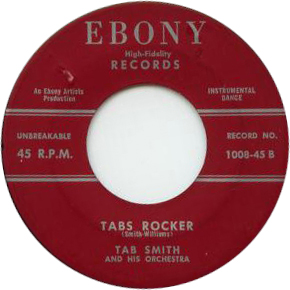
After moving to Saint Louis, Tab Smith began recording again in 1951: first for Premium, with some success, then for United, where his first single, "Because of You," was a big hit, and his subsequent releases were reliable sellers that they kept the company afloat until its closure at the end of 1957. Obviously, at some point between late 1953 and 1956, Williams sensed an opportunity to cash in on Tab Smith's popularity. However, his prospects of making new recordings with Smith (who was under contract to Leonard Allen of United for 6 years) were nil. So he overdubbed on top of some sides from 1945.
"Romance-Time" was recorded in August 1945 and originally appeared on Harlem 1008-A later that same year. "Tabs Rocker" is a retitle job on an instrumental from the September 1945 date. Which one it was remains to be determined.
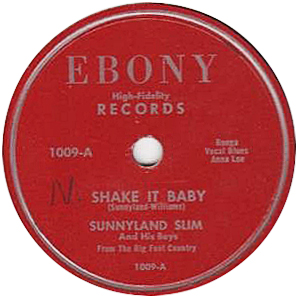
Anna Lee (voc); Sunnyland Slim (p -1); J. T. Brown (ts -2); unidentified (eg -1); unidentified (maracas -1); unidentified (perc -1); other musicians unidentified.
Chicago, late 1953 or early 1954
| EB 1009 A | Shake It Baby ("Sunnyland"-Williams) [SS, AL voc] -1 | Ebony 1009-A, JOB 1105, Westside WESA 910 [CD], Classics 5171 [CD] | |
| EB 1009 B | Nature Boy Blows It (Brown-Williams) [AL speech] -2 | Ebony 1009-B |
The A side of Ebony 1009 features Sunnyland Slim on piano and vocals, someone (possibly Sunnyland's regular bassist Big Crawford) shaking maracas, a drummer (possibly Sunnyland's regular drummer Alfred Wallace) doing hand percussion only, a guitarist (not Junior Lockwood, and not J. B. Lenoir) who is hard to hear, and one Anna Lee responding to Sunnyland's pleas. The recording quality proves that the side was not made anywhere near Universal Recording.
Joe Brown picked up the Sunnyland Slim side and reissued it on JOB 1105, which came out around August 7, 1954. Anna Lee was not credited on the JOB. Because of the JOB connection, the side has been further reissued on Westside WESA 910, Sunnyland Slim & Friends: Sunnyland Special: The Cobra & JOB Recordings 1949-1956, a British CD released in 2001. Classics 5171, Sunnyland Slim 1952-1955, was released on CD in 2006. Neither of these reissues cites the side's original appearance on Ebony.
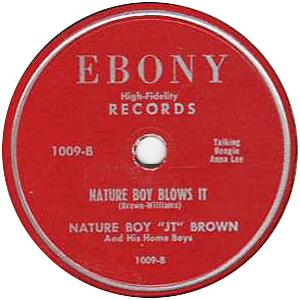
Although Joe Brown recorded J. T. Brown and released a single on him, the recording quality on 1009B was apparently too raw to interest him.
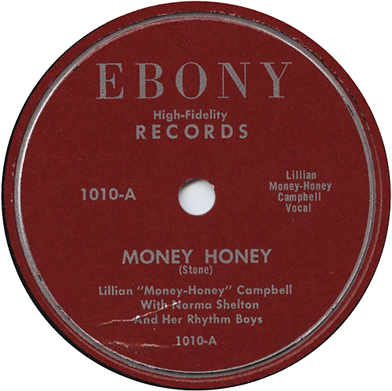
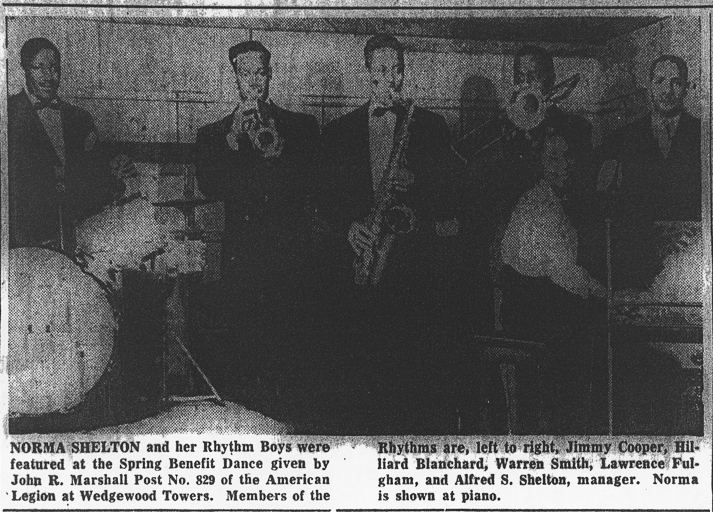
Lillian Campbell (voc) acc. by Norma Shelton (p, ldr); Hilliard Blanchard (tp -2); Warren Smith (as -1; cl -2); unidentified (eg -1); Jimmy Cooper (d).
Chicago, prob. late 1953 or early 1954
| EB-1010-A 323 | Money Honey (Stone) -1 | Ebony 1010-A | |
| EB-1010-B 323 | Money Talking Boogie (Williams) -2 | Ebony 1010-B |
The Lillian Campbell 78, the second Ebony 1010 to be released in the 1950s, has a 323 in the trail-off vinyl that is not present on the Mata Roy (an Ebony 1010 that was pre-Vibraphonic as well as pre-High Fidelity). "Money Honey" by the Drifters was released in September 1953, so this recording is most likely from the last quarter of that year.
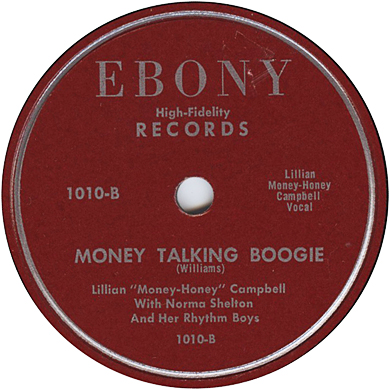
One wonders whether Mayo Wiliams had anything to do with placing a photo of Norma Shelton's band in the Chicago Defender. The band was not booked in the South Side clubs at the time, and the dance it had just played was not a high-profile event...
Norma Shelton was born Norma Rowlett in Fulton, Kentucky. Her parents were Iverson Rowlett and Mary Magdalene Rowlett. After Iverson's death in 1912, Mary Magdalene Rowlett moved to the South Side of Chicago, bringing Norma and her two sisters with her. Norma, who was basically self-taught, began playing the piano when she was 8 years old.
Norma married Alfred Shelton, who served as her band's manager; they had six children. By the early 1930s, Norma Shelton was performing regularly with her Rhythm Boys; they reportedly appeared at the Chicago World's Fair in 1933. One wonders whether Norma Shelton and Mayo Williams might have crossed paths back when he was working for Decca; by 1953, she had been performing in the Chicago area for at least 20 years.
Our thanks go to Karen Shelton, Norma Shelton's great-granddaughter, for this biographical information (email of March 30, 2009).
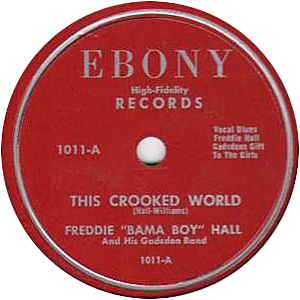
Freddie Hall (voc, p); unidentified (ts); unidentified (b); unidentified (d).
Chicago, prob. early 1954
| EB 1011 A | This Crooked World (Hall-Williams) | Ebony 1011-A, Chance 1159 | |
| EB 1011 B | Knock Me Out (Hall-Williams) | Ebony 1011-B, Chance 1159 |
Freddie Hall was a blues shouter. From the florid label copy on his Ebony release, we gather that he was originally from Gadsden, Alabama. We have learned from other sources that he played piano. Ebony confidently proclaims him "Gadsdens [sic] Gift to the Girls."
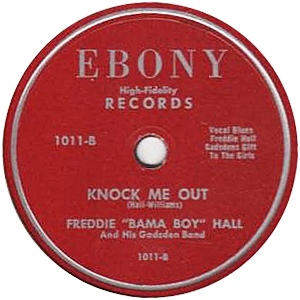
According to Fancourt and McGrath, Hall played piano on this session, and was accompanied by tenor sax, bass, and drums. "This Crooked World" is definitely inspired by Willie Mabon's "I Don't Know," maybe also by one or two of its knockoffs. So the record cannot have been made before 1953.
Apparently Joe Brown, who had collaborated with Chance in 1953, brokered a deal with label owner Art Sheridan, because in August 1954, the single was reissued (sans boasts about gifts to the girls) as Chance 1159. Until the recent discovery of the original release on Ebony 1011, we had only the matrix numbers HF-1011A and HF-1011B on the Chance single to indicate Ebony as the source.
Freddie Hall would next record in a rock and roll-influenced style for Abco (a label co-owned by Joe Brown) in 1956. His last known recordings were made in 1959, and consisted of three singles for the C. J. label; he also made two unissued sides that have survived.
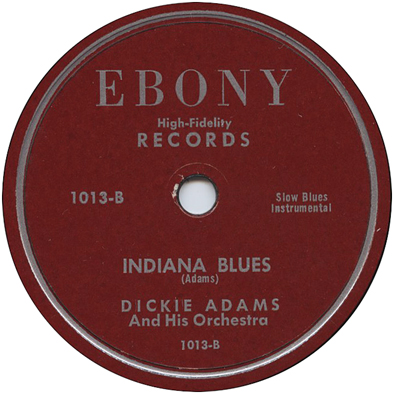
Marguerite (voc ^); Dickie Adams (ldr, poss. voc^) with unidentified (as); unidentified (ts); unidentified (ts); unidentified (p); unidentified (b); unidentified (d).
Chicago, prob. early 1954
| EB-1013-A | Rock It Little Daddy (Adams) [M, poss. DA, ens voc]^ | Ebony 1013-A | |
| EB-1013-B | Indiana Blues (Adams) | Ebony 1013-B |
Dickie Adams, about whom nothing more is known, led a sturdy jump combo with solo contributions from the alto saxophonist, one of the tenors, and the piano. The lack of down-home references in the label copy suggests that Adams was a native of the Chicago area. "Rock It Little Daddy" is a variant of "Rock Daddy Rock," as done by Bertha Henderson for Chance, and by a number of other performers for other labels; "Indiana Blues" is a slow instrumental.
The sonics are clear but the recording balance is not what one would expect from one of the top studios in town.
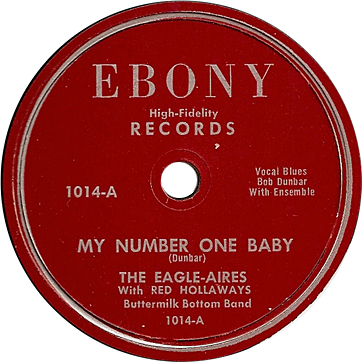
The Eagle-Aires: Robert Dunbar (voc); Eddie Clark (voc); ... Jones (voc); ... Brent (voc); acc. by James "Red" Holloway (ts); Lewis Carpenter (p); prob. Lefty Bates (eg); Hawk Lee (d); Robert "Hendu" Henderson (d).
Chicago, c. February 1954
| 1014-A | My Number One Baby (Dunbar)^ | Ebony 1014-A, JOB 1104 | |
| 1014-B | Cloudy Weather Blues (Clark) | Ebony 1014-B, JOB 1104 |
The two records by The Eagle-Aires are Williams' only known venture into doowop. The group was first-rate, but Williams apparently didn't sustain his interest in the genre. Again, the balance between the singers and the instrumentalists is not what would ensue from an outing at Universal Recording.
One of Williams' many eccentricities was a predilection for attaching the Aires suffix, then commonplace in the gospel world, to the names of secular vocal groups. See also the Ruppert-Aires, who performed on Ebony 1008.
Ebony 1014 was quickly dealt to Joe Brown, who reissued it (with a whole lot less label copy) as JOB 1104. Until recently, most collectors were familiar only with the JOB, on account of the rarity of the original release; at present just three copies of the Ebony are known.
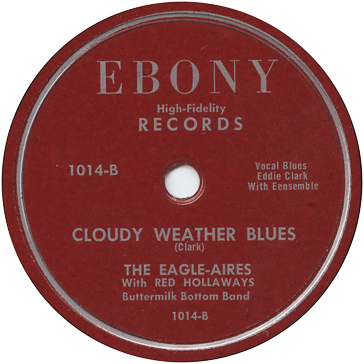
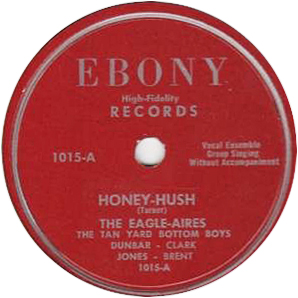
The Eagle-Aires: Robert Dunbar (voc); Eddie Clark (voc); ... Jones (voc); ... Brent (voc); unidentified accompaniment.
Chicago, prob. 1954
| 1015-A | Honey-Hush (Turner) | Ebony 1015-A | |
| 1015-B | Money Honey (Stone) | Ebony 1015-B |
The second Eagle-Aires release was never picked up by JOB and has consequently remained even more obscure. Since Joe Turner's "Honey Hush" was recorded and released in 1953, and the record also testifies to Mayo Williams' continuing fascination with "Money Honey," first released by the Drifters in September 1953, we can be pretty sure about the date. The copy of 1015 in the collection of the late George Paulus is the only one known to survive.
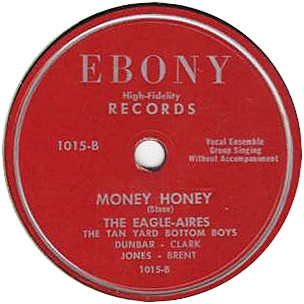
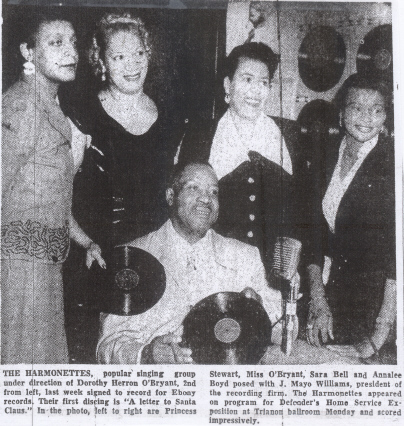
The Harmonettes: Dorothy Herron O'Bryant, Princess Stewart, Sara Bell, Annalee Boyd (voc.)
Chicago, October 1954
| A Letter to Santa Claus | Ebony [?] | ||
| unidentified titles | Ebony [?] |
The Chicago Defender for October 9, 1954 ran a photo of J. Mayo Williams with his new recording group, the Harmonettes. This was a female gospel group under the direction of well known gospel impresario, Dorothy Herron O'Bryant; it had been around since the late 1940s. The group was reported to have been signed by Williams the previous week to record "A Letter to Santa Claus."
We don't know whether this record actually saw release. In the photo both Dorothy O'Bryant and Mayo Williams are holding Ebony 78s, but the label copy cannot be read. Note how all of the Ebony records on the wall behind them are 78s.
We are still looking for a Harmonettes single on 78 rpm. Meanwhile, we've recently received confirmation that the Harmonettes did appear on at least one Ebony release—a 10-inch LP!
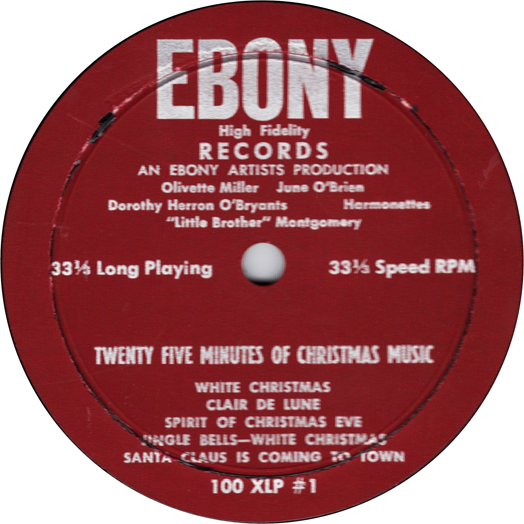
Chicago, probably Fall 1954
The late George Paulus discovered a 10-inch LP on Ebony. This is probably the only LP release that Mayo Williams was involved with—but who knows what other riches and curiosities are hiding somewhere?
Because of the presence of the Harmonettes, who were recording Christmas songs in October 1954, we're figuring that this LP was intended for release in time for Christmas 1954.
The artists on the LP were:
We'd like to provide more details, but first we have to establish who performed on each title. Different artists are listed on Sides 1 and 2. But the lists aren't very helpful: Olivette Miller is mentioned only on Side 1 and "White Christmas Vocal (Concert Harp)" is on Side 2.
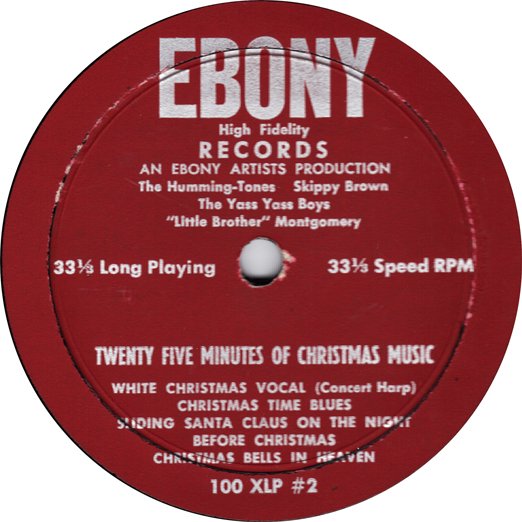
The LP labels give the title as Twenty Five Minutes of Christmas Music and the titles are as follows:
| 100 XLP #1 | White Christmas | |||
| Clair de Lune | ||||
| Spirit of Christmas Eve | ||||
| Jingle Bells-White Christmas | ||||
| Santa Claus Is Coming to Town | ||||
| 100 XLP #2 | White Christmas Vocal (Concert Harp) | |||
| Christmas Time Blues | ||||
| Sliding Santa Claus on the Night before Christmas | ||||
| Christmas Bells in Heaven |
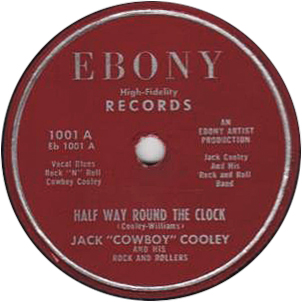
Original recording on %: Tab Smith (as, dir); other musicians unidentified; overdubbing: Jack Cooley (d). Original recording on ^: Jack Cooley (d, voc); others unidentified.
Original recording on %: Beltone Studio, New York City, August 1945; overdubbing, Chicago, 1954 or 1955; Original recording on ^: Chicago, 1945; overdubbing not attested.
| EB-1001-A | Half Way Round the Clock (Cooley-Williams)^ | 20th Century 20-50 (no overdubbing) Ebony 1001 A (status to be verified) |
|
| EB-1001-B | Cooley's Cowboy Rock (Smith-Williams)% | Harlem 1023 A (before overdubbing) 20th Century 20-45 (before overdubbing) Ebony 1008 B (with overdubbing) Ebony 1001 B (with overdubbing) |
Jack Cooley was a singing waiter in Chicago who also played drums. He often wore cowboy hats and liked to perform numbers with titles like "Mr. Two-Gun Pete." Cooley enjoyed steady work in the South Side clubs from 1944 until 1960. Though never a recording star, or any kind of name entertainer outside of Chicago, he managed to get himself on record frequently. Cooley, as we can see above, was on Williams' talent roster back in 1945. He next recorded for Mercury with pianist Albert Ammons; for Hy-Tone (on a record so rare it didn't get public notice till 2018); for Apollo (as a member of Israel Crosby's Quartette with Buster Bennett); for the tiny Square Deal label (1948 or 1949); for his own C&G label (1950); for Nashboro (1951 or 1952), and (as close as he was going to get to the big time) for States (1953).
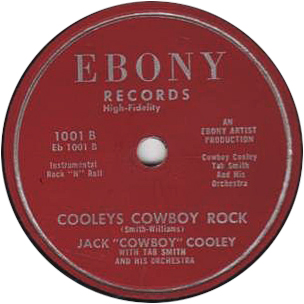
The heavy rock and roll promotion attendant on this Ebony 1001 indicate a release in 1955 or 1956, later in Ebony II's run. Williams would not have been able to get Tab Smith's band into a studio then, because Smith was under long-term contract to United. So instead he recycled a 1945 recording by Tab and band, overdubbing Cooley on drums. This overdubbed creation had already appeared a year or so earlier, as the B side to Ebony 1008. The original Tab Smith instrumental was released on Harlem 1023 A and 20th Century 20-45 as "Granny Dodging at the Savoy."
"Half Way Round the Clock" appears to date from 1945. One number by Cooley appeared on Chicago 100/101, then a couple of years later, 20th Century 20-50 came out, with newly applied matrix numbers. However, it was split between Cooley and Ann Sorter McCoy, just as Chicago 100/101 had been. So the source for Side A is clear. We have not heard this Ebony 1001 so we don't know if any overdubbing was done on the A side.
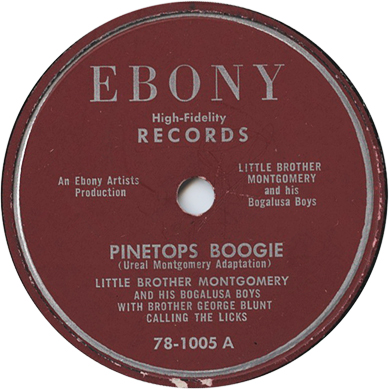
Eurreal "Little Brother" Montgomery (p, voc on %); Ransom Knowling (b); Booker T. Washington (d); George Blunt (shouts on ^).
Chicago, 1957
| EB 1005 A | Pinetops [sic] Boogie ("Ureal [sic] Montgomery Adaptation")^ | Ebony 1005 A, Ebony [III] 45 1005 A | |
| EB 1005 B | Arkansas Blues: Vocal Southbound Special (Williams-Montgomery)% | Ebony 1005 B, Ebony [III] 45 1005 B |
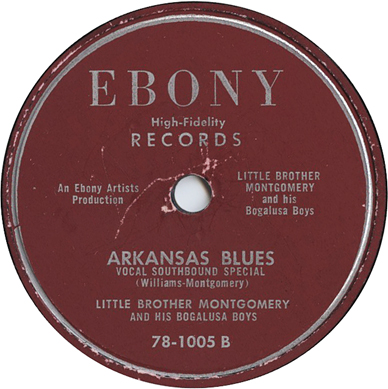
When Williams recorded Little Brother Montgomery he was calling on the services of a veteran blues performer, whose discography extended all the way back to 1930. Montgomery's piano technique was intact, and he performed well on a number of 1950s sessions, including this one and his 1953 outing for JOB.
The bassist and drummer are as identified in Fancourt and McGrath's Blues Discography 1943-1970. Fancourt and McGrath place the session in 1956. However, a Chicago Defender blurb from 1957 hyperbolically announces that Montgomery's new recording of "Pinetop's Boogie" is a hit.
Sonically, both sides of Ebony 1005 are definitely from the 1950s. Washington's well-recorded drums practically surround the piano in the sonic image.
This 78 was reissued on a 45 with the same titles, credits, and issue number.
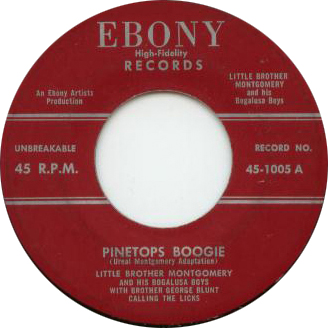
Eurreal "Little Brother" Montgomery (p, voc on %); Ransom Knowling (b); Booker T. Washington (d); George Blunt (shouts on ^).
Chicago, 1957
| EB 1005 A | Pinetops [sic] Boogie ("Ureal [sic] Montgomery Adaptation")^ | Ebony [II] 1005 A, Ebony 45 1005 A | |
| EB 1005 B | Arkansas Blues: Vocal Southbound Special (Williams-Montgomery)% | Ebony [II] 1005 B, Ebony 45 1005 B |
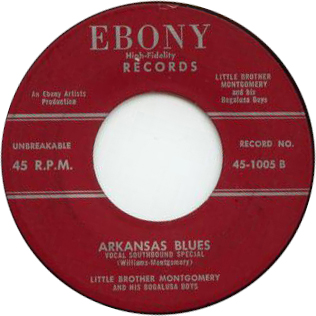
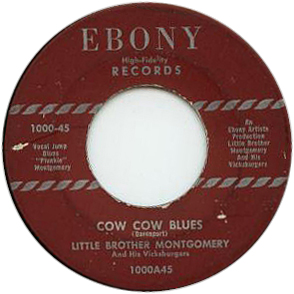
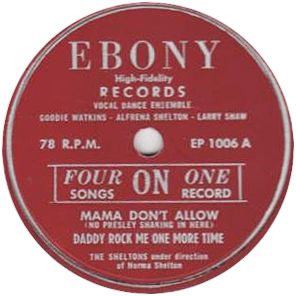
Goodie Watkins (voc ^); Alfrena Shelton (voc ^); Larry Shaw (voc ^); The Humming Tones (vocal group); acc. by Norma Shelton (p, dir); other musicians unidentified.
Chicago, 1956 or 1957
| EB 1006 A | Mama Don't Allow (No Presley Shaking in Here)^ | Ebony EP 1006 A | |
| Daddy Rock Me One More Time^ | Ebony EP 1006 A | ||
| EB 1006 B | Rain Drops Are Falling | Ebony EP 1006 B | |
| Concentrate Baby | Ebony EP 1006 B |
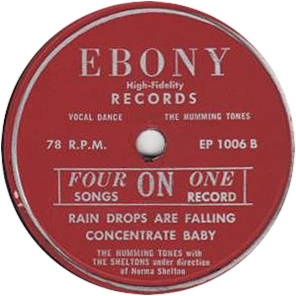
Norma Shelton, who was born in Kentucky and moved to the South Side of Chicago in 1912, played piano and began leading a group called the Rhythm Boys in the early 1930s. Williams had already recorded her with the Rhythm Boys on the Lillian Campbell single (this was the second Ebony 1010, recorded in 1953; see above). The reference to Elvis Presley makes 1956 the likely date of recording as well as release.
The Shelton Sisters were three of Alfred and Norma Shelton's daughters; they often performed with their mother's combo during this period.
Norma Shelton died in November 1972. We are indebted to Karen Shelton, her great-granddaughter, for basic information about her life and work (email communication, March 30, 2009).
Goodie Watkins, who sings on "Mama Don't Allow," was by this time a veteran of the South Side club scene. For instance, the Board meeting minutes of Musicians Union Local 208 list her as appearing at Mickey's Tavern and the Q Lounge in November 1948; she filed contracts for an indefinite period at the Q and 3 nights at Mickey's on November 18. Watkins posted an indefinite contract with Ralph's Club on January 6, 1949. In April, she moved to Sago's Lounge, posting an indefinite contract on April 21. In July she was holding down a gig at the Boogie Woogie Inn (indefinite contract accepted and filed on July 7), plus a one-day fill-in at the Bon Air Lounge (posted July 21).
Watkins posted another indefinite contract with Ralph's Club on January 5, 1950. On October 19 of the same year, Watkins posted an indefinite contract with the Boogie Woogie Inn. On July 5, 1951, she posted an indefinite contract with the Caldonia Lounge, and on September 6, 1951, an indefinite contract with Phil's Lounge. On June 19 and July 3, 1952, she posted indefinite contracts with the 317 Club, followed by another on December 4. In March 1953, she was back at Ralph's Club, posting an indefinite contract on March 5, and following up with another for 2 weeks on June 4. She also picked up a gig at the 34 Club (indefinite contracts accepted on June 4 and 18, 1953, plus another for 3 nights on July 2). In August Watkins was at the 317 Club (indefinite contract posted on August 20, 1953 for a gig that began on the 7th). On November 5, 1953, she posted an indefinite contract with the New Look Lounge, following with another on December 17. On April 1, 1954, she posted an indefinite contract with the Ship Show Lounge, renewing it on June 17. In July she moved to the 2600 Club (indefinite contract accepted and filed on July 15). On April 7, 1955, she filed an indefinite contract with the Happy Home Lounge. On June 2, 1955, Goodie Watkins posted a contract for a gig of indefinite length at Club 34; in July she moved to Club 26 (indefinite contract filed on July 7). On January 5, 1956, she posted an indefinite contract with a joint called the Big Top Hat. We are not aware of any other recordings by Goodie Watkins.
In 1957, Mayo Williams made an abrupt shift from producing 78s only to producing 45s only.
Two of these 45s ("Pinetops Boogie" b/w "Arkansas Blues" by Little Brother Montgomery, and "Romance-Time" b/w "Tabs Rocker" by Tab Smith) corresponded to existing 78s. Otherwise, however, release numbers already used in the 1000 series for Ebony Is or IIs were reassigned, and new issues appeared on 45 rpm only.
Little Brother Montgomery (voc, p); Oliver Acorn (ts); Jack Cooley (d)
Chicago, 1957
| EB-1000-A | Cow Cow Blues (Davenport | Ebony 1000A45 | |
| EB-1000-B | Vicksburg Blues | Ebony 1000B45 |
Little Brother Montgomery was extensively recorded during the 1950s. However, a lot of his output consisted of home taping not released until much later. Fancourt and McGrath give this session a 1956 year, but the say the same of the "Pinetop's Boogie Blues" session, which we now know was done in 1957. So the later date is a safer bet.
From here on out, all Ebony releases would appear on 45 rpm only.
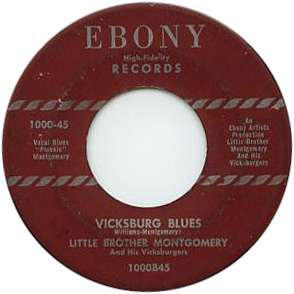
Just two confuse matters further, Williams decided to mix and match one side from Montgomery's Ebony 1005 with another previously unreleased side from the same session. And he put them on another ... Ebony 1000.
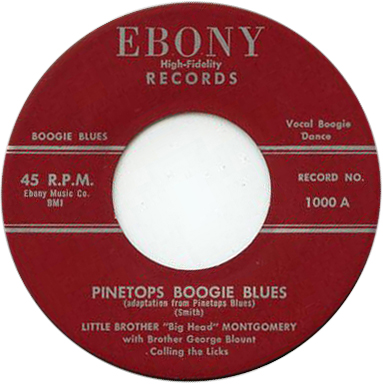
Little Brother Montgomery (p, voc); Ransom Knowling (b); Booker T. Washington (d); George Blunt (shouts)
Chicago, 1957
| EB-1000-A | Pinetops [sic] Boogie Blues (Smith)^ | Ebony 1000A | |
| EB-1000-B | Cow Cow Blues (Davenport) | Ebony 1000 B |
Robert Stallworth says, "This is a different recording than the above mentioned 'Cow Cow Blues.' The arrangement and instrumentation is very different. This version has 'shouts' occasionally in the background. It is possible, in fact, that the "Cow Cow Blues" listed here was really done with the same lineup as the "Pinetop's Boogie" and "Arkansas Blues" covered above under Ebony II.
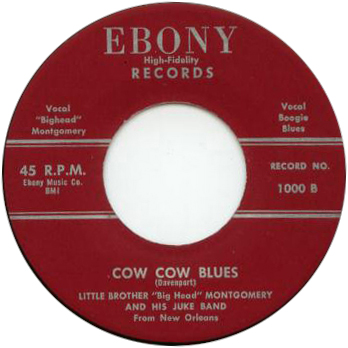
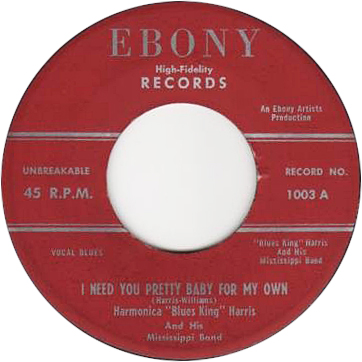
Alfred Harris (hca, voc); unidentified (eg); unidentified (eg); unidentified (d).
Chicago, 1956 or 1957
| 45 EB 1003 A | I Need You Pretty Baby for My Own (Harris-Williams) | Ebony 1003 A | |
| 45 EB 1003 B | Blues King Mango ("Duke Iron Arrangement") | Ebony 1003 B |
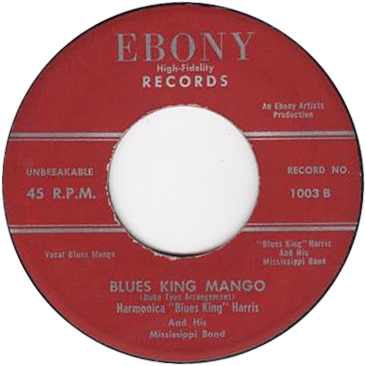
Alfred Harris could sing in the manner of B. B. King. He often billed himself as "Blues King," where King was meant as a surname, not a title. He had previously cut one track in Memphis for Modern. His best-known session was an outing he shared drummer James Bannister for States, on August 9, 1954. At the time, Harris was holding down a 6-month gig at the Be-Bop Lounge (contract posted with Local 208 on June 17, 1954); guitarist Earl Dranes, who had been working at the Be-Bop, was also on the session. in March 1955, Harris was working the H & H Tavern (contract for 6 weeks posted on March 20). The Ebony session, for which the details remain obscure, seems to have been done in 1956 or 1957. Harris dropped completely off the Chicago scene in 1959, and his subsequent movements remain unknown.
An unusual feature on this release is the Calypso number on Side B. Calypso enjoyed a niche market in the African-American community during this period. Williams' colleague Joe Brown recorded three different Calypso singles by drummer Zona Sago for release on JOB; in 1956 Sago made one further single for the Chess brothers' Argo subsidiary.
Fancourt and McGrath list this session, putting a 1956 date on it. According to them, the other instruments on the session were guitar and drums.
Joe Bell (b), with prob. Bobby "Jazzy" Blevins (p); Oliver Sain (ts); Little Gates (d); Jimmy Petty (voc); Rupert Jones (voc); The Senders (voc).
Chicago, 1957
| EB-1014-A | Down Stairs (Breeze) | Ebony 1014-A | |
| EB-1014-B | Pack Your Rags and Go (Breeze) | Ebony 1014-B |
We haven't heard "Down Stairs," and are guessing at the band, based on the makeup of Cool Breeze's working ensemble during this period. According to some sources, Frank Butler was the lead vocalist on "Down Stairs." Jimmy Petty, Rupert Jones, and the Senders are mentioned on the label. Obviously the vocal credits stand in need of straightening out.
Joe Bell (b), with prob. Bobby "Jazzy" Blevins (p); Oliver Sain (ts); Little Gates (d); Jimmy Petty (voc); Rupert Jones (voc); The Senders (voc).
Chicago, 1957
| EB-1015A | Won't You Come in and Spend the Day with Me | Ebony 1015A | |
| EB-1015B | Little Bitty Girl | Ebony 1015-B |
Again, we're assuming Bell's lineup from the fall of 1957, and we're not sure whether Frank Butler sang on one of these sides.
Bass player Cool Breeze had had a long career before he made these sides for Williams. He was born Fred Walker, went by the name of Joe Bell, but in public was always known as "Cool Breeze." He began his career in 1939 in a rhythm vocal group called the Five Breezes, which got its first work at Martin's Corner (1500 West Lake). Other members of the group were bass player Willie Dixon, Willie Hawthorne, Gene Gilmore, and pianist/guitarist Leonard Caston. They recorded for Bluebird in 1940. The group broke up in 1942, when Willie Dixon was imprisoned for resisting the draft.
By 1947, Bell, now the bass player in the groups he participated in, was leading a group called the Three Breezes, working regularly on the club scene, most notably playing at the Subway Lounge (3525 South Indiana). The following year his group had beefed up under the name Cool Breeze and His Four Breezes, playing at Little Joe's 217 Club (217 E. 35th) and for six weeks at the Brookmont Lounge (3935 Michigan). In December 1947, Cool Breeze got to sing on one of Chicago All-Stars sessions for Columbia, but his feature numbers weren't released.
In April of 1949, the group was playing at the Hob-Nob Lounge (5358 Wentworth) with a lineup of Joe Bell on bass, Eddie "Sugarman" Penigar on piano, Cyril "Cozy" Eggleston on tenor sax, and Rudy Pernell on drums. The presence of this stellar cast of musicians indicates that the Bell's group had evolved from a rhythmic vocal group into a straight jazz combo.
The following year they were at the L-Bow Lounge (55th and Michigan). By 1952, the size of the group was indeterminate, under the billing of Cool Breeze and His Breezes; they were playing at Little Joe's Hi-Hat Club (6223 Cottage Grove).
In 1953, Cool Breeze and his group were playing at the Grove Circle Inn (61st and Cottage Grove). Bell also played bass on a Willie Mabon session for Chess, though there is no reason to think that he joined Mabon's group. In July Cool Breeze and His Four Breezes had just completed a tour of the East and were playing at the Club 34 (3117 West Roosevelt). The Chicago Defender reported that they were recording for United at this time (as far as we know, that was not happening), and that the unit consisted of Joe Bell on bass, Cecil Howell on sax, Nate Burton on drums, and Eddie Malone on piano. The group moved to Club Evergreen in October, with a new piano player, Laney McDonald, replacing Eddie Malone. The following year the group was playing at the Savannah Club (350 East 51st). As nothing had materialized with United, during this time Joe Bell put out three releases on his own custom Bell label, some of the sides featuring Frank Butler on vocals.
During the early months of 1957, Bell and his quartet held down a regular gig at Duke Slater's Vincennes Lounge; they were replaced when Richard Ingram's rock and roll band with Johnny Houser returned. From November 1957 through January 1958, Cool Breeze worked as the house band for the newly opened at Sid's 3022 Club (3022 West Madison), being billed as "Cool Breeze and His Recording Band." Members were listed as Bobby "Jazzy" Blevins (piano), Oliver Sain (sax), Cool Breeze (bass), and Little Gates (drums). This was probably the group that made these four sides for Williams. The identity of the Senders is unknown.
In May 1958, the group was back to Club 34, and Bell was supported by Johnny Cameron on tenor sax, Laney McDonald on piano, and Bob Shropshire on drums.
Vocalist Frank Butler recorded a single on Mel London's Chief label in 1957. Year later, in 1970, Butler would make a couple of records for Jimmy Bracken's feeble attempt to get back into the music business after the collapse of Vee-Jay Records: one for Bracken's Ra-Bra label, and another for his J. V. label.
Lil Palmore (voc) with Verna "Baby Sis" Rogers (voc); Little Brother Montgomery (p); Lee Roi Nabors (tp); others unidentified.
Chicago, 1959
| EB-1001-A | One Way Love (Welch-Williams) | Ebony 1001-A | |
| EB-1001-B | Michigan Water Blues (Williams) | Ebony 1001-B |
Lil Palmore was used just on vocals, leaving Little Brother Montgomery to do the keyboard work.
Archie Taylor (voc); Little Brother Montgomery (p); others unidentified.
Chicago, c. 1959
| Clear Water Frog (Taylor-Johnson) | Ebony 1002 A | ||
| Hot Diggitty Dog | Ebony 1002 B |
This Ebony 1002 appears to come from the last days of Ebony II. There is a transitional label design not seen on other releases, and the involvement of the Continental Jazz Band puts the recording around 1959.
Bill Lacey (voc -1); June O' Brien (voc -2); Lil Armstrong (p); others unidentified.
Chicago, 1959
| EB-1010-A | Cowboy Santa Claus (High) -1 | EB-1010-A-45 | |
| EB-1010-B | Rudolph the Red Nosed Reindeer (Arr. Armstrong) -2 | EB-1010-B-45 |
With this Christmas record, Mayo Williams was on his fourth Ebony 1010. Bill Lacey had previously sung on another Ebony release; June O'Brien was a White pop singer. There is no composer credit on "Rudolph" (did Williams really think it was traditional?) but Lil Armstrong is credited with arranging it.
Jimmy Blazer (voc) with ts, org, g, b, d, sound effects / Lil Palmore (v) with Jimmy Blazer (voc), tp, ts, Little Brother Montgomery (p), b, d
Chicago, late 1958 or early 1959
| EB-1004-A, K-3607X | Hey Bartender | Ebony 1004-A, Trend 30-018 | |
| EB-1004-B, K-3609X | One Way Love | Ebony 1004-B, Trend 30-018 |
This Ebony release was picked up by Trend; since Trend 30-016 was advertised in November 1958, the sessions took place in late 1958 or early 1959. The Trend release has an artist title that sounds like it came from a Williams project.
Lil Palmore, under her Cal Palmer moniker, is used just on vocals, leaving Little Brother Montgomery to do the keyboard work.
In 1959, Ebony II came to a sudden end. Williams became ill and had to suspend his record business for some months.
The third and final incarnation of the Ebony label opened in 1959, still at the same business address. Ebony III was a 45-rpm label, although some of the releases were EPs and one even got a miniature LP cover. Ebony III was still active in the late 1960s and the last release was probably the memorial to Louis and Lil Armstrong, in 1971. While there was a flurry of new recording from 1959 to 1962, of course Williams was also continuing to repackage items from both previous incarnations of the label. And, of course, he was, once again, reusing the 1000 series.
Williams was away from the record business for a while in 1959. In July 1959, the "Nosey Says" gossip column in the Defender mentioned that Williams "hospitalized recently has recovered sufficiently to be back at his office in the South Center Building." A month later, the columnist reported in the August 5 edition that "J. Mayo Williams, former football great at Brown University now in the record business is all set to release new and revised discs of oldies that were favorites years ago." There does appear to have been a minor surge of activity on Ebony during 1959-60. Williams led off with a release by Lil Palmore, who was now calling herself Cal Palmer.
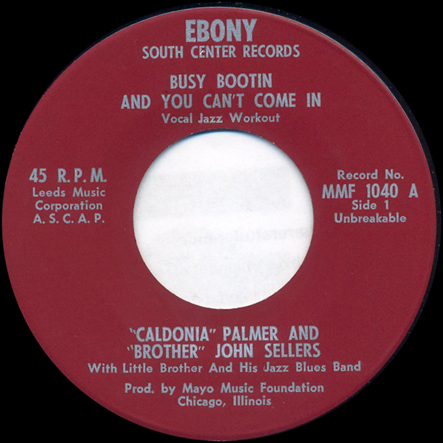
Lil Palmore (voc) with John Sellers (voc-1), Le Roi Nabors (tp), Little Brother Montgomery (p); Robert Lockwood Jr. (rg); Ransom Knowling (b); Jack Cooley (d)
Chicago, 1959
| EB-1040-A | Busy Bootin and You Can't Come In -1 | Ebony MMF 1040 A | |
| EB-1040-B | Michigan Water Blues^ | Ebony MMF 1040 B |
Lil Palmore was again used just on vocals, leaving Little Brother Montgomery to do the keyboard work. What is probably a reissue of this "Busy Bootin" appeared on Ebony 1095; 1095 credits the release to Brother John Sellers but mentions Cal Palmer on the label.
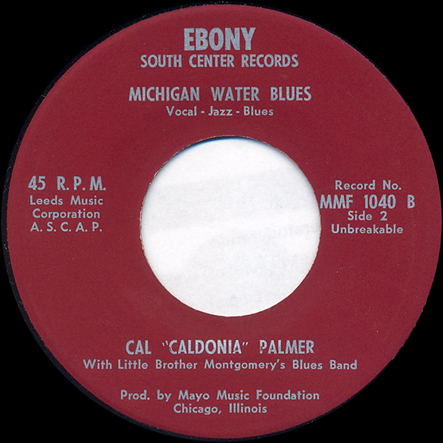
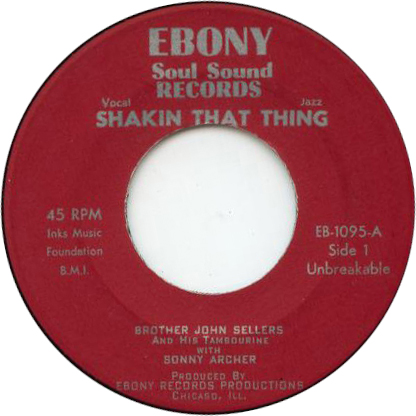
John Sellers (voc -1); Sonny Archer (-1); Lil Palmore (voc -2) Le Roi Nabors (tp); Little Brother Montgomery (p); Robert Lockwood Jr (eg); Ransom Knowling (b); Jack Cooley (d)
Chicago, 1959
| EB-1095-A | Shakin That Thing -1 | Ebony 1095-A | |
| EB-1095-B | Busy Bootin -2 | Ebony 1095-B |
Brother John Sellers first recorded for Williams in 1945, when a side was released on the Southern label, and two sides appeared on Queen, an imprint of King Records in Cincinnati. He did extensive recording afterwards for a number of labels, before reappearing on Ebony.
Sellers was born May 27, 1924 in Clarksville, Mississippi. While in the South he performed in Minstrel shows, but by the early 1940s in Chicago Sellers was singing gospel with Mahalia Jackson. As John Sellers he recorded blues for the Southern and King labels during 1945, for the RCA Victor label in 1947 (backed by Willie Dixon), and for King Records again in 1951. As Brother John Sellers he recorded gospel for Miracle in 1947 and 1948. He joined John "Schoolboy" Porter, recording two blues sides for Chance in May 1952. His next session for Chance was a marathon--eight sides in November, all blues--backed by the band of local trumpet player King Kolax.
After his Chance sessions, Sellers moved to New York and became involved in the folk club scene (apparently coming back to Chicago for this Ebony release). He built a career on the same model as Big Bill Broonzy, Josh White, and the Reverend Gary Davis, presenting a repertoire that melded folk, blues, and gospel. He made LPs for Vanguard (1954), British Decca (1957), and Monitor (1959). Sellers died on March 27, 1999, in New York.
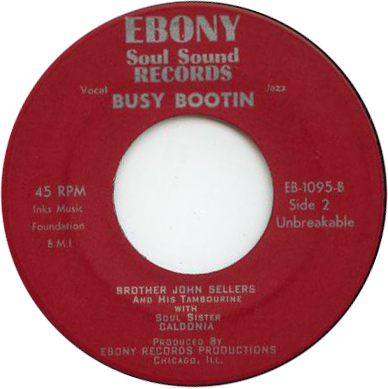
Lil Hardin Armstrong (voc, p); Oscar Brown Jr. (voc); Little Archie Taylor (voc); Lee Roi Nabors (tp); others unidentified.
Chicago, 1959
| EB-1015-A | Memphis Man -1 | Ebony 1015-A | |
| EB-1015-B | Teen-Age Love -2 | Ebony 1015-B | |
| K-3608X | Let's Have A Ball (Ants in My Pants) (Williams-Williams) -3 | Trend 30-017 | |
| K-3600X | Little Louise (Pullen) -4 | Trend 30-017 |
Williams established another alliance, the last one we know of, with a label called Trend. Trend was a subsidiary of Kapp, which in turn was named after Williams' boss when he worked at Decca, Jack Kapp. The alliance seems to have been responsible for two releases on Trend.
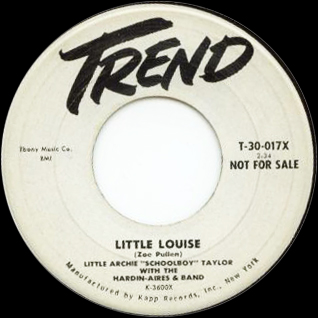
Pianist-singer Lil Hardin Armstrong was of course not unknown to Williams, who recorded her regularly while he was at Decca in the 1930s. She was born Lillian Hardin in Memphis on February 3, 1898 (or was it 1902?). She got her formal musical training at Fisk University, and moved to Chicago in 1917. There she worked as a songplugger and in various legendary bands of the Jazz Age: Freddie Kepppard, King Oliver, Sidney Bechet, and finally with Louis Armstrong (whom she married in 1924). She made the first session under her own name in 1926, recording a thinly disguised version of her husband's Hot Five as Lil's Hot Shots. Her most extensive recording period was for Decca, in six sessions during 1936-40, under Mayo Williams' aegis. In the immediate postwar years, made three sessions in Chicago for Black & White (1945), Eastwood (1947), and Gotham (around 1950). Then she was off to Paris, where she worked during the early 1950s.
Armstrong returned to Chicago in the fall of 1956, where she resumed her residence and her career. She worked on both the North Side clubs and the South Side clubs. Ms. Armstrong found herself entertaining at private parties, such as the one in July 1957 celebrating deejay Freddie Williamson's birthday, where she "played and sang a score of her French songs to the delight of the guests."
We do not know when Williams again resumed his connection with Armstrong, but Lord gives the date of the "Memphis Man" session as 1959. He places one side of the Trend release on the same session, but we see no reason why both sides should not be there. This may have been shortly before she put together a sizable group, the "Continental Band," which included Roy Lang (trombone), Eddie Lynch (guitar), Chris Clifton (trumpet), Odell Rand (clarinet), and Jasper Taylor (drums). Ms. Armstrong later cut two albums for Riverside during 1960-61. She made a dramatic life exit on August 27, 1971, when she collapsed and died while performing at a Louis Armstrong tribute concert.
Oscar Brown Jr. was born October 10, 1926 in Chicago, the son of a lawyer. After working as a disc jockey in the early 1950s and serving in the U.S. Army from 1954-56, he entered the world of performing arts. His interest was in writing songs with a social or political theme, and he often presented them in self-written, self-directed musical plays. Brown's music touches on the world of jazz, folk, and soul, often putting lyrics to jazz instrumentals. We reported that Brown first recorded for Tommy Jones' Mad Records in 1960. This Ebony release may actually predate the Mad.
The politically active Brown ran unsuccessfully for a seat in the Illinois legislature on one occasion, and for Congress on another. Although his recording career ended in the 1970s, he continued to perform and act in plays and cabaret performances, sometimes working with his daughter, singer Maggie Brown. Oscar Brown, Jr., died in Chicago on May 29, 2005, after a brief illness.
Oscar Brown Jr. was survived by four daughters and one son. A second son, Oscar Brown III, played bass and piccolo bass with Phil Cohran's Chicago-based ensembles and with the Sun Ra Arkestra of the 1980s. Oscar Brown III died in the late 1990s.
Jimmy Oden (voc) with Ltttle Brother Montgomery (p); unidentified (b); unidentified (d).
Chicago, unknown date (see below).
John Estes (voc, g); Son Bonds or Charlie Pickett (g). %
New York City, April 22, 1938.
| EB-1000-A | Going Down Slow (Oden) | Ebony 1000 A | |
| EB-1000-B | Some Day Baby % | Ebony 1000 B |
Maddeningly, Mayo Williams was now duplicating release numbers virtually at will, within an incarnation of his label. So how many different singles were issued as Ebony 1000?
"Going Down Slow" was first recorded by St. Louis Jimmy in 1941, for Bluebird. He cut some sides for Decca in the late 1930s while Mayo Williams was there, but what became his signature number was not included among them. However, "Going Down Slow" was one of three titles that Oden recorded for Southern in December 1945 (Fancourt and McGrath say these were done in Chicago, but the master numbers are in the UN series, indicating that they were done in New York). Southern didn't release them; the were leased to King, and King assigned its own master numbers but didn't release them either. Obviously, the 1945 version of "Going Down Slow" would have been available to Mayo Williams. Of course, we don't know who accompanied him on it. Williams could also called Oden back and made a new recording in the late 1950s with Little Brother Montgomery—Oden ended up redoing the piece many times. To be researched...
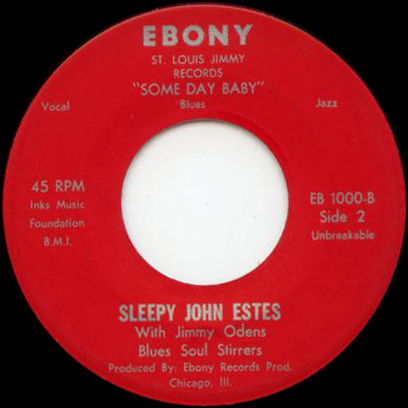
We can be a little more definite about the Sleepy John Estes side. "Some Day Baby" is actually "New Someday Baby," released on Decca in 1938. The original matrix number was 63652-A and the first release was on Decca 7473. Fancourt and McGrath place this Ebony release somewhere between 1956 and 1960; from the style of label employed, we estimate it was later. Fancourt and McGrath put the same Estes side on a release from around 1964, where Hammie Nixon and other musicians were brought in for overdubs.
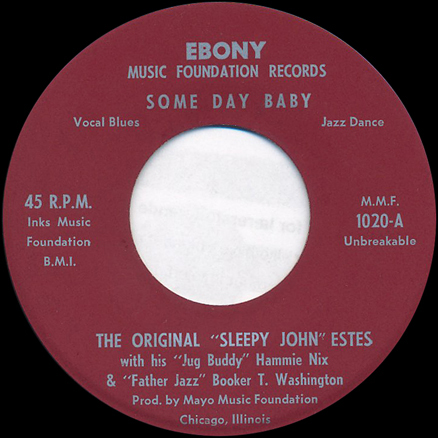
Sleepy John Estes (voc, g), Son Bonds or Charlie Pickett (g); overdubbed: Hammie Nixon (jug, hca); Booker T. Washington (d).
New York, April 22, 1938; overdubs recorded Chicago, 1964.
| EB-1020-A | Some Day Baby | Ebony M. M. F. 1020-A | |
| EB-1020-B | Sleepy John's Blues | Ebony M. M. F. 1020-B |
This is actually the original Decca recording of "New Someday Baby" b/w "Brownsville Blues," released on Estes in 1938, to which Williams added harmonica, drums, and reverb. According to Dixon, Godrich, and Rye, the original Decca matrix numbers were 63652-A and 63653-A, and both sides were originally released on Decca 7473.
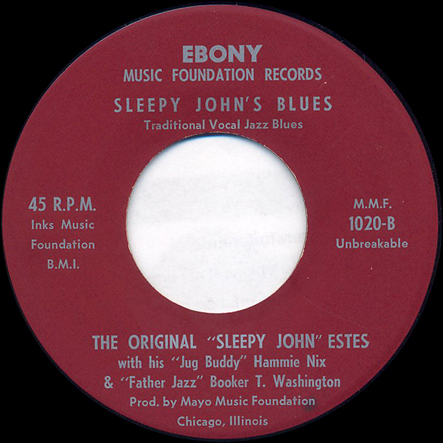
Hammie Nixon recalled the circumstances to interviewer Jim O'Neal: "That was when we come back—we had just come back from overseas [on the 1964 American Folk Blues Festival]. He took us right there to his office on 47th Street, didn't he? Same place we did back in the 1930s, where he took us. He had some pictures took. Man, they took pictures for about three or four days. He said we had a whole lot of money or something, and he gon' get it for us, but we didn't get it." (Nixon's recollection of recording in Chicago seems to pertain to a 1935 session for Decca, not the 1938 session at which these tracks were originally laid down.)
David Alexander (voc, p) with Hammie Nixon (hca -1); Booker T. Washington (d)
Chicago, date unknown
| EB-1005-A | Sweet Patootie | Ebony 1005-A | |
| EB-1005-B | Dupre Blues | Ebony 1005-B |
This item has often been listed as a late 1940s product (i.e., an Ebony I) but we suspect that it is in fact a 45-rpm release from the mid-1960s on Ebony III. It wouldn't hurt to see a copy, now would it?
Fancourt and McGrath's Blues Discography reports that these are probably overdubbed prewar masters. This may well be, but Alexander is not listed either in Dixon, Godrich, and Rye, or in Lord. As we so frequently say, to be researched...
Tommie Malone (voc) with Cee Pee Johansen, Ben Hughes, Bill Reese, Little Arch (Archie Taylor) (shake calling -1)
Chicago, c. 1960
| Ebony 1055-A | Cow Cow Shake -1 | Ebony 1055-A | |
| Ebony 1055-B | Worried Life | Ebony 1055-B |
Fancourt and McGrath give a date of 1960 for the release, and do not identify the musicians, only saying that the lineup consists of tenor sax, piano, guitar, bass, and drums. Malone had made an earlier recording with Reese on the Pennant label, in 1955.
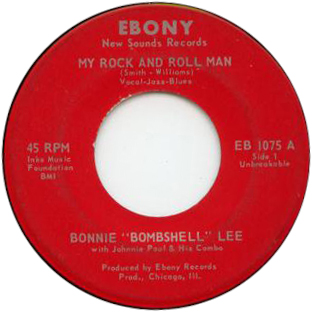
Side A: Bonnie Lee (voc) and unidentified (d) overdubbed on Trixie Smith (voc); Charlie Shavers (tp); Sidney Bechet (cl); Sam Price (p); Teddy Bunn (g); Richard Fullbright (b); O'Neill Spencer (d); Side B: prob. Billy Ford (tp); unidentified (ts); Jimmy Reece (org); unidentified (eg); unidentified (eb); unidentified (d).
Side A: New York City, May 26, 1938; overdubbed in Chicago, c. 1960; Side B: Chicago, c. 1960
| EB-1075A | My Rock and Roll Man (Smith-Williams) -1 | Ebony 1075-A | |
| EB-1075B | Shakin the Blues Away (Ford-Williams) -2 | Ebony 1075-B |
Ebony 1075 was apparently released only on 45 rpm (with "New Sounds Records" and "Inks Music Foundation" on the label), so Bonnie Lee wasn't toting any copies that particular day. It's just as well that Koester didn't give 1075 A a spin. The Smith in the composer credits was Trixie Smith, who made her first blues recording in January 1922, and was making a comeback in 1938 when she recorded "My Daddy Rocks Me" for Decca (matrix 63868-A) with an all-star jazz lineup. (She didn't write "My Daddy Rocks Me," but neither did Mayo Williams). It was the singer's second to last session. Assuming that Williams reused the first "My Daddy Rocks Me"—there were two versions, and both were released—the original 78 was Decca 7469.
Williams' procedure was to overdub Bonnie Lee singing in unison with Trixie Smith, along with a second drummer (no one would have mistaken O'Neill Spencer for a rock and roller). But Sidney Bechet is awfully hard to miss.
The B side was newly recorded, by a soul-jazz ensemble. Billy Ford appears to have been the trumpet player, but the tenor saxophonist gets the solo space. Although Johnnie Paul's group is credited on both sides, the only thing 1075 A and B have in common is maybe the same drummer.
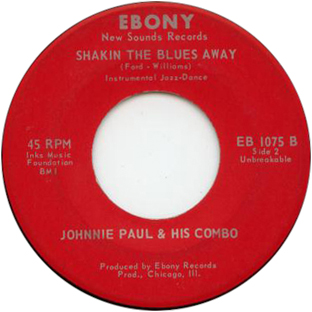
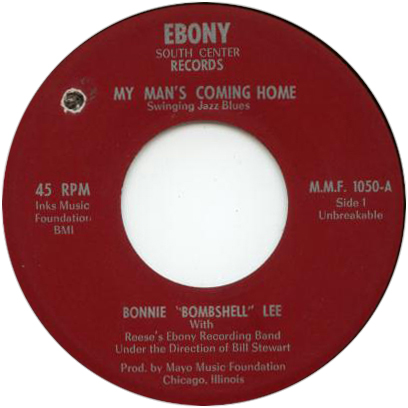
Bonnie Lee (voc); Jimmy Reece (org); unidentified (ts); unidentified (d).
Chicago, c. 1960
| 1050A | My Man's Coming Home | Ebony M. M. F. 1050-A | |
| 1050B | Fast Life | Ebony M. M. F. 1050-B |
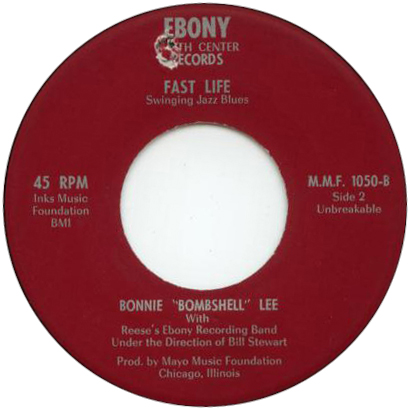
It seems likely that the band on this Bonnie Lee record shares personnel with the band on Ebony 1075 B (see Eb 3-8). But we haven't heard this single.
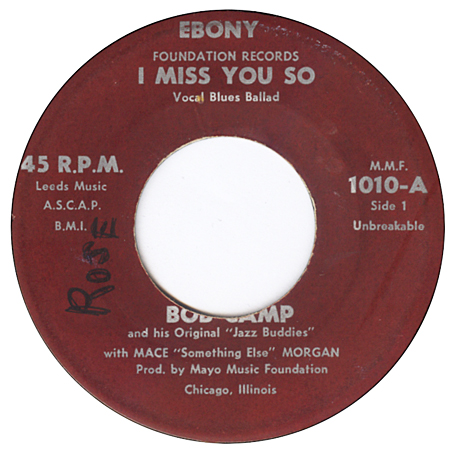
Bob Camp (voc, eg); Mace Morgan (p); unidentified musicians.
Mace Morgan (org).
Chicago, c. 1962
| EB-1010-A | I Miss You So | Ebony M. M. F. 1010-A | |
| EB-1010-B | Save My Love# | Ebony M. M. F. 1010-B |
The A side of this Ebony 1010 is by guitarist-singer Bob Camp, who had been performing in Chicago since 1937, when he was on the bill at the Grand Terrace. During the 1940s, he led a trio that performed regularly at the DuSable Lounge. An old Chicago Defender columnist, Ted Watson, in 1974 fondly remembered how Camp regularly sang "I Miss You So" at the legendary bar, and he remembers hearing it when the Four Seasons had their hit record with "Big Girls Don't Cry," which means 1962. Camp either retained an archaic style of singing on this disk, or it may originally date back to the 1940s.
According to Fancourt and McGrath, Camp had recorded four sides for Williams' Southern label in New York in 1945. While Southern was based in Williams' New York office, our suspicion is that Camp had recorded them in Chicago. In any case, "I Miss You So" was not among the sides released back then.
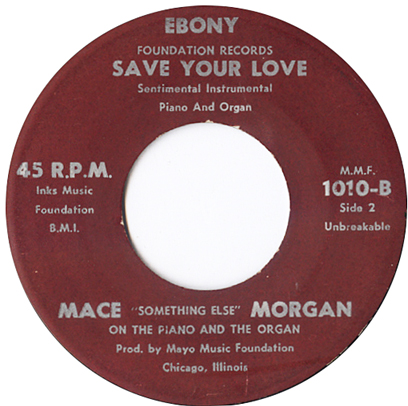
The B side is by organist Mace Morgan. In August of 1962, Williams took out an ad in the Chicago Defender, proclaiming that Morgan would be appearing on a float at the annual Bud Billiken Parade. He credited the four songs above to him (besides the two that appeared on Ebony MMF 1010,"The Monkey and the Baboon" appeared on at least some versions of Ebony EP 105, and we're not quite sure what happened to "Ditty Wah Ditty"). The ad offered free copies of the records to record dealers, rack jobbers, one stops, and tavern deejays. Morgan's playing on this record is about as moving as sludge. We doubt that Williams could even give it away.
By this time Ebony 1010's were multiplying thick and fast. The Camp/Morgan 1010 seems to be a fairly late one, however, because of the Ebony Foundation version of the logo, and the references to the Mayo and Inks Music Foundations.
Bob Camp (voc,g), others unidentified.
Mae Saint Jude (voc), others unidentified.
Chicago, c. 1962
| EB-100-A | Yeah! Yeah! (Let Me Hear You Say Yeah) | EB-100-A | |
| EB-100-B | Jack and Jill Boogie (Pitch a Boogie Woogie)# | EB-100-B |
Despite the departure from the woefully overused 1000 series, this is a single release and not an EP. We have no idea who Mae Saint Jude & Brother Mack were. The Bob Camp release may be a remake from his Southern record back in 1946, or from his 1949 session for Decca, or it may be from the same 1962 session. As always, to be researched...
Bob Camp (voc, g); unidentified musicians.
Chicago, c. 1962
| EB-1062-A/EB-100 [EP] | School Days Love | EB-1062-A, EB-100 [EP] | |
| EB-1062-B/EB-100 [EP] | Jack and Jill Boogie | EB-1062-B, EB-100 [EP] | |
| EB-100 | Walk that Walk | EB-100 [EP] | |
| EB-100 | Hey Little Baby | EB-100 [EP] | |
| EB-100 | Your Still My Mule | EB-100 [EP] |
We have five songs here that might have appeared on an EP. Frankly, though, until a copy of the Bob Camp EP surfaces, we have no idea what songs actually appeared on this release. Fancourt and McGrath have no information either. It wouldn't hurt to see Ebony 1062, for that mattter.
Camp wound down his career as an active musician during the 1960s. By 1969 was working as a "sound man."
In 1962, Mayo Williams gave a major push to an EP whose four track were the work of three different groups. A company with deeper pockets would have counted it for little, but it was surely the biggest publicity effort he had launched since the early days of Ebony II, and he would never try anything comparable again. Williams was apparently convinced that he could ride the twist wave and rack up serious sales. Ebony 105 is known to have appeared in 3 different versions, with different colored labels. Some were evn sold in a special cardboard sleeve (like a miniature LP cover, instead of a paper 45 rpm sleeve). The titles and group identifications are somewhat different on each, so we have listed them separately. However, some (possibly all) of the tracks are identical across all three. So far as we can determine from label styles, the yellow label 105 came out first, followed by the blue label version, and finally the version with the usual dark red label.
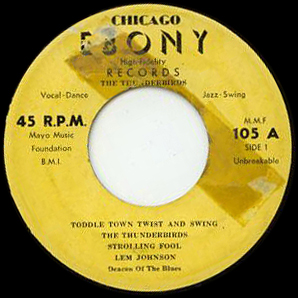
On 1 and 3, The Thunderbirds: Billy Ford (voc); others unidentified / On 2, Lem Johnson (voc); others unidentified / On 4, Chuck Gulley (dir); others unidentified.
Chicago, 1962
| Toddle Town Twist and Swing -1 | Ebony M. M. F. 105 A [yellow label EP] | ||
| Strolling Fool -2 | Ebony M. M. F. 105 A [yellow label EP] | ||
| My Little Girl -3 | Ebony M. M. F. 105 B [yellow label EP] | ||
| Walk That Walk -4 | Eboony M. M. F. 105 B [yellow label EP] |
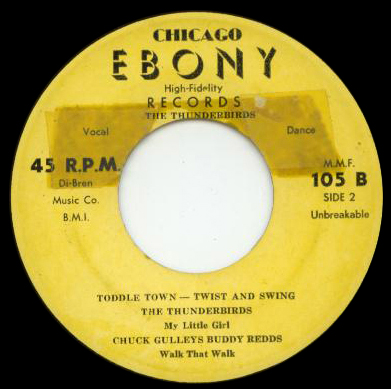
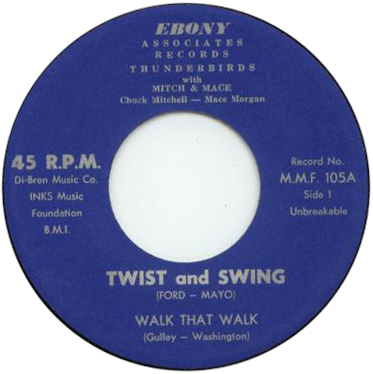
On 1, 3, and 4, The Thunderbirds: Billy Ford (voc); Mace Morgan (org); others unidentified / On 3, Chuck Gulley (dir); others unidentified.
Chicago, 1962
| Twist and Swing (Ford-Mayo) -1 | Ebony M.M.F. 105A [blue label EP] | ||
| Walk That Walk (Gulley-Washington) -2 | Ebony M.M.F. 105A [blue label EP] | ||
| The Monkey & the Baboon (Ford-Mayo) -3 | Ebony M.M.F. 105B [blue label EP] | ||
| Shake and Swing (Ford-Mayo) -4 | Ebony M.M.F. 105B [blue label EP] |
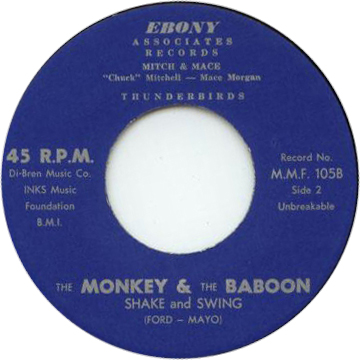
The Thunderbirds: Billy Ford (voc); Mace Morgan (org); others unidentified.
Chicago, 1962
| The Monkey and the Baboon Workout (Ford-Mayo) | Ebony M.M.F. 105 A [red label EP] | ||
| The Monkey and the Baboon Workout (Ford-Mayo) | Ebony M.M.F. 105 B [red label EP] |
Judging from the information on the label (Ebony Foundation Records, with mentions of both the Mayo Music Foundation and the Inks Music Foundation), the red label 105 was the last to be issued. It did not title the tracks individually.
Little Brother Montgomery (v,p), with tp, saxes, bj, b, d, tamb, v grp / Little Brother Montgomery (v, p); Leroi Nabors (ts), Oliver Acorn and other saxes; Robert Lockwood Jr. (eg); b;d; The Hardin-Aires (voc) / Little Brother Montgomery (p), others unidentified.
Chicago, c. 1964
| EB-1030-A | Gonna Raise a Rukus Tonight | Ebony 1030-A | |
| EB-1030-B | In the Evening when the Sun Goes Down# | Ebony 1030-B |
Williams took out an advertisement in the August 3, 1964 Chicago Defender to promote the B side of the disk, as a Little Brother Montgomery release. He tied the ad with Montgomery's appearance at A Touch of Olde club (1257 North Wells) in the "Old Town" nightery district, on the near North Side. The flip shows the Hardin-Aires as the recording artist, but Montgomery is probably playing piano on it.
The ad, which listed five stores where Ebony disks could be found, probably netted out Williams' entire distribution network. He did not employ the services of any real distributor.
Well, he had the South Side covered, and the Near North, but nothing on the West Side.
Montgomery married his second wife, Janet Floberg in 1967, and together they formed the FM (for Floberg and Montgomery) label, on which Montgomery made many recordings. Montgomery made his last sessions in 1982. He died on September 6, 1985, in Chicago.
Bonnie Lee (voc), Jimmy Reece (org), ts, d
Chicago, c. mid-1960s
| EB-1015A | Black But Beautiful | Ebony 1015A | |
| EB-1015B | Fast Life | Ebony 1015-B |
The title, "Black But Beautiful" suggests a later release, perhaps just before Lee resurrected her career in the late 1960s, when she joined with Sunnyland Slim playing the North Side clubs. The "Fast Life" side may well be identical to the one that Williams had already released on Ebony 1050.
In the early 1970s Bonnie Lee recorded several sides for Slim on his Airway label.
Her career was in high gear in the 1980s when she joined the Willie Kent band, performing regularly in the city's North Side blues clubs, then recording albums for Delmark (Sweetheart of the Blues) in 1995, and for Wolf Records (I'm Good) in 1998. She also contributed to a number of Chicago blues compilations, notably Women of Blue Chicago and Chicago's Finest Blues Ladies. Lee died on September 7, 2006.
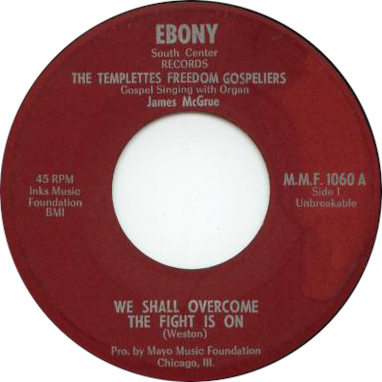
Female group: Juanita Weston (voc); others unidentified; with James McGrue (org), unidentified (p).
Chicago, 1965
| MMF 1060 A | We Shall Ovecome | Ebony M.M.F. 1060 A | |
| The Fight Is On (Weston) | Ebony M.M.F. 1060 A | ||
| MMF 1060 B | Freedom Afterwhile | Ebony M.M.F. 1060 B | |
| If You Want Joy (Weston) | Ebony M.M.F. 1060 B |
According to gospel expert Bob Marovich the Templettes Gospel Singers on this record were an all-female group, backed by organ and piano.
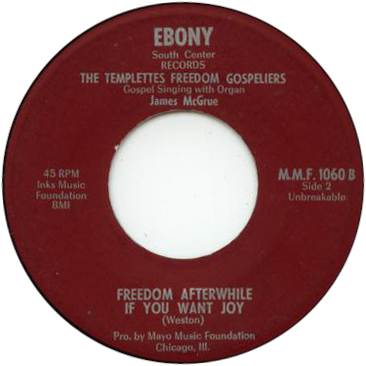
Mayo Williams advertised this release not as a display ad, but in the classified ad section of the February 6, 1965 Chicago Defender. He called the group the Templettes Freedom Singers, and said all four songs were available on an LP for one dollar. It was actually an EP, although that format had largely died out by this time. The ad marketed the record to "civil rights and freedom organizations" at a 20 percent discount.
There is a second version of the Templettes EP. To be filled in.
Sandy Paget (voc) with Mace Morgan (org); others unidentified.
Chicago, 1960s
| That Great Street - State Street Shake That Thing | Ebony 1000 A | ||
| That Great Street - State Street Shake That Thing | Ebony 1000 B |
Still another Ebony 1000 (!!!), released on 45, featured one Sandy Paget, née Sylvia Poulos, who according to Mayo Williams' overheated publicity was discovered and recorded not long after her graduation from Austin High School. Apparently "That Great Street" was presented in two parts, although there is no Part 1 or 2 designation on the labels. Mace Morgan was credited, however, along with other groups not otherwise specified. The involvement of the Thunderbirds and the presence of a male vocalist on one side raises the possiblity of some connection with the 1962 EP that Mayo Williams tried so hard to promote, but more research is needed on that. The Paget seems to have been a relatively late release on Ebony IV, judging from the production credit to the Mayo Music Foundation, and the joint music publishing credit to Inks Music Foundation.
The alternative release on "Chicago Iz" (an imprint that Williams probably tried on a one-time basis) was recently reported by Mike Atherton. It also carries the Mayo and Inks Music Foundation credits. What makes the Chicago Iz version special is the picture sleeve that Wiliams had printed for it.
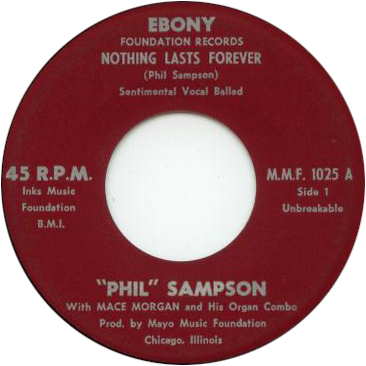
Phil Sampson (voc); Mace Morgan (org); others unidentified.
Chicago, 1960s
| Nothing Lasts Forever (Sampson) | Ebony M. M. F. 1025 A | ||
| Bring My Baby Back (Sampson) | Ebony M. M. F. 1025 B |
Another late release, with production credit to Mayo Music Foundation and publishing credit to Inks Music Foundation. However, now Foundation apeears as part of the company logo, and the release number carries an M. M. F. prefix.
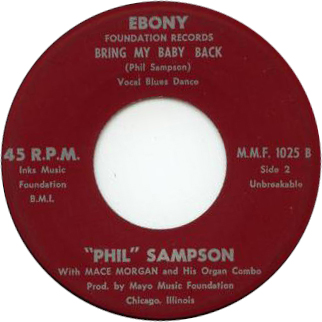
The Battle-Aires: singers unidentified; with John Scott (g).
Chicago, 1959 or 1960
| Two Little Fishes (trad.) | Ebony M. M. F. 103 A [EP] | ||
| Leaning on the Lord (trad.) | Ebony M. M. F. 103 A [EP] | ||
| Please Answer Me (trad.) | Ebony M. M. F. 103 B [EP] | ||
| When I Get Home (trad.) | Ebony M. M. F. 103 B [EP] |
This gospel EP shows the "Our Ebony" logo that was also used on the Archie Taylor release. It also carries the old High-Fidelity descriptor. However, it carries a credit to the Mayo Music Foundation as many later releases would, and an M. M. F. prefix.
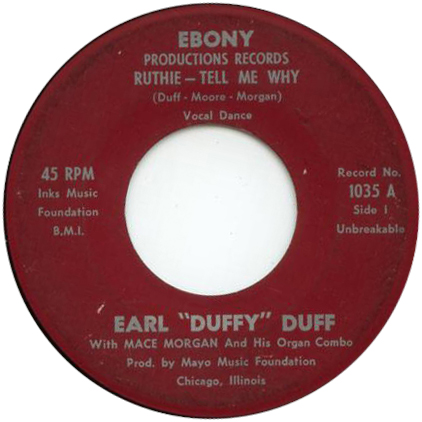
Earl Duff (voc); Mace Morgan (org); others unidentified.
Chicago, 1960s
| Ruthie - Tell Me Why (Duff-Moore-Morgan) | Ebony 1035 A | ||
| Little Girl - I Dig Your Ways (Duff-Moore-Morgan) | Ebony 1035 B |
This release mentions the Mayo Music Foundation and Inks Music Foundation, but does not use the M. M. F. prefix and identifies the company as Ebony Productions. Titles and lineup suggest a soul outing.
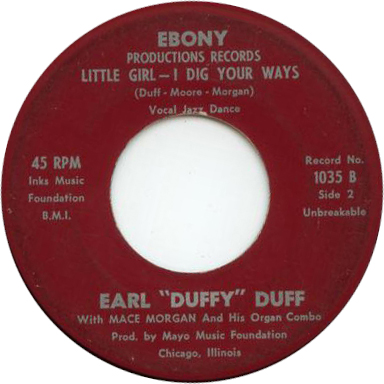
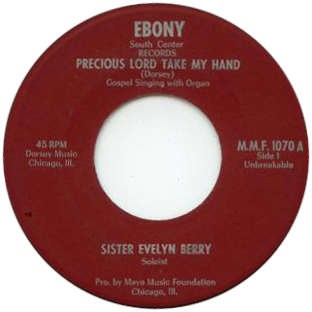
Sister Evelyn Berry (voc); unidentified (org).
Chicago, 1960s.
| Precious Lord Take My Hand (Berry) | Ebony M. M. F. 1070 A | ||
| Jesus Is Coming (Berry) | Ebony M. M. F. 1070 B |
About Sister Evelyn Berry we have much to learn. Her single is listed in Hayes and Laughton's Gospel Discography, which otherwise emits the plaintive cry, "no details."
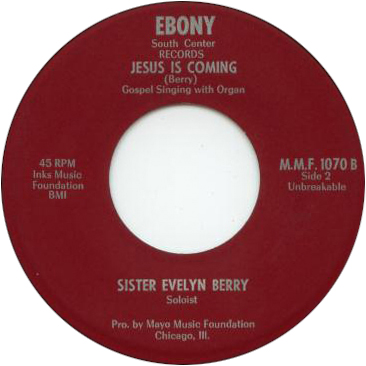
Lil Armstrong (voc, p); other musicians unidentified ^
prob. Chicago, unknown date
Louis Armstrong (voc, tp) with the Mills Brothers: Harry Mills (baritone); Herbert Mills (tenor); Donald Mills (tenor); John Mills (bass, g).%
New York, April 7, 1937
| EB-1010-A | I Can't Dance with Ants in My Pants ^ | Ebony 1010-A | |
| EB-1010-B | Darling Nellie Gray % | Ebony 1010-B |
This record is not listed in Lord's Jazz Discography. Clearly, however, Williams was, er, going back to well, using masters that he had produced while running the race department at Decca.
"Darling Nellie Gray" in fact features Louis Armstrong with the Mills Brothers, doing vocal imitations of instruments. It was part of a two-tune studio session. Two takes of "Darling Nellie" were made, 62117-A and 62117-B; both initially appeared on Decca 1245. Which take Williams decided to reissue, and whether he doctored the sonics, remain to be researched.
All told, Lil Armstrong recorded six sessions for Decca between 1936 and 1940. None of the sides listed in Lord was titled "I Can't Dance with Ants in My Pants," but a number with that title was extant in the mid-1930s, when it was recorded by such artists as Valaida Snow and Freddie Jenkins. We don't know whether Williams pulled out an unreleased side for Ebony 1010 or slapped a new title on something that had seen release on Decca. See above for what may be another issue of this side.
In March 1968, Mayo Williams lost his wife of many decades, Aleta S. Williams, who died while in a convalescent home. The couple had been living at 4906 South Drexel. In the Chicago Defender death announcement, J. Mayo Williams was identified as a phonograph record producer.
The May 27, 1969 edition of the Chicago Defender ran an "Inquiring Reporter" column in which two of the four people asked about a current event had some connection with the Williams operation: Little Brother Montgomery (described as a recording artist) and Bob Camp (line of work identified as sound service). Also interviewed was Little Brother Montgomery's second wife, who was described as an office manager. As we have learned from George Paulus' reminiscences, Montgomery was a good friend of Williams and hung out regularly at the Ebony office.
The late George Paulus and Jim O'Neal interviewed Williams in 1972. Here are George's reminiscences about meeting J. Mayo Williams:
I had heard from a well known vintage 78 dealer who had scored somewhere around 150 shellac blues tests from Mayo. The cache of 78s was said to be in near-mint condition. I had hoped that by some chance or mistake something interesting was left behind.
I found Mayo's number in the phone book and rang him up. He answered cordially and gave me an appointment at his office for 11am late in the week. As I remember the area in was in the heart of Bronzeville on Chicago’s South Side. My memory tells me it was somewhere between 43rd and 47th street on Cottage Grove [417 East 47th Street, to be exact].
It was in a huge brown brick building with dark varnished wooden doors and frosted glass windows. The name Ebony Records was emblazoned in black and gold on the frosty pane. I knocked and was let in by a middle-aged black man who told me Mr. Williams would be up in a minute.
Mayo waked over within a few minutes and cordially greeted me. He was a short stout dignified man attired in suit and tie. He introduced me to Little Brother Montgomery, who was sitting off to the side at a large desk with a deck of cards, a glass of whiskey and a lit cigar. Brother nodded affably and puffed his cigar.
Mayo chatted warmly with this then 20-year-old blues collector as though he was talking a business deal with an equal. He mentioned that all the shellac tests had been bought by the other collector. He seemed surprised that anyone really wanted that old stuff. He mentioned a bit about himself as an avid football player in college and his nickname "Ink," because of his skin color.
I told him about my passion for the 20s blues guitar players and the romantic names. Mayo replied that he never liked going to "the bottom." He calmly stated that he went to those low-class areas in the days when he worked at Paramount. A man could easily get shot there, robbed, anything could happen. Mayo preferred the Ma Rainey style of blues that featured a real orchestra with singers who had better diction and could really sing.
"Those low-down country guys," he said, "could play a few numbers and then they weren't good for nothing. Blind Lemon froze to death in a hallway. They were just drunken, low-down guys. They weren't people I wanted to hang around with for more than it took to do my business. I'm not a country blues fan," he declared. Brother nodded in agreement at certain points while puffing away. I stated that I loved Delta blues more than anything. Mayo seemed artistically baffled.
Mayo apologized that he had nothing for me. Since collectors relied strictly on word of mouth at the time, I had little knowledge of his output on Ebony during the 1950s. I have vague memories of asking about any down-home blues and he probably said it was all gone and simply didn't sell much.
There are rumors of stacks of Ebony 45s /78s turning up in the 70s as they were dumped at various Chicago locations. The rumors are false. From the mid 60s through mid 70s I hit most black record stores and various distributors and rarely saw Ebony 45s or 78s. Ebonys were never easy finds. One 45 turned up in a quantity of 9 records. The only Ebony 45s to turn up with some regularity, meaning 2 or 3 at a time, were from the 1960s. These later 45s [the Ebony IIIs] bore little if any resemblance to the 50s gems. They featured overdubbed Sleepy John Estes (from a Decca session) and fifth-rate soul/blues chicks or lounge bands. They were so poor I never filed them in my collection. The 50s Ebony releases [the Ebony IIs] were always rare and I suspect were never pressed in large quantities.
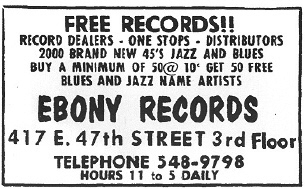
By now, Williams was no longer making new records and was sitting on a fair amount of excess stock, consisting of poorly distributed disks in dated musical styles. (What remained basically consisted of recent Ebony IIIs—collectors had already cleared out the Ebony IIs.) In the Chicago Defender of March 28, 1973, he advertised "Free Records" for dealers, one stops, and distributors, giving them a deal where if they bought a minimum of fifty at 10 cents each, they would get another 50 free. We very much doubt that he was able to move some boxes and unclog some shelves. Certainly the distributors wouldn't have recognized most of his "name artists." A couple of years later, George Paulus was able to pick up 9 copies of an Ebony II, the Birmingham Junior record (Ebony 1007), but we have heard no other authenticated reports of such a multiple-copy find.
Williams subsequently retired for reasons of health, dying in Chicago on January 2, 1980. On his death certificate, his occupation was listed as "recorder" and under kind of business was listed "Ebony Recordings."